Motorola Mobility T6CC1 PCS GSM Portable Transceiver User Manual CC EX08
Motorola Mobility LLC PCS GSM Portable Transceiver CC EX08
Exhibit 8 Users Manual

APPLICANT: MOTOROLA, INC. FCC ID: IHDT6CC1
EXHIBIT 8
INSTRUCTION MANUAL
A preliminary draft copy of the Users Manual follows:
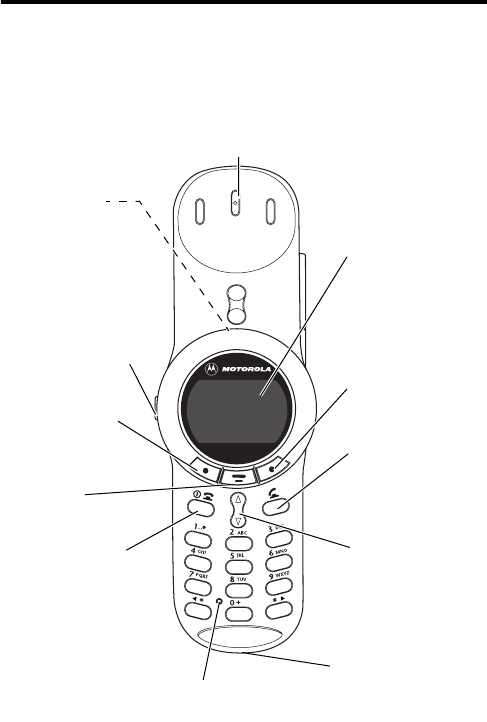
1
Welcome
Welcome to the world of Motorola digital wireless
communications! We are pleased that you have chosen the
Motorola V70 wireless phone.
Earpiece
Headset Jack
Insert headset
accessory for
hands-free use.
Volume Key
Adjust earpiece
and ringer volume.
Display
Accessory
Connector Port
Insert charger and
phone accessories.
Right Soft Key
Perform functions
identified by right
display prompt.
Menu Key
Power/End Key
Press & hold to power
phone on & off.
Press & release to end
phone calls,exit menu
system.
Send Key
Send and answer
calls, view recent
dialed calls list.
Navigation Keys
Scroll through
menus and lists,
set feature values.
Left Soft Key
Perform functions
identified by left
display prompt.
Microphone
User.Guide.GSM.book Page 1 Wednesday, January 9, 2002 2:30 PM
2
Personal Communications Sector
600 North U.S. Highway 45
Libertyville, Illinois 60048
1-800-331-6456 (United States)
1-888-390-6456 (TTY/TDD United States)
1-800-461-4575 (Canada)
www.motorola.com
(United States)
www.motorola.ca
(Canada)
MOTOROLA, the Stylized M Logo and all other trademarks indicated as
such herein are trademarks of Motorola, Inc. ® Reg. U.S. Pat. & Tm. Off.
TrueSync, Sidekick, Starfish and the Stylized Starfish Logo are registered
trademarks of Starfish Software, Inc., a wholly owned independent
subsidiary of Motorola, Inc. All other product or service names are the
property of their respective owners.
© 2001 Motorola, Inc. All rights reserved. Printed in the U.S.A.
Software Copyright Notice
The Motorola products described in this manual may include
copyrighted Motorola and third party software stored in semiconductor
memories or other media. Laws in the United States and other countries
preserve for Motorola and third party software providers certain
exclusive rights for copyrighted software, such as the exclusive rights to
distribute or reproduce the copyrighted software. Accordingly, any
copyrighted software contained in the Motorola products may not be
modified, reverse-engineered, distributed, or reproduced in any manner
to the extent allowed by law. Furthermore, the purchase of the
Motorola products shall not be deemed to grant either directly or by
implication, estoppel, or otherwise, any license under the copyrights,
patents, or patent applications of Motorola or any third party software
provider, except for the normal, non-exclusive, royalty-free license to use
that arises by operation of law in the sale of a product.
Manual number:
Cover number:
User.Guide.GSM.book Page 2 Wednesday, January 9, 2002 2:30 PM

✂
3
Menu Map
Main Menu
• Recent Calls
• Received Calls
• Dialed Calls
• Notepad
• Call Times
• Call Cost
• Service Dial
• Fixed Dial
• Phonebook
• Datebook
• Quick Dial
• Messages
• Voicemail
• Text Msgs
• Browser Alerts
• Info Services
• Quick Notes
• Outbox
• Drafts
• Shortcuts
• Voice Dial
• SIM Applications
• Browser
• Calculator
• Games
• Settings
(see next page)
Note:
This is the standard phone
menu layout. You or your service
provider may have changed the
menu layout or changed some
feature names. Not all features
may be available for all users.
Shortcuts
Change display zoom:
Press
M
, then press and
hold
M
Display my phone number:
Press
M
#
Go to dialed calls list:
Press
N
Exit menu system:
Press
O
User.Guide.GSM.book Page 3 Wednesday, January 9, 2002 2:30 PM

✂
4
Settings Menu
• Ring/Vibrate
• Alert
•
Alert
Detail
• My Tones
• Call Forward
• Voice Calls
• Fax Calls
• Data Calls
• Cancel All
• Forward Status
• Phone Status
• My Tel. Numbers
• Credit Info/Available
• Active Line
• Battery Meter
• Other Information
• Browser Setup
• In-Call Setup
• In-Call Timer
• Call Cost Setup
• My Caller ID
• Talk and Fax
• Answer Options
• Call Waiting
• Security
• Phone Lock
• Lock Application
• Fixed Dial
• Call Barring
• SIM Pin
• New Passwords
• Other Settings
• Personalize
• Main Menu
• Keys
• Greeting
• Quick Dial
• Initial Setup
• Time and Date
• 1-Touch Dial
• Backlight
• Zoom
• Scroll
• Animation
• Language
• Battery Save
• Contrast
• DTMF
• Master Reset
• Master Clear
• Network
• Car Settings
• Headset
User.Guide.GSM.book Page 4 Wednesday, January 9, 2002 2:30 PM

5
Contents
Menu Map
. . . . . . . . . . . . . . . . . . . . . . . . . . . . . . . . . . . . . . 3
About This Guide
. . . . . . . . . . . . . . . . . . . . . . . . . . . . . . . 10
Safety and General Information
. . . . . . . . . . . . . . . . . . . 12
Getting Started
. . . . . . . . . . . . . . . . . . . . . . . . . . . . . . . . 19
What’s in the Box? . . . . . . . . . . . . . . . . . . . . . . . . . . . . . 19
Installing the SIM Card and Battery . . . . . . . . . . . . . . . . . 19
Charging the Battery . . . . . . . . . . . . . . . . . . . . . . . . . . . . 22
Turning Your Phone On . . . . . . . . . . . . . . . . . . . . . . . . . . 23
Sending a Call . . . . . . . . . . . . . . . . . . . . . . . . . . . . . . . . . 25
Ending a Call . . . . . . . . . . . . . . . . . . . . . . . . . . . . . . . . . . 25
Receiving a Call . . . . . . . . . . . . . . . . . . . . . . . . . . . . . . . . 26
Displaying Your Phone Number . . . . . . . . . . . . . . . . . . . . 26
About Your Phone
. . . . . . . . . . . . . . . . . . . . . . . . . . . . . . 27
Display . . . . . . . . . . . . . . . . . . . . . . . . . . . . . . . . . . . . . . 27
Changing the Zoom Setting . . . . . . . . . . . . . . . . . . . . . . . 30
Adjusting Volume . . . . . . . . . . . . . . . . . . . . . . . . . . . . . . 31
Battery Use . . . . . . . . . . . . . . . . . . . . . . . . . . . . . . . . . . . 33
Sending and Receiving Calls
. . . . . . . . . . . . . . . . . . . . . . 35
Redialing a Number . . . . . . . . . . . . . . . . . . . . . . . . . . . . . 35
Using Automatic Redial . . . . . . . . . . . . . . . . . . . . . . . . . . 35
Caller ID . . . . . . . . . . . . . . . . . . . . . . . . . . . . . . . . . . . . . 36
Line Security . . . . . . . . . . . . . . . . . . . . . . . . . . . . . . . . . . 37
Returning an Unanswered Call . . . . . . . . . . . . . . . . . . . . . 37
Dialing an Emergency Number . . . . . . . . . . . . . . . . . . . . . 38
Entering Numbers in the Notepad . . . . . . . . . . . . . . . . . . 38
Terminating an Incoming Call . . . . . . . . . . . . . . . . . . . . . . 39
Dialing With Speed Dial . . . . . . . . . . . . . . . . . . . . . . . . . . 39
Dialing With 1-Touch Dial . . . . . . . . . . . . . . . . . . . . . . . . 40
User.Guide.GSM.book Page 5 Wednesday, January 9, 2002 2:30 PM

Contents
6
Dialing a Number in a Text Message . . . . . . . . . . . . . . . . 40
Additional Dialing Features . . . . . . . . . . . . . . . . . . . . . . . 41
Using Features While On a Call
. . . . . . . . . . . . . . . . . . . 44
Using Call Waiting . . . . . . . . . . . . . . . . . . . . . . . . . . . . . . 44
Making a Conference Call . . . . . . . . . . . . . . . . . . . . . . . . 45
Transferring a Call . . . . . . . . . . . . . . . . . . . . . . . . . . . . . . 46
Additional On-Call Features . . . . . . . . . . . . . . . . . . . . . . . 48
Using the Menu
. . . . . . . . . . . . . . . . . . . . . . . . . . . . . . . . 49
Navigating to a Feature . . . . . . . . . . . . . . . . . . . . . . . . . . 49
Selecting a Feature . . . . . . . . . . . . . . . . . . . . . . . . . . . . . 50
Entering Feature Information . . . . . . . . . . . . . . . . . . . . . . 51
Entering Text
. . . . . . . . . . . . . . . . . . . . . . . . . . . . . . . . . . . 53
Choosing a Text Mode . . . . . . . . . . . . . . . . . . . . . . . . . . . 53
Tap Method . . . . . . . . . . . . . . . . . . . . . . . . . . . . . . . . . . . 54
Symbol Mode . . . . . . . . . . . . . . . . . . . . . . . . . . . . . . . . . 57
Predictive Text Entry with iTAP™ Software . . . . . . . . . . . . 58
Menu Feature Descriptions
. . . . . . . . . . . . . . . . . . . . . . . 63
Recent Calls
. . . . . . . . . . . . . . . . . . . . . . . . . . . . . . . . . . . 79
Viewing the Received Calls or Dialed Calls List . . . . . . . . . 79
Using the Notepad . . . . . . . . . . . . . . . . . . . . . . . . . . . . . 82
Viewing and Resetting Call Timers . . . . . . . . . . . . . . . . . . 83
Viewing and Resetting Call Costs . . . . . . . . . . . . . . . . . . . 85
Phonebook
. . . . . . . . . . . . . . . . . . . . . . . . . . . . . . . . . . . . 87
Fields in a Phonebook Entry Form . . . . . . . . . . . . . . . . . . 87
Storing a Phonebook Entry . . . . . . . . . . . . . . . . . . . . . . . 88
Recording a Voice Name For a Phonebook Entry . . . . . . . . 91
Dialing a Phonebook Entry . . . . . . . . . . . . . . . . . . . . . . . . 92
Editing a Phonebook Entry . . . . . . . . . . . . . . . . . . . . . . . . 94
Deleting a Phonebook Entry . . . . . . . . . . . . . . . . . . . . . . . 95
User.Guide.GSM.book Page 6 Wednesday, January 9, 2002 2:30 PM

7
Contents
Copying Phonebook Entries Between the Phone and SIM Card
95
Checking Phonebook Capacity . . . . . . . . . . . . . . . . . . . . . 99
Synchronizing with TrueSync Software . . . . . . . . . . . . . . . 99
Setting Up the Phonebook . . . . . . . . . . . . . . . . . . . . . . . 100
Datebook
. . . . . . . . . . . . . . . . . . . . . . . . . . . . . . . . . . . . . 102
Week View . . . . . . . . . . . . . . . . . . . . . . . . . . . . . . . . . . 102
Day View . . . . . . . . . . . . . . . . . . . . . . . . . . . . . . . . . . . . 103
Event View . . . . . . . . . . . . . . . . . . . . . . . . . . . . . . . . . . 103
Storing a New Event . . . . . . . . . . . . . . . . . . . . . . . . . . . 104
Changing Event Information . . . . . . . . . . . . . . . . . . . . . 105
Copying an Event . . . . . . . . . . . . . . . . . . . . . . . . . . . . . 106
Deleting an Event . . . . . . . . . . . . . . . . . . . . . . . . . . . . . 107
Radio
. . . . . . . . . . . . . . . . . . . . . . . . . . . . . . . . . . . . . . . . 108
Turning the Radio On and Off . . . . . . . . . . . . . . . . . . . . 108
Tuning a Station . . . . . . . . . . . . . . . . . . . . . . . . . . . . . . 108
Storing a Preset . . . . . . . . . . . . . . . . . . . . . . . . . . . . . . . 109
Selecting a Preset . . . . . . . . . . . . . . . . . . . . . . . . . . . . . 109
Sending and Receiving Calls With the Radio On . . . . . . . 109
Messages—Voicemail
. . . . . . . . . . . . . . . . . . . . . . . . . . 111
Storing Your Voicemail Number . . . . . . . . . . . . . . . . . . . 111
Receiving a New Voicemail Message . . . . . . . . . . . . . . . 111
Listening to a Voicemail Message . . . . . . . . . . . . . . . . . . 112
Messages—Text
. . . . . . . . . . . . . . . . . . . . . . . . . . . . . . . 113
Setting Up the Text Message Inbox . . . . . . . . . . . . . . . . . 113
Receiving a Text Message . . . . . . . . . . . . . . . . . . . . . . . 115
Reading, Locking, or Deleting a Text Message . . . . . . . . . 115
Sending a Text Message . . . . . . . . . . . . . . . . . . . . . . . . . 117
Viewing the Status of Sent Text Messages . . . . . . . . . . . 119
User.Guide.GSM.book Page 7 Wednesday, January 9, 2002 2:30 PM

Contents
8
Shortcuts
. . . . . . . . . . . . . . . . . . . . . . . . . . . . . . . . . . . . . 120
Standard Shortcuts . . . . . . . . . . . . . . . . . . . . . . . . . . . . 120
User-Settable Shortcuts . . . . . . . . . . . . . . . . . . . . . . . . . 120
Creating a Shortcut . . . . . . . . . . . . . . . . . . . . . . . . . . . . 121
Using Shortcuts . . . . . . . . . . . . . . . . . . . . . . . . . . . . . . . 122
Micro-Browser
. . . . . . . . . . . . . . . . . . . . . . . . . . . . . . . . 123
Starting a Micro-Browser Session . . . . . . . . . . . . . . . . . . 123
Interacting With Web Pages . . . . . . . . . . . . . . . . . . . . . . 124
Calculator
. . . . . . . . . . . . . . . . . . . . . . . . . . . . . . . . . . . . 125
Calculating Numbers . . . . . . . . . . . . . . . . . . . . . . . . . . . 125
Converting Currency . . . . . . . . . . . . . . . . . . . . . . . . . . . 127
Games
. . . . . . . . . . . . . . . . . . . . . . . . . . . . . . . . . . . . . . . 128
Selecting and Starting a New Game . . . . . . . . . . . . . . . . 128
Ending a Game . . . . . . . . . . . . . . . . . . . . . . . . . . . . . . . 129
Playing a Game . . . . . . . . . . . . . . . . . . . . . . . . . . . . . . . 129
Adjusting Your Settings
. . . . . . . . . . . . . . . . . . . . . . . . . 133
Ring/Vibrate . . . . . . . . . . . . . . . . . . . . . . . . . . . . . . . . . 133
Reminders . . . . . . . . . . . . . . . . . . . . . . . . . . . . . . . . . . . 140
Call Forwarding . . . . . . . . . . . . . . . . . . . . . . . . . . . . . . . 141
Reordering Menu Items . . . . . . . . . . . . . . . . . . . . . . . . . 143
Customizing a Soft Key Function . . . . . . . . . . . . . . . . . . 144
Hands-Free Use . . . . . . . . . . . . . . . . . . . . . . . . . . . . . . . 144
Data and Fax Calls
. . . . . . . . . . . . . . . . . . . . . . . . . . . . . 148
Connecting Your Phone to an External Device . . . . . . . . 149
Sending a Data or Fax Call . . . . . . . . . . . . . . . . . . . . . . . 150
Receiving a Data or Fax Call . . . . . . . . . . . . . . . . . . . . . 151
Sending a Talk then Fax Call . . . . . . . . . . . . . . . . . . . . . 152
Security
. . . . . . . . . . . . . . . . . . . . . . . . . . . . . . . . . . . . . . 153
Assigning a New Code or Password . . . . . . . . . . . . . . . . 153
User.Guide.GSM.book Page 8 Wednesday, January 9, 2002 2:30 PM

9
Contents
If You Forget a Code or Password . . . . . . . . . . . . . . . . . . 155
Locking and Unlocking Your Phone . . . . . . . . . . . . . . . . 155
Barring Calls . . . . . . . . . . . . . . . . . . . . . . . . . . . . . . . . . 157
Protecting the SIM Card . . . . . . . . . . . . . . . . . . . . . . . . . 158
Troubleshooting
. . . . . . . . . . . . . . . . . . . . . . . . . . . . . . . 160
Product Registration
. . . . . . . . . . . . . . . . . . . . . . . . . . . 169
Export Law Assurances
. . . . . . . . . . . . . . . . . . . . . . . . . 169
Specific Absorption Rate Data
. . . . . . . . . . . . . . . . . . . 170
Index
. . . . . . . . . . . . . . . . . . . . . . . . . . . . . . . . . . . . . . . . 172
Wireless Phone Safety Tips
. . . . . . . . . . . . . . . . . . . . . . 185
User.Guide.GSM.book Page 9 Wednesday, January 9, 2002 2:30 PM

10
About This Guide
Using Your Phone’s Features
This user guide introduces you to the many features in your
Motorola V70 phone. A reference guide for your phone is also
available that explains the phone’s features in more detail. To
obtain a copy of the reference guide or another copy of this user
guide, see the Motorola Web site at:
http://motorola.com/consumer/manuals
(United States)
http://www.motorola.ca/manuals
(Canada)
or contact the Motorola Customer Call Center at
1-800-331-6456 in the United States or 1-800-461-4575 in
Canada.
Navigating To a Menu Feature
You can access many of your phone’s features through the menu
system. This guide shows you how to navigate to a specific menu
feature as follows:
The > symbol means that you should scroll to and select the
feature. This example shows that you must press M
, scroll to
and select
Recent Calls
, then scroll to and select
Dialed Calls
to view the dialed calls list.
Find the Feature
M
>
Recent Calls
>
Dialed Calls
User.Guide.GSM.book Page 10 Wednesday, January 9, 2002 2:30 PM

11
About This Guide
Optional Features
Features marked with this label are optional network,
SIM card, and/or subscription-dependent features.
These features may not be offered by all service
providers in all geographical areas. Contact your
service provider for information about availability.
Optional Accessories
Features marked with this label require the use of an
optional Motorola Original™ accessory.
User.Guide.GSM.book Page 11 Wednesday, January 9, 2002 2:30 PM

12
Safety and General
Information
IMPORTANT INFORMATION ON SAFE AND EFFICIENT
OPERATION. READ THIS INFORMATION BEFORE USING YOUR
PHONE.
RF Operational Characteristics
Your phone contains a transmitter and a receiver. When it is ON,
it receives and transmits radio frequency (RF) energy. The phone
operates in the frequency range of xx through xx.
When you communicate with your phone, the system handling
your call controls the power levels at which your phone
transmits. The output power level typically may vary over a range
from xx watts to xx watts in analog mode and xx watts to xx
watts in digital mode.
Exposure To Radio Frequency Energy
Your Motorola phone is designed to comply with the following
national and international standards and guidelines regarding
exposure of human beings to radio frequency electromagnetic
energy (EME):
• United States Federal Communications Commission, Code
of Regulations; 47 CFR part 2 sub-part J
• American National Standards Institute (ANSI) / Institute of
Electrical and Electronic Engineers (IEEE) C95. 1-1992
• Institute of Electrical and Electronic Engineers (IEEE)
C95.1-1999 Edition
User.Guide.GSM.book Page 12 Wednesday, January 9, 2002 2:30 PM

13
Safety and General Information
• National Council on Radiation Protection and
Measurements (NCRP) of the United States, Report 86,
1986
• International Commission on Non-Ionizing Radiation
Protection (ICNIRP) 1998
• Ministry of Health (Canada) Safety Code 6. Limits of Human
Exposure to Radiofrequency Electromagnetic Fields in the
Frequency Range from 3 kHz to 300 GHz, 1999
• Australian Communications Authority
Radiocommunications (Electromagnetic Radiation-Human
Exposure) Standard 1999
To assure optimal phone performance and make sure human
exposure to radio frequency electromagnetic energy is within the
guidelines set forth in the above standards, always adhere to the
following procedures:
Portable Phone Operation and EME
Exposure
Antenna Care
Use only the supplied or an approved replacement
antenna.
Unauthorized antennas, modifications, or
attachments could damage the phone and may violate FCC
regulations.
Do NOT hold the antenna when the phone is in use.
Holding the antenna affects call quality and may cause the
phone to operate at a higher power level than needed.
User.Guide.GSM.book Page 13 Wednesday, January 9, 2002 2:30 PM

Safety and General Information
14
Phone Operation
When placing or receiving a phone call, hold your phone as you
would a wireline telephone.
Speak directly into the
microphone.
Body-Worn Operation
To maintain compliance with FCC/Health Canada RF exposure
guidelines, if you wear a phone on your body when transmitting,
always place the phone in a Motorola-supplied or approved
clip, holder, holster, case, or body harness for this
product. Use of non-Motorola-approved accessories may
exceed FCC/Health Canada RF exposure guidelines. If you do
not use a body-worn accessory, and are not holding the
phone in the normal use position at the ear, ensure the
phone and its antenna are at least one inch
(2.5 centimeters) from your body when transmitting.
Data Operation
When using any data feature of the phone, with or without an
accessory cable, position the phone and its antenna at
least one inch (2.5 centimeters) from your body.
Approved Accessories
For a list of approved Motorola accessories, visit our website at
www.motorola.com
.
User.Guide.GSM.book Page 14 Wednesday, January 9, 2002 2:30 PM

15
Safety and General Information
Electromagnetic Interference/
Compatibility
Note: Nearly every electronic device is susceptible to
electromagnetic interference (EMI) if inadequately shielded,
designed, or otherwise configured for electromagnetic
compatibility.
Facilities
To avoid electromagnetic interference and/or compatibility
conflicts, turn off your phone in any facility where posted notices
instruct you to do so. Hospitals or health care facilities may be
using equipment that is sensitive to external RF energy.
Aircraft
When instructed to do so, turn off your phone when on board an
aircraft. Any use of a phone must be in accordance with
applicable regulations per airline crew instructions.
Medical Devices
Pacemakers
The Advanced Medical Technology Association recommends that
a minimum separation of 6 inches (15 centimeters) be
maintained between a handheld wireless phone and a
pacemaker. These recommendations are consistent with the
independent research by, and recommendations of, the United
States Food and Drug Administration.
User.Guide.GSM.book Page 15 Wednesday, January 9, 2002 2:30 PM

Safety and General Information
16
Persons with pacemakers should:
• ALWAYS keep the phone more than six inches
(15 centimeters) from your pacemaker when the phone is
turned ON.
• NOT carry the phone in the breast pocket.
• use the ear opposite the pacemaker to minimize the
potential for interference.
• turn OFF the phone immediately if you have any reason to
suspect that interference is taking place.
Hearing Aids
Some digital wireless phones may interfere with some hearing
aids. In the event of such interference, you may want to consult
your hearing aid manufacturer to discuss alternatives.
Other Medical Devices
If you use any other personal medical device, consult the
manufacturer of your device to determine if it is adequately
shielded from RF energy. Your physician may be able to assist
you in obtaining this information.
Safety and General
Use While Driving
Check the laws and regulations on the use of phones in the area
where you drive. Always obey them.
When using your phone while driving, please:
User.Guide.GSM.book Page 16 Wednesday, January 9, 2002 2:30 PM

17
Safety and General Information
• give full attention to driving and to the road.
• use hands-free operation, if available.
• pull off the road and park before making or answering a
call if driving conditions so require.
Operational Warnings
For Vehicles With an Air Bag
Do not place a portable phone in the area over an air bag or in
the air bag deployment area. Air bags inflate with great force. If
a portable phone is placed in the air bag deployment area and
the air bag inflates, the phone may be propelled with great force
and cause serious injury to occupants of the vehicle.
Potentially Explosive Atmospheres
Turn off your phone prior to entering any area with a potentially
explosive atmosphere, unless the phone is a model specifically
identified as being “Intrinsically Safe.” Do not remove, install, or
charge batteries in such areas. Sparks in a potentially explosive
atmosphere can cause an explosion or fire resulting in bodily
injury or even death.
Note: The areas with potentially explosive atmospheres referred
to above include fueling areas such as below decks on boats,
fuel or chemical transfer or storage facilities, areas where the air
contains chemicals or particles, such as grain, dust, or metal
powders, and any other area where you would normally be
advised to turn off your vehicle engine. Areas with potentially
explosive atmospheres are often but not always posted.
User.Guide.GSM.book Page 17 Wednesday, January 9, 2002 2:30 PM

Safety and General Information
18
Blasting Caps and Areas
To avoid possible interference with blasting operations, turn OFF
your phone when you are near electrical blasting caps, in a
blasting area, or in areas posted: “Turn off two-way radio.” Obey
all signs and instructions.
Operational Cautions
Antennas
Do not use any portable phone that has a damaged
antenna. If a damaged antenna comes into contact with your
skin, a minor burn can result.
Batteries
All batteries can cause property damage and/or bodily injury
such as burns if a conductive material such as jewelry, keys, or
beaded chains touches exposed terminals. The conductive
material may complete an electrical circuit (short circuit) and
become quite hot. Exercise care in handling any charged battery,
particularly when placing it inside a pocket, purse, or other
container with metal objects.
ITC01-076
User.Guide.GSM.book Page 18 Wednesday, January 9, 2002 2:30 PM

19
Getting Started
What’s in the Box?
Your digital wireless phone typically comes equipped with a
battery and a charger. Other accessory options can customize
your phone for maximum performance and portability.
To purchase Motorola Original™ accessories, please contact the
Motorola Customer Call Center at 1-800-331-6456 in the
United States or 1-800-461-4575 in Canada.
Installing the SIM Card and Battery
Before you can use your phone, you need to install and charge
the battery.
Your phone is designed to be used only with Motorola
Original batteries and accessories. We recommend that
you store batteries in their protective cases when not
in use.
Your SIM (Subscriber Identity Module) card contains your phone
number, service details, and phonebook/message memory. It
must be installed in the base of the phone.
Caution: Do not bend or scratch your SIM card. Avoid exposing
your SIM card to static electricity, water, or dirt.
User.Guide.GSM.book Page 19 Wednesday, January 9, 2002 2:30 PM
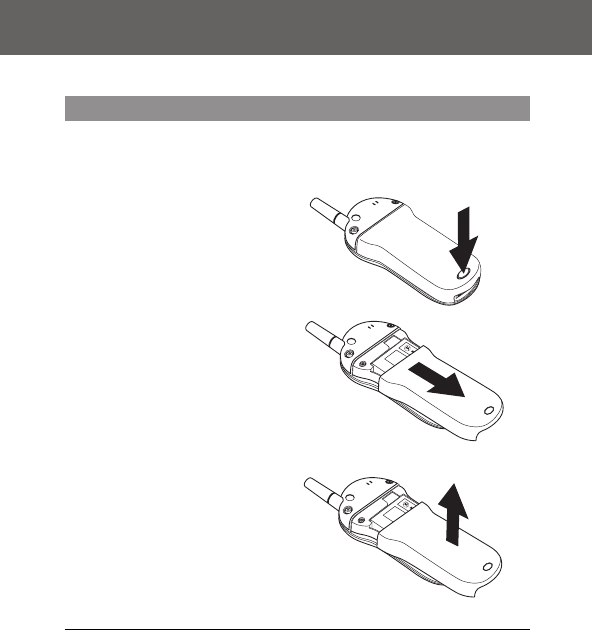
Getting Started
20
Step
1
Remove the back cover
of the phone:
a
While pressing the
release button at
the bottom of the
cover, slide the
cover downward.
b
Pull the cover
away from the
base.
User.Guide.GSM.book Page 20 Wednesday, January 9, 2002 2:30 PM
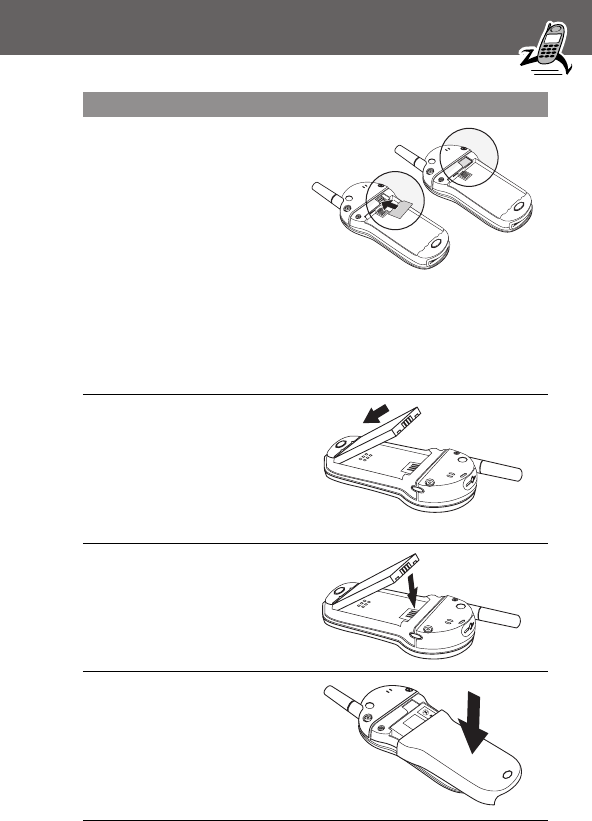
21
Getting Started
2
Insert the SIM card,
with the notch at the
upper right and the
gold plate downward,
into the SIM slot
(located above the
battery compartment).
When the SIM card is
properly positioned, the
battery compartment
terminals are visible.
3
Install the battery by
inserting the tabs at
the base of the battery
into the slots at the
bottom of the battery
compartment.
4
Push the battery down
and snap it into place.
5
Re-install the back
cover by aligning the
cover about 1/2 inch
down on base and
fitting the cover onto
the base.
Step
a
b
User.Guide.GSM.book Page 21 Wednesday, January 9, 2002 2:30 PM
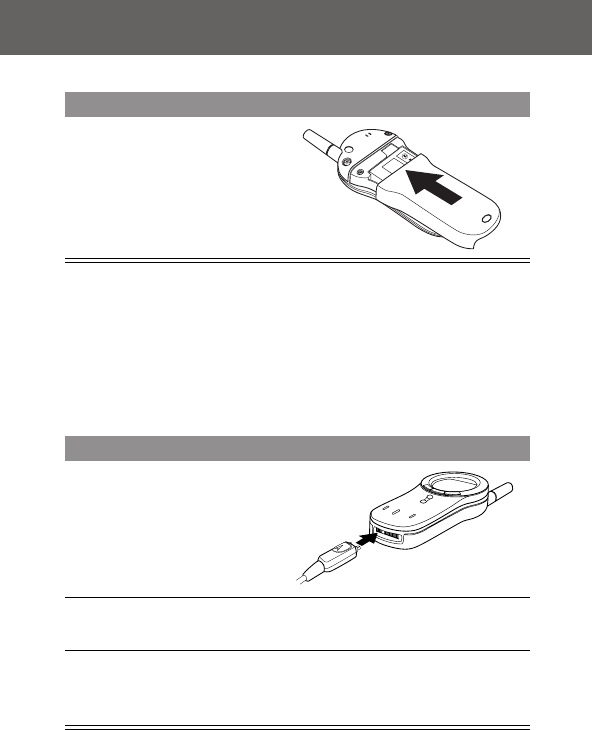
Getting Started
22
Charging the Battery
New batteries are shipped partially charged. Before you can use
your phone, you need to install and charge the battery, as
indicated by the following instructions. Some batteries perform
best after several full charge/discharge cycles.
6
Push down on the
cover while sliding it
upward into position.
Step
1
Plug the travel charger
into the phone with the
release tabs facing up.
2
Plug the other end of the travel charger into the
appropriate electrical outlet.
3
When your phone indicates that the battery is fully
charged (Charge Complete), press the release tab and
remove the travel charger.
Step
User.Guide.GSM.book Page 22 Wednesday, January 9, 2002 2:30 PM
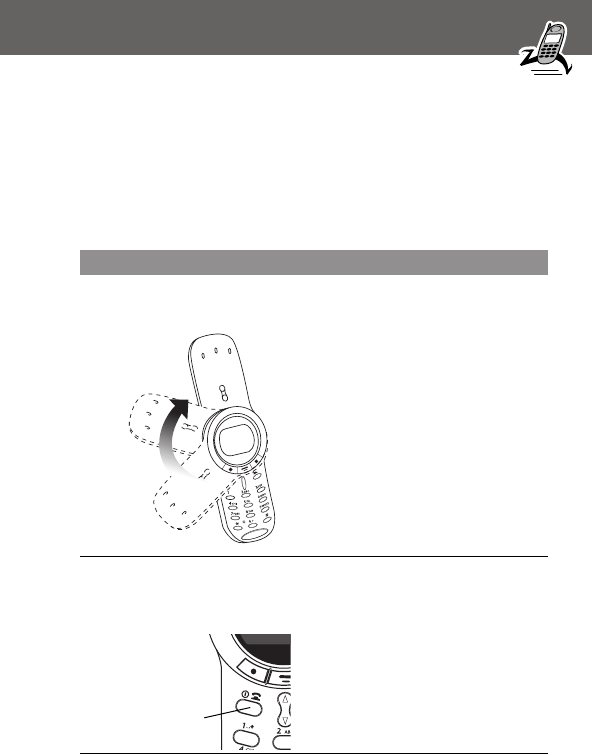
23
Getting Started
Note: When you charge the battery, the battery level indicator in
the upper right corner of the display shows how much of the
charging process is complete. See the “Battery Level Indicator”
item on page 29.
Turning Your Phone On
Step Result
1
Open your
phone
expose the keypad
2
Press and hold O
(the End/Power
key)
turn on your phone
End/
Power Key
User.Guide.GSM.book Page 23 Wednesday, January 9, 2002 2:30 PM

Getting Started
24
3
If necessary, enter
your SIM card PIN
code and press
OK (J)
unlock your SIM card
Caution: If you enter an
incorrect PIN code three times in
a row, your SIM card is disabled
and your phone displays the
message SIM Blocked. (For more
information, see “Protecting the
SIM Card” on page 158.)
4
If necessary, enter
your four-digit unlock
code and press
OK (J)
unlock your phone
The unlock code is originally set
to 1234. (For more information,
see “Locking and Unlocking Your
Phone” on page 155.)
Step Result
User.Guide.GSM.book Page 24 Wednesday, January 9, 2002 2:30 PM

25
Getting Started
Sending a Call
To call a number, your phone:
• must be rotated completely open to expose the keypad
• must be turned on
• must have a SIM card inserted and unlocked
• must have a network connection with adequate signal
strength
Note: You can make an emergency call even when the phone is
locked, or when a SIM card is not inserted. See “Dialing an
Emergency Number” on page 38.
Ending a Call
Press To
1
keypad keys dial the phone number (up to 32
digits)
Tip: If you make a mistake, press
DELETE (L) to delete the last
digit, or press and hold
DELETE (L) to clear all digits.
2
N (send key) send the call
Press To
O (end key) end the call
User.Guide.GSM.book Page 25 Wednesday, January 9, 2002 2:30 PM

Getting Started
26
Receiving a Call
To receive a call, your phone:
• must be rotated completely open to expose the keypad or
have a headset (an optional accessory) plugged in
• must be turned on
• must have a SIM card inserted and unlocked
• must have a network connection with adequate signal
strength
If your phone is locked, you must unlock it to answer the call.
Note: Your phone cannot receive calls when your SIM card is
locked.
When you receive a call, your phone rings and/or vibrates and
displays an incoming call message.
Displaying Your Phone Number
From the idle display:
Note: Your phone number must be programmed on your SIM
card in order to use this feature.
Press To
N or ANSWER (J) answer the call
Press To
M #see your phone number
User.Guide.GSM.book Page 26 Wednesday, January 9, 2002 2:30 PM

27
About Your Phone
See page 1 for a diagram of your phone that describes basic
phone components.
Display
The top section of the display shows phone status indicators. The
following illustration shows some of the common indicators that
you may see at the top of the display when using your phone.
Messages, phone numbers, and menu options appear in the
middle of the display. Text labels at the bottom corners of the
display show the current soft key functions. A M (menu) indicator
in the bottom center of the display indicates that you can open
the main menu or a feature sub-menu to see more options. For
more information about the soft key and menu key labels, see
“Using the Menu” on page 49.
Some of the phone functions described in this guide must be
performed from the idle display. The term
idle display
refers to
the standard display that you see when your phone is on and
ready to use, when you are
not
on a call or using the menu
system.
User.Guide.GSM.book Page 27 Wednesday, January 9, 2002 2:30 PM

About Your Phone
28
➊ Signal Strength Indicator Shows the strength of your
phone’s connection with the network.
You cannot send or receive calls when the “no signal” indicator
is displayed.
➋ In Use Indicator Appears when a call is in progress.
➌ Roam Indicator Appears when your phone uses
another network system outside your home network.
When you leave your home network area, your phone
roams
or seeks another network.
Strong 5 4 3 2 1 j No signal
Ä
Alert
Setting
Indicator
➊
Signal
Strength
Indicator
➓
Clock
➏
Battery
Level
Indicator
➋
In Use
Indicator
➌
Roam
Indicator
➍
Message Waiting
Indicator
➎
Voice Message
Waiting Indicator
➑
GPRS Indicators
5O,=&E
w12:00 am
GPRS
e
P
é
➐
Active
line
indicator
➒
Menu Indicator
User.Guide.GSM.book Page 28 Wednesday, January 9, 2002 2:30 PM

29
About Your Phone
➍ Message Waiting Indicator Appears when
your phone receives a text message.
➎ Voice Message Waiting Indicator Appears
when you receive a voicemail message.
➏ Battery Level Indicator Shows the amount of charge left
in your battery. The more segments visible, the greater the
charge.
Recharge your battery as soon as possible when you see the
Low Battery warning message.
Note: When you charge the battery, the battery level indicator
instead shows how much of the charging process is complete.
See “Charging the Battery” on page 22.
➐ Active Line Indicator When you use a SIM card
that supports dual phone lines, this indicator shows
the current active phone line. See the “Active
Line”option on page 69.
➑ GPRS Indicators Indicate that a GPRS packet
data connection is active. This type of connection may
be used by your service provider to allow faster data
transfer speeds. The GPRS indicators do not mean that
you are in a call; they simply indicates that you are registered on
the network via a GPRS connection.
High ED C B Empty
User.Guide.GSM.book Page 29 Wednesday, January 9, 2002 2:30 PM

About Your Phone
30
➒ Menu Indicator Indicates that you can press M to open a
menu. See “Using the Menu” on page 49.
➓ Clock Shows the current time.
Ä Alert Setting Indicator Shows the current selected alert
profile. The default alert setting is a ringer.
Changing the Zoom Setting
You can set your phone’s display to show either three lines or
two lines of text plus soft key labels. Three lines of text display
more information, while two lines increase text size.
Note: By default, your phone uses two lines to display Chinese
characters. When your phone is set to display Chinese characters,
the zoom setting is not available.
To change the display view, press M once, then press and hold
M again within two seconds of the first press.
You can also adjust the zoom setting from the menu. See the
“Zoom” item on page 75.
w Loud ring x Soft ring
y Vibrate u Ring and vibrate
t Silent
User.Guide.GSM.book Page 30 Wednesday, January 9, 2002 2:30 PM
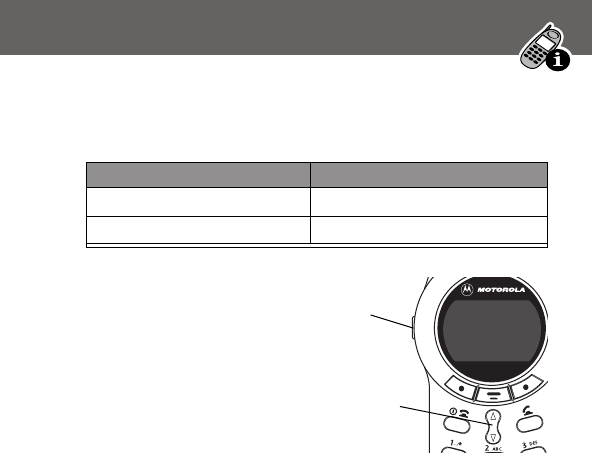
31
About Your Phone
Adjusting Volume
You can adjust your phone’s earpiece and ringer volume:
You can increase or decrease
volume in two ways:
• use only the volume key
• use the volume key in
combination with the
up/down navigation
key
To change keypad volume, see “Customize an Alert Profile” on
page 134.
When You Can Adjust
you are in a call earpiece speaker volume
the idle display is showing ringer volume
Volume
Key
Up/Down
Navigation
Key
User.Guide.GSM.book Page 31 Wednesday, January 9, 2002 2:30 PM

About Your Phone
32
Using Only the Volume Key
The volume key works in only one direction.
Using the Volume Key and the Up/Down
Navigation Key
To Increase Volume To Decrease Volume
Press the volume key
repeatedly.
Each press of the volume key
raises the volume one level. If
you press and hold the
volume key, the volume cycles
to the highest level and then
stops.
Press and hold the volume
key until the volume cycles to
and stops at the highest level.
Release the volume key, then
press again. The volume
begins at the lowest level and
adjusts upward as you
continue to press the key.
Step Result
1
Press the volume key
once
Your phone displays the volume
meter.
2
Press the up-arrow (on
the up/down
navigation key)
or
Press the down-arrow
(on the up/down
navigation key)
Volume increases.
Volume decreases.
User.Guide.GSM.book Page 32 Wednesday, January 9, 2002 2:30 PM

33
About Your Phone
Battery Use
Caution: To prevent injuries or burns, do not allow metal
objects to contact or short-circuit the battery terminals.
To maximize your battery’s performance:
• Always use Motorola Original™ batteries and battery
chargers. The phone warranty does not cover damage
caused from using non-Motorola batteries and/or battery
chargers.
• New batteries or batteries that have been stored for long
periods of time may require a longer charge time.
• Maintain the battery at or near room temperature when
charging.
• Do not expose batteries to temperatures below -10°C
(14°F) or above 45°C (113°F). Always take your phone with
you when you leave your vehicle.
• When you do not intend to use a battery for a while, store it
uncharged in a cool, dark, dry place, such as a refrigerator.
• Over extended periods of time, batteries gradually wear
down and require longer charging times. This is normal. If
you charge your battery regularly and notice a decrease in
talk time or an increase in charging time, then it is probably
time to purchase a new battery.
• The more you talk on the phone or use phone features (like
sending text messages), the less standby time your battery
has.
User.Guide.GSM.book Page 33 Wednesday, January 9, 2002 2:30 PM

About Your Phone
34
The rechargeable batteries that power this product
must be disposed of properly and may need to be
recycled. Refer to your battery’s label for battery type.
Contact your local recycling center for proper disposal methods.
Never dispose of batteries in a fire because they may explode.
User.Guide.GSM.book Page 34 Wednesday, January 9, 2002 2:30 PM

35
Sending and Receiving
Calls
This chapter describes features related to sending and receiving
calls.
For information about other call-related features, see “Recent
Calls” on page 79 and “Data and Fax Calls” on page 148. For
basic instructions on how to send, end, and receive a call, see
pages 25–26 of the “Getting Started” section.
Note: To send and receive calls, rotate your phone’s cover open.
Redialing a Number
You can redial a previously dialed phone number, whether the
call was connected or busy. From the idle display:
Using Automatic Redial
You must turn on automatic redial to use this feature. See the
“Auto Redial” item on page 75 to turn on automatic redial.
If you receive a busy signal, your phone displays Call Failed.
Press To
1
N go directly to the dialed calls list
2
Kscroll to the entry you want to call
3
N redial the highlighted number
User.Guide.GSM.book Page 35 Wednesday, January 9, 2002 2:30 PM

Sending and Receiving Calls
36
When automatic redial is turned on, your phone automatically
makes a number of redial attempts until the call goes through.
When the call goes through, your phone rings or vibrates one
time, displays the message Redial Successful, and then
connects the call.
When automatic redial is turned off, you can manually activate
the feature to redial a phone number. When you hear a busy
signal and see the Call Failed message:
Caller ID
The
calling line identification
(caller ID) feature lets
you see who is calling before you answer.
• If the caller’s name is stored in your phonebook, the phone
automatically displays the name. Otherwise, the phone
displays the caller’s phone number.
• If caller ID information is not available, your phone displays
the message Incoming Call.
Press To
N or RETRY (J) activate automatic redial
User.Guide.GSM.book Page 36 Wednesday, January 9, 2002 2:30 PM

37
Sending and Receiving Calls
Line Security
If your phone displays Line Not Secure while you are on a call,
your phone has detected another device monitoring the call. This
message does not appear when caller ID, call cost, or other
information fills the display.
Returning an Unanswered Call
Your phone keeps a record of your unanswered calls. When you
cannot answer a call, your phone displays:
• the T (missed call) indicator
• the message
X
Missed Calls, where
X
is the total number
of missed calls
Press To
1
VIEW (J) see the received calls list, beginning
with the most recent call
2
K scroll through the list and select a call
that you want to return
3
N send the call
User.Guide.GSM.book Page 37 Wednesday, January 9, 2002 2:30 PM

Sending and Receiving Calls
38
Dialing an Emergency Number
Your service provider programs one or more emergency phone
numbers (such as 112 or 911) that you can call under any
circumstances. You can dial and call the emergency number even
when your phone is locked, when you are prompted to enter a
code or password, when the SIM card is not inserted in your
phone, or when the SIM card is blocked or disabled.
Note: Emergency numbers vary by country. Your phone’s
emergency number(s) may not work in all locations.
To call the emergency number at any time:
Entering Numbers in the Notepad
Your phone stores the most recent string of digits entered on the
keypad in a temporary memory location called the
notepad
.
These digits can be the last phone number that you called, or a
phone number that you simply entered but did not call. These
digits remain in the notepad even when you turn off the phone.
You can use the notepad to store a phone number that you
intend to call later (such as a phone number told to you by the
other party during a call). To retrieve these digits, see “Using the
Notepad” on page 82.
Press To
1
keypad keys dial the emergency number (such as
112)
2
N call the emergency number
User.Guide.GSM.book Page 38 Wednesday, January 9, 2002 2:30 PM

39
Sending and Receiving Calls
Terminating an Incoming Call
While the phone is ringing or vibrating:
Depending on your phone settings and the type of
subscription you have, the call may be forwarded to
another number, or the caller may hear a busy signal.
Dialing With Speed Dial
Speed dial
lets you dial any phonebook entry with a minimal
number of keypresses.
When you store an entry in your phonebook, it is assigned a
unique speed dial number. You can then use the speed dial
feature to call the entry.
To make an entry in the phonebook or view an existing entry’s
speed dial number, see “Storing a Phonebook Entry” on
page 88.
Press To
O or IGNORE (L) cancel the incoming call
Press To
1
keypad keys enter the one-, two-, or three-digit
speed dial number for the entry you
want to dial
2
# submit the number
3
N call the entry
User.Guide.GSM.book Page 39 Wednesday, January 9, 2002 2:30 PM

Sending and Receiving Calls
40
Dialing With 1-Touch Dial
You can call phonebook entries 1 through 9 with the push of a
single key. Press and hold the one-digit speed dial number for
one second. To store entries in locations 1 through 9 in the
phonebook, see “Storing a Phonebook Entry” on page 88.
Note: You must specify which phone number list you want to
use with this feature: phone memory phonebook, or SIM card
phonebook. See “1-Touch Dial Preference” on page 101.
Dialing a Number in a Text Message
If you receive a text message with an embedded
phone number, you can dial the number directly.
Note: You must set up the text message inbox before
you can receive text messages. See “Setting Up the Text
Message Inbox” on page 113.
If the message contains more than one phone number, press K
to scroll to a number, then press SELECT (L) to dial.
Find the Feature
M> Messages > Text Msgs
Press To
1
K scroll to the message with the
number
2
M open the Text Msg Menu
3
K scroll to Call Back
4
SELECT (J) dial the number in the message
User.Guide.GSM.book Page 40 Wednesday, January 9, 2002 2:30 PM
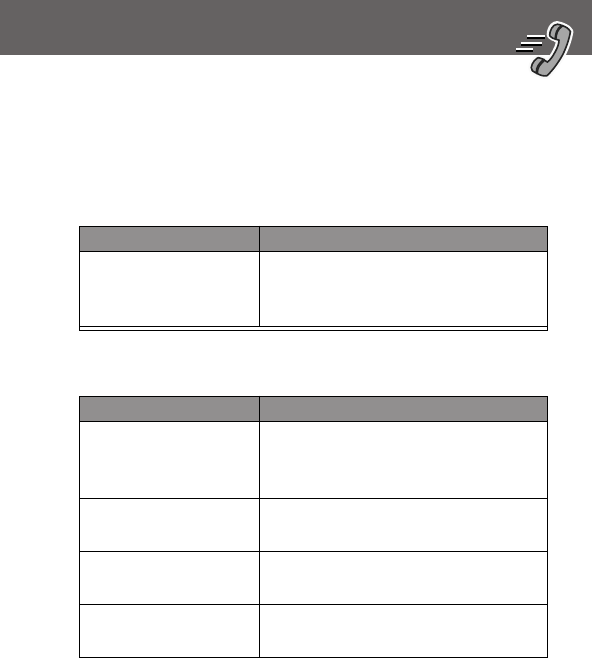
41
Sending and Receiving Calls
Additional Dialing Features
In addition to pressing numbers on your keypad, you can insert
numbers or characters and send calls in a variety of ways.
To dial the local international access code:
While dialing (with digits visible in the display):
Do This To
Press 0 for two
seconds
insert the international access code
for the country from which you are
dialing
Do This To
Press M
> Attach Number
attach a number from the phonebook
or recent calls list to the end of the
digits you entered
Press M
> Hide ID/Show ID
Hide (or show) your caller ID for the
next call
Press M
> Send Message
create a text message addressed to
the number entered
Press M
> Talk Then Fax
talk and then send a fax to the same
phone number within the same call
User.Guide.GSM.book Page 41 Wednesday, January 9, 2002 2:30 PM

Sending and Receiving Calls
42
Press M and then
scroll to and select
one of the following:
•Insert Pause
(to insert a p)
•Insert Wait
(to insert a w)
•Insert 'n'
(to insert an n)
insert a special character when
making a call that requires you to dial
and send additional digits (for
example, to make a calling card call,
or to retrieve messages from an
answering machine):
•Pause tells your phone to wait
until the call connects before it
automatically sends the next
digit(s) in a series.
•Wait tells your phone to wait
until the call connects, and then
to prompt you for confirmation
before it sends the next digit(s).
•'n' tells your phone to prompt you
for a number before dialing the
call. The number you enter is
inserted into the dialing sequence
in place of the n character.
Do This To
User.Guide.GSM.book Page 42 Wednesday, January 9, 2002 2:30 PM
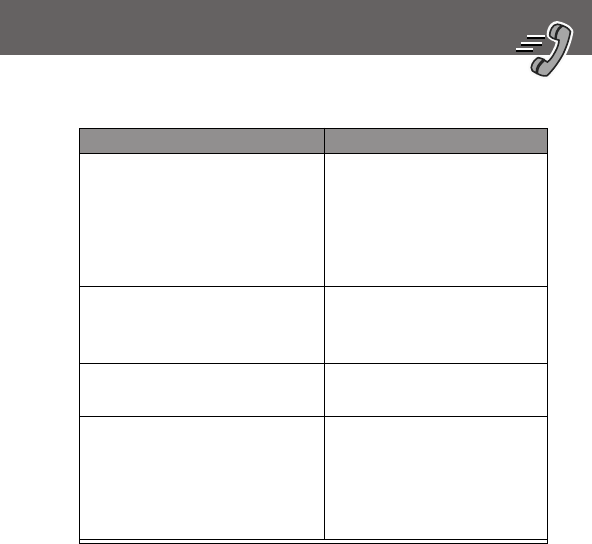
43
Sending and Receiving Calls
You can also call numbers using these features:
Do This To Call
Press V. Dial (L), and say
the entry’s name within two
seconds
a phone number using the
voice dial feature
See “Recording a Voice
Name For a Phonebook
Entry” on page 91.
Press M > Service Dial
>
entry to call
a service dial number
programmed on the SIM
card
Press M > Fixed Dial
>
entry to call
a fixed dial number
Press M > Recent Calls
>Received Calls
or
Dialed Calls
>
entry to call
a missed call or a number
from a call you recently
dialed or received
User.Guide.GSM.book Page 43 Wednesday, January 9, 2002 2:30 PM

44
Using Features While On a
Call
Using Call Waiting
If you subscribe to call waiting, an alert tone sounds
while you are on a call to indicate that you have
received a second call.
To put the first call on hold and answer the second call:
To end the first call and answer the second call:
You must activate call waiting in order to use the feature. See the
“Call Waiting” item on page 72 to activate call waiting.
Press To
1
N answer the new call
2
SWITCH (J)
or
LINK (L)
switch back to the first call
Note: You can press SWITCH (J) at
any time to switch between calls.
connect the two calls
Press To
1
O end the current call
Your phone rings to signal the new
call.
2
N answer the new call
User.Guide.GSM.book Page 44 Wednesday, January 9, 2002 2:30 PM
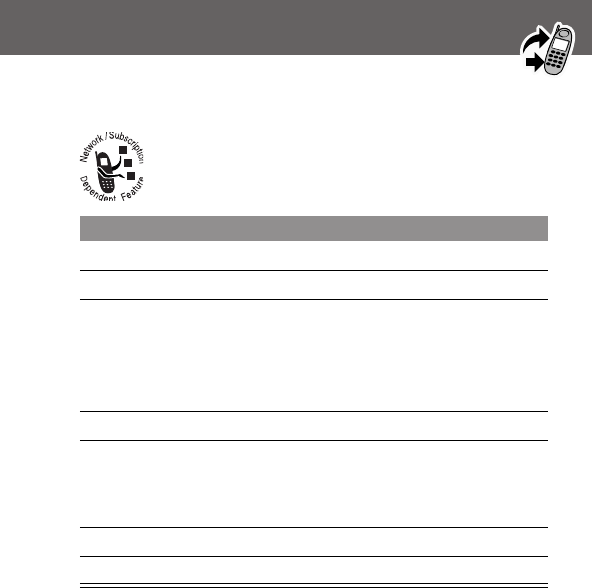
45
Using Features While On a Call
Making a Conference Call
To talk to more than one person on a call, you can
make a conference call. Call the first person, call the
second person, then link the two calls.
Press To
1
keypad keys dial the first person’s number
2
N call the number
3
HOLD (J)
(if available)
or
M > Hold
put the first call on hold
Your phone displays a l (flashing
phone) indicator next to the call on
hold.
4
keypad keys dial the next person’s number
5
N call the number
Your phone displays a W (active call)
indicator next to the new active call.
6
LINK (L) connect the two calls
7
O end the entire call
User.Guide.GSM.book Page 45 Wednesday, January 9, 2002 2:30 PM

Using Features While On a Call
46
Transferring a Call
While you are on a call, you can transfer the call to another
phone by first talking to the person who answers the other
phone, or by directly transferring the call.
Announce the Call Transfer
You can talk to the person who answers the other phone before
you transfer the call, to tell them whom you are transferring.
Find the Feature
M > Hold
Press To
1
keypad keys enter the phone number where you
are transferring the call
2
N dial the phone number
Speak to the person who answers the
target phone.
3
M open the menu
4
K scroll to Transfer
5
SELECT (J) select Transfer
6
OK (J) confirm the transfer
Your phone displays the message
Transfer: Complete when the call
is transferred. You can hang up the
phone when you see this message.
User.Guide.GSM.book Page 46 Wednesday, January 9, 2002 2:30 PM
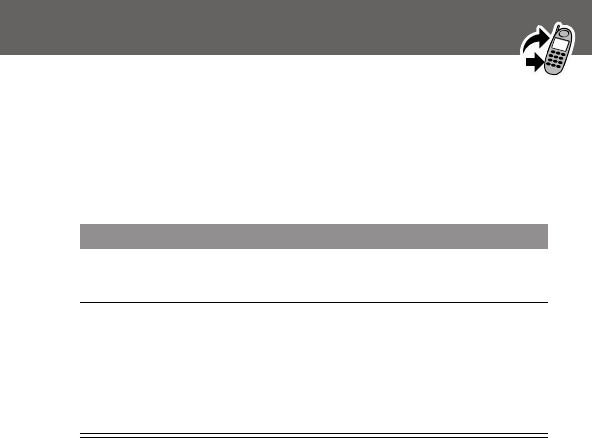
47
Using Features While On a Call
Do Not Announce the Call Transfer
You can directly transfer a call without talking to the person who
answers.
Find the Feature
M > Transfer
Press To
1
keypad keys enter the phone number where you
are transferring the call
2
N dial the phone number
Your phone displays the message
Transfer: Complete when the call
is transferred. You can hang up the
phone when you see this message.
User.Guide.GSM.book Page 47 Wednesday, January 9, 2002 2:30 PM
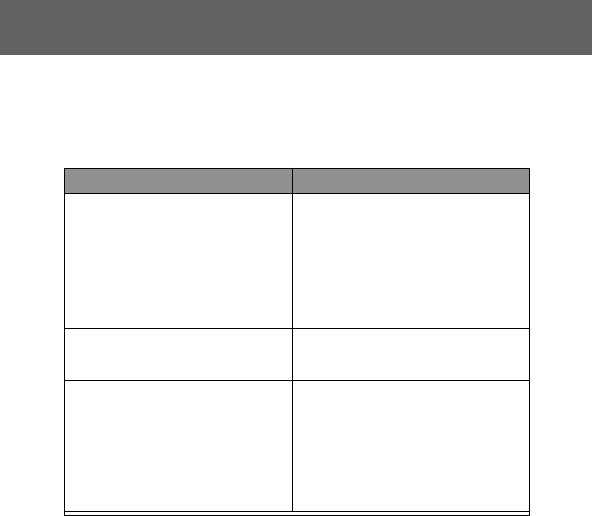
Using Features While On a Call
48
Additional On-Call Features
While you are on a call, you can perform the following tasks:
Do This To
Press HOLD (J) (if
available)
or
Press M > Hold
put a call on hold
Your phone displays a l
(flashing phone) indicator to
indicate that the call is on
hold.
Press M >
My Tel. Numbers
see your phone number
Press M > Send Tones send a number to the network
as DTMF tones, for credit card
calling or password entry
To activate DTMF tones, see
the “DTMF” item on page 76
User.Guide.GSM.book Page 48 Wednesday, January 9, 2002 2:30 PM
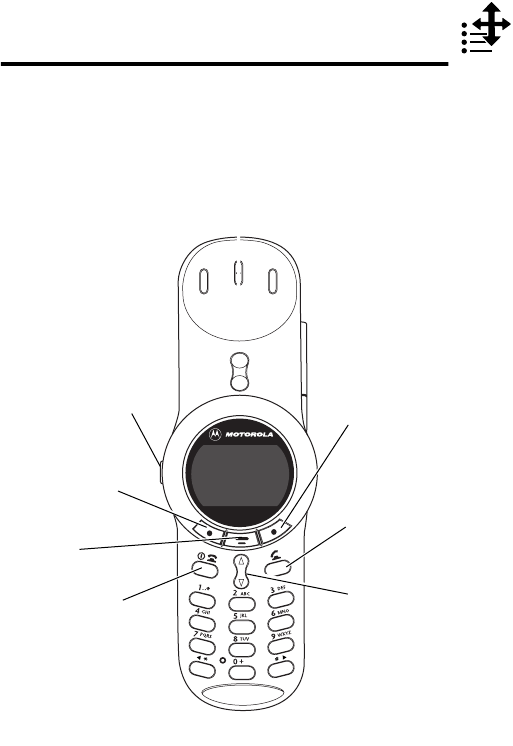
49
Using the Menu
Navigating to a Feature
You can access many of your phone’s features by using these
keys to move through the menu system:
Volume Key
Adjust earpiece
and ringer volume.
Right Soft Key
Perform functions
identified by right
display prompt.
Menu Key
Power/End Key
Press & hold to power
phone on & off.
Press & release to end
phone calls,exit menu
system.
Send Key
Send and answer
calls, view recent
dialed calls list.
Navigation Keys
Scroll through
menus and lists,
set feature values.
Left Soft Key
Perform functions
identified by left
display prompt.
User.Guide.GSM.book Page 49 Wednesday, January 9, 2002 2:30 PM
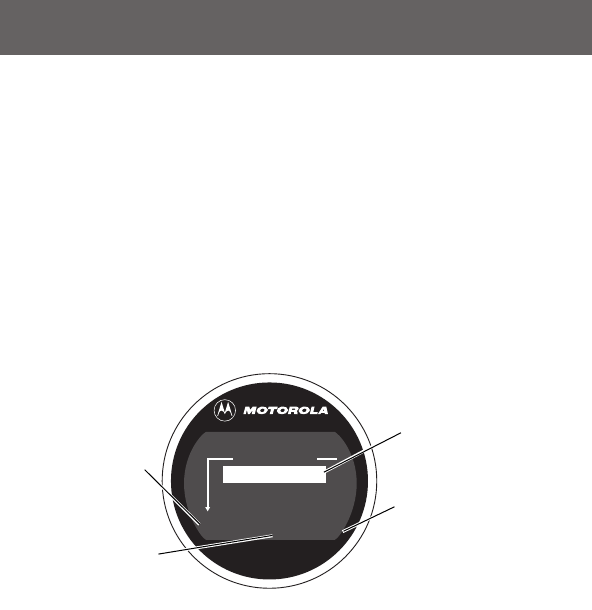
Using the Menu
50
This guide shows how to navigate to a menu feature as follows:
The > symbol means that you should scroll to and select the
feature. This example shows that you should press M, scroll to
and select Recent Calls, then scroll to and select Dialed Calls
to see the dialed calls list.
Selecting a Feature
Some features require you to select an item from a list:
Select an item by highlighting it using one of these approaches:
• Press K to scroll up or down to the item you want.
• In a numbered list, press a number key to highlight the
item.
• In an alphabetized list, press a key multiple times to cycle
through the letters on the key and highlight the closest
matching list item.
Find the Feature
M > Recent Calls
> Dialed Calls
Press
BACK
(
L
)
to return to
the previous
screen.
A sub-menu is
available. Press
M
to open
the sub-menu.
Highlighted
item
M
Press
VIEW
(
J
)
to view details
of the highlighted
item.
STORE
(
J
)
appears if you can
store the item in
your phonebook.
Dialed Calls
10) John Smith
9) Mary Smith
BACK VIEW
User.Guide.GSM.book Page 50 Wednesday, January 9, 2002 2:30 PM
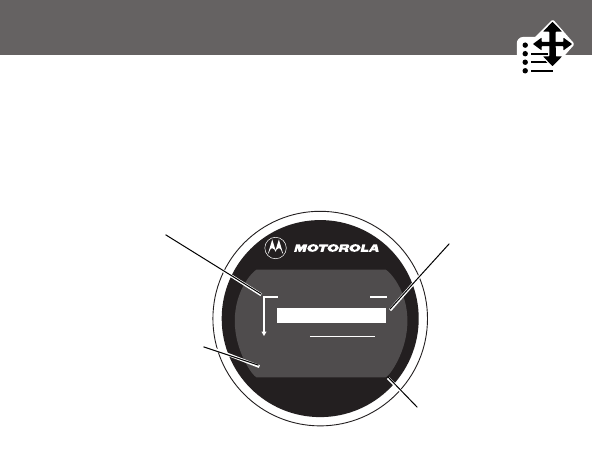
51
Using the Menu
Entering Feature Information
Features such as the phonebook and datebook require you to
enter information to fill in an entry’s details:
• Enter numbers or text with the keypad. (See “Entering Text”
on page 53.)
• When an item has a list of possible values, press * to
scroll left or # to scroll right, and select a value.
• When an item has a list of possible numeric values, press a
number key to set the value.
• If you enter or edit information and then decide that you do
not want to save your changes, press O to exit without
saving.
Press
CANCEL
(
L
) to
exit without making
changes.
DONE
(
L
) appears
when you enter or edit
information. Press
DONE
(
L
) to save
your changes.
Press
K
to
scroll down
to additional
items.
Press
CHANGE
(
J
)
to edit the selected
information.
Highlighted item
Entry Details
Name: John Smith
No.: 2125551212
CANCEL M CHANGE
User.Guide.GSM.book Page 51 Wednesday, January 9, 2002 2:30 PM
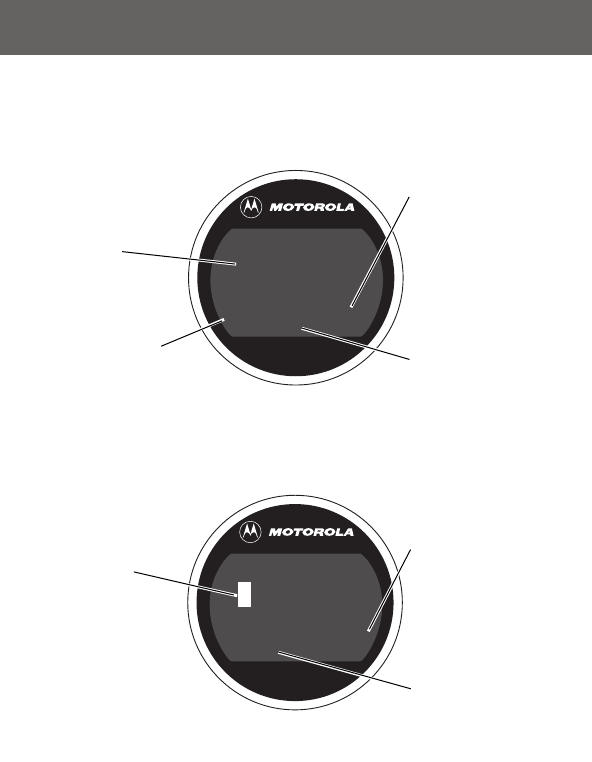
Using the Menu
52
The message center lets you compose and send text messages.
(See “Entering Text” on page 53.) A
flashing cursor
shows you
where the text will appear:
When you enter text, the flashing cursor changes to a
block
cursor
, and the soft key functions change:
Press
BROWSE
(
J
)
to view and
insert a name,
number, or
message from
previously
stored
information.
Press
CANCEL
(
L
)
to exit without
making changes.
Flashing
cursor
indicates
insertion
point.
Press
M
to open the
sub-menu.
Msg:
______________
______________
CANCEL M
BROWSE
|
Press
OK
(
J
)
to accept and
store the text.
Press
DELETE
(
L
)
to delete the
character to the
left of the
insertion point.
Block
cursor
indicates
current
highlighted
character.
After two
seconds, the
block
cursor reverts to a
flashing cursor
and moves to the next
position.
Msg:
T_____________
______________
DELETE M
OK
User.Guide.GSM.book Page 52 Wednesday, January 9, 2002 2:30 PM

53
Entering Text
Various text entry methods make it easy for you to enter names,
numbers, and text messages on your phone.
You can enter all characters (letters, numbers, and symbols)
using the standard tap method. Other text modes let you easily
enter numbers and symbols, or insert text already stored on your
phone. Finally, a predictive text mode lets you enter text
messages with a minimum of keypresses.
Choosing a Text Mode
To activate a text mode, press M
from any text entry screen
and select the text mode from the
Entry Method
menu:
Note:
The text mode you select remains active until you change
it by selecting another mode.
iTAP
Let the phone predict each word as you enter it,
then choose the word from a list (see “Predictive
Text Entry with iTAP™ Software” on page 58).
Tap Method
Enter characters one at a time by pressing the
key for the letter, number, or symbol (see “Tap
Method” on page 54). This is the standard mode
for entering text on your phone.
Numeric
Enter only the number that appears on each key.
Symbol
Enter symbols only (see “Symbol Mode” on
page 57).
Browse
Browse through your phonebook and recent
calls lists to select a name or number to enter.
User.Guide.GSM.book Page 53 Wednesday, January 9, 2002 2:30 PM
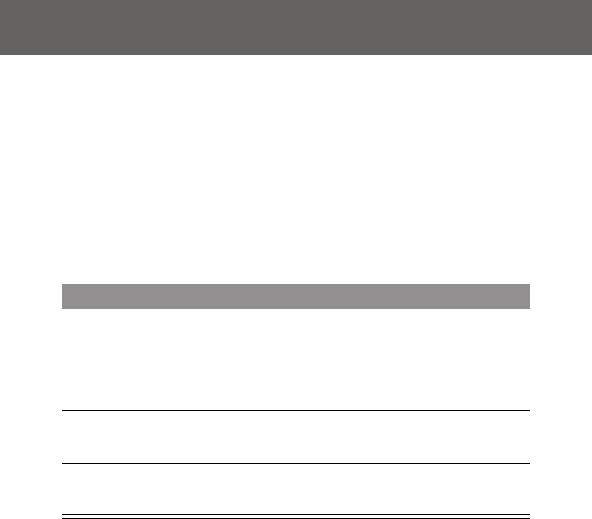
Entering Text
54
Tap Method
Tap method is the default standard mode for entering text on
your phone.
To activate tap method from any text entry screen, press M
and select the
Tap Method
menu option.
To enter text using the tap method:
Do This To
1
Press a number
key one or more
times
cycle through the characters
associated with the key and select
the character you want (see the
“Character Chart” on page 56).
2
Continue to press
number keys
enter the rest of the characters in the
text message
3
Press
OK
(J
) accept and store the text when you
are finished
User.Guide.GSM.book Page 54 Wednesday, January 9, 2002 2:30 PM
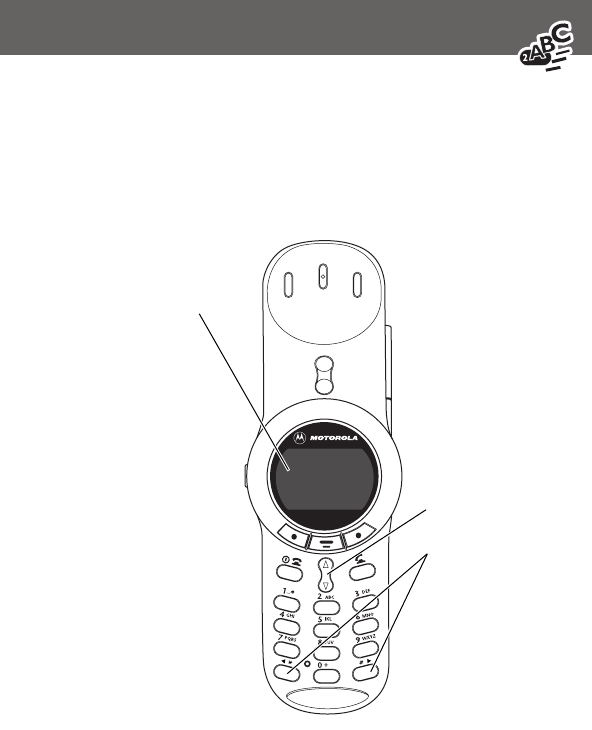
55
Entering Text
General Text Entry Rules
Use the keypad to enter letters, numbers, symbols, and other
characters with the tap method. Press the same key repeatedly
to cycle through available characters. (See the “Character Chart”
on page 56.)
• If you do not press a key for two seconds, the character in
the block cursor is accepted, and the cursor moves to the
next position.
Press a number
key to enter text
at flashing cursor
location.
Press a number
key as many times
as necessary to
enter the desired
character.
Press and hold
a number key to
cycle between
tap method and
numeric text
entry mode.
Press left or
right navigation
keys to move
flashing cursor
to the left or
right in text
message.
Press up or
down navigation
keys to change
character in
block cursor to
uppercase or
lowercase.
Msg:
__________
__________
CANCEL M
BROWSE
|
User.Guide.GSM.book Page 55 Wednesday, January 9, 2002 2:30 PM
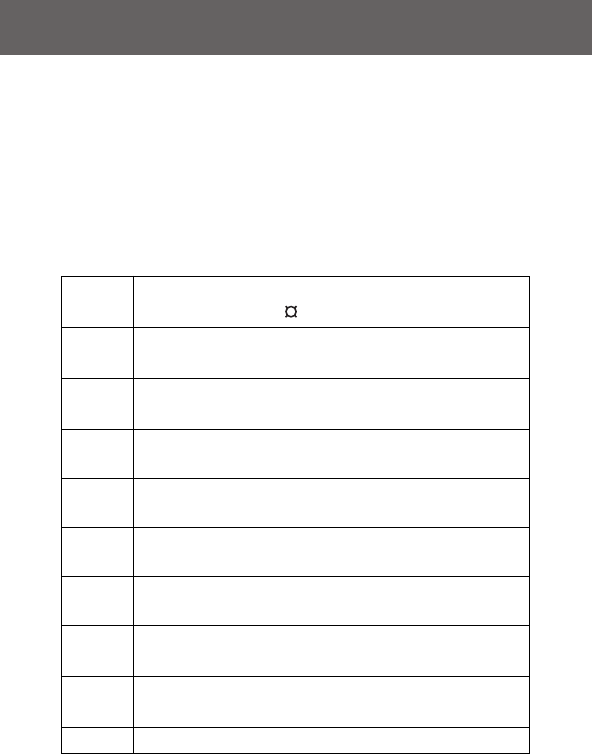
Entering Text
56
• The first character of each sentence is capitalized unless you
manually change it. (Press K
down to force the character to
lowercase while it is highlighted by the block cursor.)
Character Chart
Use this chart as a guide for entering spaces, numbers, letters,
symbols, and other characters with the tap method.
Note:
Your phone model may not include all of the characters
shown in the above chart.
1
space . 1 ? ! , @ _ & ~ : ; " - ( ) '
¿ ¡ % £ $ ¥
€
2
A B C 2 Ä Å Á À Â Ã
α
β
Ç
a b c 2 ä å á à ã
α
β
ç
3
D E F 3
∆
Ë É È Ê
φ
d e f 3
δ
é è ê
φ
4
G H I 4 Ï Í Î ¬
g h i 4 ï í î
γ
5
J K L 5
Λ
j k l 5
λ
6
M N O 6 Ñ ö Ø ó ò ô õ
Ω
m n o 6 ñ ö ø ó ò ô õ
ω
7
P Q R S 7
∏
β
∑
p q r s 7
π
β
σ
8
T U V 8
θ
Ü Ú Ù Û
t u v 8
θ
ü ú ù
9
W X Y Z 9
Ξ
ψ
w x y z 9
ξ
ψ
0
+ - 0 x * / \ [ ] = > < # §
User.Guide.GSM.book Page 56 Wednesday, January 9, 2002 2:30 PM

57
Entering Text
Symbol Mode
Your phone provides an alternate way to find and enter symbol
characters in a text message. You can view and select from a
variety of available symbols.
To activate symbol mode from any text entry screen, press M
and select the
Symbol menu option.
To enter a symbol in symbol mode:
Do This To
1
Press a number key
one time
display its symbol options (see the
“Symbol Chart” on page 58)
The symbols associated with the
key you pressed are shown at the
bottom of the display. If necessary,
press other keypad keys to find the
symbol you want.
2
Press the scroll
left * or the
scroll right # key
or
Press the number
key multiple times
highlight the symbol you want
3
Press SELECT (J) add the highlighted symbol to the
text area at the top of the display
User.Guide.GSM.book Page 57 Wednesday, January 9, 2002 2:30 PM
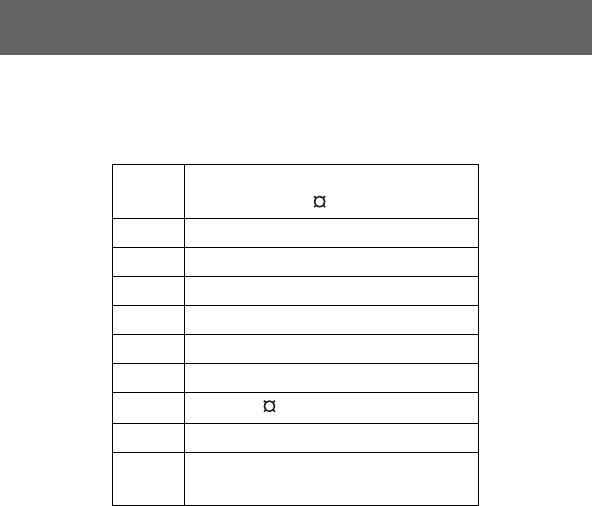
Entering Text
58
Symbol Chart
Use this chart as a guide for entering symbols in symbol mode.
Predictive Text Entry with iTAP™
Software
iTAP™ software provides a predictive text entry method that lets
you enter the letters of a word using only one keypress per letter.
You must activate iTAP software prior to entering letters. You can
do this from any text entry screen by pressing M to open the
Entry Method menu and selecting the iTAP menu option.
1
space
. ? ! , @ _ & : ; " - ( ) ' ¿
¡ % £ $ ¥ €
2 @ _ \
3 / : ;
4 " & '
5 ( ) [ ] { }
6 ¿ ¡ ~
7 < > =
8 $ £ ¥ €
9 # % *
0 + - x * / =
> < # §
User.Guide.GSM.book Page 58 Wednesday, January 9, 2002 2:30 PM

59
Entering Text
Enter Words
To enter a word with iTAP software:
Do This To
1
Press a number key
one time
enter the first letter of the word
The letters associated with the key
you pressed are shown at the
bottom of the display.
2
Press number keys
(one per letter)
enter the rest of the word
Alternative words and letter
combinations are shown at the
bottom of the display based on the
keys you press. These word choices
are updated with each keypress.
3
When you have
entered all the
letters of the word,
press K
locate and highlight the word you
want
4
Press SELECT (J) add the highlighted word to the
text area at the top of the display
A space is automatically inserted
after the word.
User.Guide.GSM.book Page 59 Wednesday, January 9, 2002 2:30 PM

Entering Text
60
For example, to spell the word “act,” press 2 2 8. The
display shows:
Enter Novel Words
You may enter a word that is not in the iTAP software dictionary.
If you enter all the letters of a word but the word is not
displayed:
Do This To
1
Press DELETE (L)
one or more times
delete one or more letters until
you see a letter combination
that matches the start of the
word
2
Press the scroll
left * or the
scroll right # key
highlight the letter or letter
combination
Press
SELECT
(
J
)
to insert the
highlighted word
at the insertion point.
Press
DELETE
(
L
)
t
o clear the last letter
entered.
Flashing
cursor
indicates
insertion
point.
Press
* and #
scroll and see
additional word
choices.
Cat Act Bat Abu
______________
______________
DELETE M
|
SELECT
}
User.Guide.GSM.book Page 60 Wednesday, January 9, 2002 2:30 PM

61
Entering Text
Punctuation
The iTAP software automatically adds a space after each word.
When you enter punctuation, this space is removed. To enter
punctuation with iTAP software:
Capitalization
The first word of a sentence is automatically capitalized, with
following words in lowercase. To set or adjust character
capitalization with iTAP software:
3
Press
SELECT
(J
),
then press the scroll
left *
key
shift the text entry cursor to the
left and “lock” the selected
portion of the word
4
Continue entering
letters and highlighting
letter combinations
spell the word
Press To
1
or 0
enter punctuation or other characters
as shown in the “Character Chart”
on page 56
Press To
K
up or down change the words to initial character
capitalized, all uppercase characters,
or all lowercase characters
Do This To
User.Guide.GSM.book Page 61 Wednesday, January 9, 2002 2:30 PM

Entering Text
62
Enter Numbers
To enter a number with iTAP software:
Delete Letters and Words
Place the cursor to the right of the text that you want to delete,
and then:
Do This To
1
Enter the first digit
and then highlight it
put the iTAP software in number
entry mode
2
Press number keys add digits to the number
3
Press
SELECT
(J
) enter the number at the insertion
point
Do This To
Press
DELETE
(L
) delete one letter at a time
Continue to hold
DELETE
(L
)
delete the entire message
User.Guide.GSM.book Page 62 Wednesday, January 9, 2002 2:30 PM

63
Menu Feature Descriptions
This chapter describes all of your phone’s features in order of the
menu map shown on pages 3–4. Some descriptions also include
page numbers where you can find more detailed information.
If you would like to learn more about a specific feature, a
reference guide for your phone is also available. To obtain a copy
of the reference guide or another copy of this user guide, see the
Motorola Web site at:
http://motorola.com/consumer/manuals
(United States)
http://www.motorola.ca/manuals
(Canada)
or contact the Motorola Customer Call Center at
1-800-331-6456 (United States) or 1-800-461-4575 (Canada).
Main Menu
R
ECENT
C
ALLS
Received Calls
M
>
Recent Calls
>
Received Calls
View a list of recently received calls. See “Viewing the
Received Calls or Dialed Calls List” on page 79.
Dialed Calls
M
>
Recent Calls
>
Dialed Calls
View a list of recently dialed calls. See “Viewing the
Received Calls or Dialed Calls List” on page 79.
User.Guide.GSM.book Page 63 Wednesday, January 9, 2002 2:30 PM

Menu Feature Descriptions
64
Notepad
M > Recent Calls
> Notepad
Call or store the last number entered on the keypad. See
“Entering Numbers in the Notepad” on page 38, and
“Using the Notepad” on page 82.
Call Times
M > Recent Calls
> Call Times
View call timers that track time spent on your last call,
dialed calls, received calls, all calls since reset, and all calls
total. See “Viewing and Resetting Call Timers” on page 83.
Call Cost
M > Recent Calls
> Call Cost
View call cost information. Your network may
provide current credit information, and can provide cost
information about the amount spent on your last call,
dialed calls, received calls, and all calls total. See “Viewing
and Resetting Call Costs” on page 85.
S
ERVICE
D
IAL
M > Service Dial
Dial pre-programmed numbers stored on your SIM
card. Your service provider can program your SIM
card with phone numbers for services such as taxi
companies, restaurants, and hospitals.
F
IXED
D
IAL
M > Fixed Dial
Dial or edit numbers in the fixed dial list.
When you activate the fixed dial feature, users can
only call the numbers in the fixed dial list. To activate fixed
dial, see the “Fixed Dial” item on page 73.
User.Guide.GSM.book Page 64 Wednesday, January 9, 2002 2:30 PM

65
Menu Feature Descriptions
Fixed dial list entries can be any length. If there is a fixed
dial entry for the digits 555, users can call any number that
starts with 555.
You must enter your SIM PIN2 code to edit fixed dial
entries. In the fixed dial list, you can create, edit, delete, and
sort entries just like in the phonebook list. Fixed dial list
entries are stored on your SIM card and do not have Type
or Voice Name fields.
Note: Employers can use fixed dial to limit employees’
phones to a predefined list of numbers, country codes, or
other prefixes.
P
HONEBOOK
M > Phonebook
Store names and numbers as entries in your phonebook,
then call numbers by selecting them from the phonebook
list. See “Phonebook” on page 87.
D
ATEBOOK
M > Datebook
Use the datebook calendar to schedule and review your
appointments. See “Datebook” on page 102.
Q
UICK
D
IAL
M > Quick Dial
Dial pre-programmed numbers stored on your
phone. Your service provider may program your
phone with one or more quick dial numbers, such as the
customer service number. You can call them by selecting
them from the quick dial list.
Note: Your service provider may use a different name for
this feature.
User.Guide.GSM.book Page 65 Wednesday, January 9, 2002 2:30 PM

Menu Feature Descriptions
66
M
ESSAGES
M > Messages
Adjust message settings, view and manage the
various types of messages your phone can receive
and/or send:
S
HORTCUTS
M > Shortcuts
Create keypad shortcuts to menu features. See “Shortcuts”
on page 120.
Voicemail Listen to your recorded voice
messages. See “Messages—
Voicemail” on page 111
Text Msgs Send and receive text messages. See
“Messages—Text” on page 113
Browser Alerts Read alert messages received by your
micro-browser
Info Services Read information services messages
(subscription-based broadcast
messages, such as stock updates,
news, and weather reports) that you
have received
Quick Notes Select and send pre-written messages
from the quick notes list.
Outbox View all outgoing text messages,
delivered and undelivered
Drafts Store and edit text messages that you
have written but not sent
User.Guide.GSM.book Page 66 Wednesday, January 9, 2002 2:30 PM

67
Menu Feature Descriptions
V
OICE
D
IAL
M > Voice Dial
Dial a phonebook entry by saying the pre-recorded voice
name for that phonebook entry. See “Voice Dial Using the
Menu” on page 93.
SIM A
PPLICATIONS
M > SIM Applications
Access information and applications stored on
your SIM card.
Your SIM card may contain applications that process your
outgoing calls, text messages, and other events. Contact
your service provider for details.
B
ROWSER
M > Browser
Access Web pages and run Web-based
applications. The micro-browser delivers WAP
(Wireless Application Protocol) pages from your service
provider directly to your phone. See “Micro-Browser” on
page 123.
C
ALCULATOR
M > Calculator
Use your phone as a calculator or currency converter. See
“Calculator” on page 125.
G
AMES
M > Games
Play games on your phone. See “Games” on page 128.
User.Guide.GSM.book Page 67 Wednesday, January 9, 2002 2:30 PM

Menu Feature Descriptions
68
Settings Menu
R
ING
/V
IBRATE
Alert
M > Settings
> Ring/Vibrate
> Alert
Select a ring or vibration alert profile for incoming calls and
messages. See “Ring/Vibrate” on page 133.
Alert Detail
M > Settings
> Ring/Vibrate
>
Alert
Detail
Change details about the current alert profile.
Alert
represents the name of the alert profile. See
“Ring/Vibrate” on page 133.
My Tones
M > Settings
> Ring/Vibrate
> My Tones
Create custom alert tones for your phone. See “Use the My
Tones Feature” on page 135.
C
ALL
F
ORWARD
M > Settings
> Call Forward
Set options for forwarding incoming voice, data,
and/or fax calls to another phone number. See “Call
Forwarding” on page 141.
User.Guide.GSM.book Page 68 Wednesday, January 9, 2002 2:30 PM
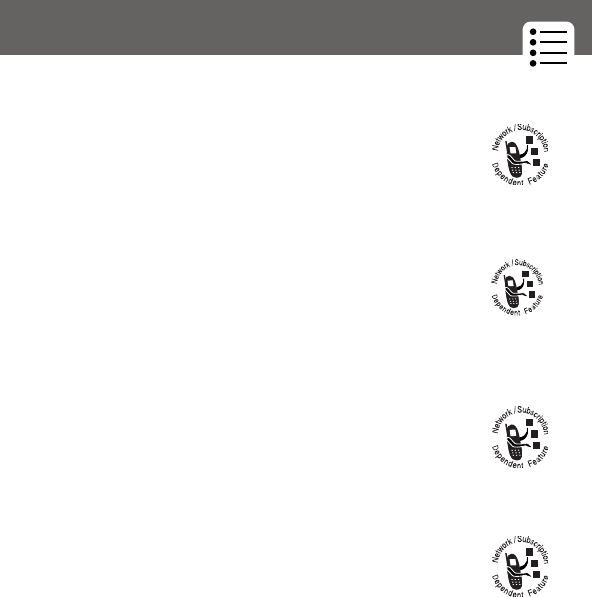
69
Menu Feature Descriptions
P
HONE
S
TATUS
My Tel. Numbers
M > Settings
> Phone Status
> My Tel. Numbers
View, enter, and edit information about your name
and phone number.
Credit Info
M > Settings
> Phone Status
> Credit Info
View the credit available, its expiration date, and
the date of the last deposit. (This feature is available only if
you subscribe to a prepay option.)
Credit Available
M > Settings
> Phone Status
> Credit Available
View the credit available. (This feature is available
only if you subscribe to the advice-of-charge feature.)
Active Line
M > Settings
> Phone Status
> Active Line
Change the active phone line to send and receive
calls from either of the available numbers. (This feature is
available only for dual-line enabled SIM cards.)
Battery Meter
M > Settings
> Phone Status
> Battery Meter
View a detailed battery charge meter.
User.Guide.GSM.book Page 69 Wednesday, January 9, 2002 2:30 PM

Menu Feature Descriptions
70
Other Information
M > Settings
> Phone Status
> Other Information
View your phone’s feature specifications (if available from
the service provider).
B
ROWSER
S
ETUP
M > Settings
> Browser Setup
Adjust the micro-browser’s network connection
settings, or create a new network connection profile.
I
N-
C
ALL
S
ETUP
Set the features that are active during a call, such as the
in-call timer, call waiting, and call answering options.
In-Call Timer
M > Settings
> In-Call Setup
> In-Call Timer
Adjust call timer display and beep settings. You can set your
timer to beep at a selected interval during your calls. (60
seconds is the default.) You can also turn on or off a display
timer during calls as follows:
Time Display the elapsed time for the
current call
Cost Display the cost of the current
call (if you subscribe to a call
cost option or
advice-of-charge)
User.Guide.GSM.book Page 70 Wednesday, January 9, 2002 2:30 PM

71
Menu Feature Descriptions
Call Cost Setup
M > Settings
> In-Call Setup
> Call Cost Setup
Adjust call cost settings.
You can assign a credit limit so that your phone displays
your remaining credit during calls. Your phone notifies you
when you approach your limit, and ends the call when you
reach it.
Your phone network expresses cost in the amount of units
used, but this feature lets you tell your phone how to
translate the units to a currency.
My Caller ID
M > Settings
> In-Call Setup
> My Caller ID
Activate and deactivate the display of your phone
number as an ID when you call someone.
Total Cost Display the cost of all calls
since the last time you reset
the timer (if you subscribe to
a call cost option or
advice-of-charge)
Credit Available Display how much credit you
have left (if you subscribe to a
call cost option or
advice-of-charge)
Off No in-call timer display
User.Guide.GSM.book Page 71 Wednesday, January 9, 2002 2:30 PM

Menu Feature Descriptions
72
Talk and Fax
M > Settings
> In-Call Setup
> Talk and Fax
Activate and deactivate the talk/fax service.
Use this feature prior to making a call when you want to
talk and then send or receive a fax—all to the same phone
number and within the same call.
You can also use the talk then fax feature to send a fax
during a call. See “Sending a Talk then Fax Call” on
page 152.
Answer Options
M > Settings
> In-Call Setup
> Answer Options
Turn call answering options on or off:
Call Waiting
M > Settings
> In-Call Setup
> Call Waiting
Activate and deactivate call waiting.
When call waiting is activated and another call arrives while
you are on a call, call waiting can play a tone to notify you
of the new call. See “Using Call Waiting” on page 44.
Multi-Key Answer by pressing any key
Open to Answer Answer by opening the flip
User.Guide.GSM.book Page 72 Wednesday, January 9, 2002 2:30 PM

73
Menu Feature Descriptions
S
ECURITY
Phone Lock
M > Settings > Security
> Phone Lock
Lock and unlock your phone. See “Locking and Unlocking
Your Phone” on page 155.
Lock Application
M > Settings > Security
> Lock Application
Lock and unlock specific phone applications (such as
phonebook or datebook). When an application is locked,
users must enter the unlock code to use the application.
Fixed Dial
M > Settings
> Security
> Fixed Dial
Restrict outgoing calls to numbers on the fixed
dial list. See “Fixed Dial” on page 64.
Call Barring
M > Settings > Security
> Call Barring
Restrict incoming and outgoing calls. See “Barring Calls”
on page 157.
SIM PIN
M > Settings > Security
> SIM PIN
Switch SIM card protection on and off, so users must enter
the SIM card PIN code when they turn on the phone or
insert a SIM card. See “Protecting the SIM Card” on
page 158.
User.Guide.GSM.book Page 73 Wednesday, January 9, 2002 2:30 PM

Menu Feature Descriptions
74
New Passwords
M > Settings > Security
> New Passwords
Change your unlock code (originally set to 1234) or your
security code (originally set to 000000). See “Assigning a
New Code or Password” on page 153.
O
THER
S
ETTINGS
Personalize
M > Settings
> Other Settings
> Personalize
Set several personal phone options:
Initial Setup
M > Settings
> Other Settings
> Initial Setup
Set many basic phone options:
Main Menu Change the order of the main menu.
(See “Reordering Menu Items” on
page 143.)
Keys Change the functions of the soft keys
in the idle display. (See “Customizing
a Soft Key Function” on page 144.)
Greeting Change the text displayed
when you turn on your phone
Quick Dial Change quick dial number(s)
Time and Date Set the phone’s time and date
User.Guide.GSM.book Page 74 Wednesday, January 9, 2002 2:30 PM

75
Menu Feature Descriptions
1-Touch Dial Assign the 1-touch dial feature to
numbers 1 through 9 in your phone
memory phonebook or SIM card
phonebook. (See “1-Touch Dial
Preference” on page 101.)
Auto Redial Use this option to turn on or turn off
the automatic redial feature. When
you turn on automatic redial, your
phone automatically redials calls that
fail due to busy conditions. (See
“Using Automatic Redial” on
page 35.)
Backlight Set the amount of time that the
display backlight remains on, or turn
off the backlight to conserve battery
power
Zoom Switch between three lines (Zoom
Out) and two lines (Zoom In) of display
text
Note: By default, your phone uses
two lines to display Chinese
characters. When your phone is set to
display Chinese characters, the zoom
setting is not available.
User.Guide.GSM.book Page 75 Wednesday, January 9, 2002 2:30 PM

Menu Feature Descriptions
76
Scroll Force the cursor to stop or wrap
around when it reaches the top or
bottom of a list in the display
Animation Turn animation off (to conserve the
battery) or on. Animation makes your
phone’s menus move smoothly as you
scroll up and down.
Language Set the language for phone menus
Battery Save Adjust the phone’s power usage
characteristics to conserve power
Contrast Adjust the contrast setting for your
display
DTMF Your phone can send a number to the
network as dual tone multi-frequency
(DTMF) tones. DTMF tones are used to
communicate with automated systems
that require you to enter a number
such as a code, password, or credit
card number. Use this option to set
DTMF tones to be long, short, or off.
Master Reset Reset all options back to their original
factory settings
except
for the unlock
code, security code, and lifetime timer
User.Guide.GSM.book Page 76 Wednesday, January 9, 2002 2:30 PM

77
Menu Feature Descriptions
Network
M > Settings
> Other Settings
> Network
View and adjust your phone’s network settings.
Your service provider registers your phone to a network. You
can view information about the current network, change
how your phone searches for a network, specify your
preferred networks, and activate alerts that indicate when a
call is dropped or network registration changes.
Car Settings
M > Settings
> Other Settings
> Car Settings
Adjust hands-free car kit settings.
You can set your phone to route calls directly to the
Easy-Install Hands-Free Kit when it detects a connection,
and automatically answer calls after two rings. See
“Hands-Free Use” on page 144.
Master Clear Reset all options back to their original
factory settings
except
for the unlock
code, security code, and lifetime timer,
and
clear all user settings and entries
Note: This option
erases all
user-entered information
stored in
your phone’s memory, including
phonebook and datebook entries.
Once you erase the information, it
cannot be recovered.
User.Guide.GSM.book Page 77 Wednesday, January 9, 2002 2:30 PM

Menu Feature Descriptions
78
Note: The use of wireless devices and their accessories may
be prohibited or restricted in certain areas. Always obey the
laws and regulations on the use of these products.
Headset
M > Settings
> Other Settings
> Headset
Set your phone to automatically answer calls after
two rings when connected to a headset. See “Hands-Free
Use” on page 144.
User.Guide.GSM.book Page 78 Wednesday, January 9, 2002 2:30 PM

79
Recent Calls
You can use the recent calls menu to view received calls or dialed
calls, retrieve the last number stored in the notepad, and view or
reset call times and costs.
Viewing the Received Calls or Dialed
Calls List
Your phone keeps lists of the numbers from calls you recently
received and dialed, even if the calls did not connect. The lists
are sorted from newest to oldest entries. The oldest entries are
deleted as new ones are added. Each entry tells you the person’s
number (or name, if available) and whether the call connected or
not. You can call, store, or delete the numbers on these lists.
Shortcut: Press N to go directly to the dialed calls list from
the idle display.
To open the recent calls menu:
Find the Feature
M> Recent Calls
Press To
1
K scroll to Received Calls or
Dialed Calls
2
SELECT (J) select Received Calls or
Dialed Calls
3
K scroll to an entry you want to call,
store, or delete
Note: < means the call connected.
User.Guide.GSM.book Page 79 Wednesday, January 9, 2002 2:30 PM

Recent Calls
80
The Last Calls Menu includes the following options:
4
N call the entry’s number
Tip: Press and hold N for two
seconds to send the entry number as
DTMF tones. To activate DTMF tones,
see the “DTMF” item on page 76.
or
J if View appears above the J key—
view the entry’s details
if Store appears above the J
key—store the entry’s details in the
phonebook
or
M open the Last Calls Menu to
perform other procedures as
described in the following list
Option Description
Store Create a phonebook entry with the
selected number in the No. field. (This
option does not appear if STORE appears
above the J key, or if the number is
already stored as a phonebook entry.)
Delete Delete the entry. (This option does not
appear if DELETE appears above the J
key.)
Press To
User.Guide.GSM.book Page 80 Wednesday, January 9, 2002 2:30 PM
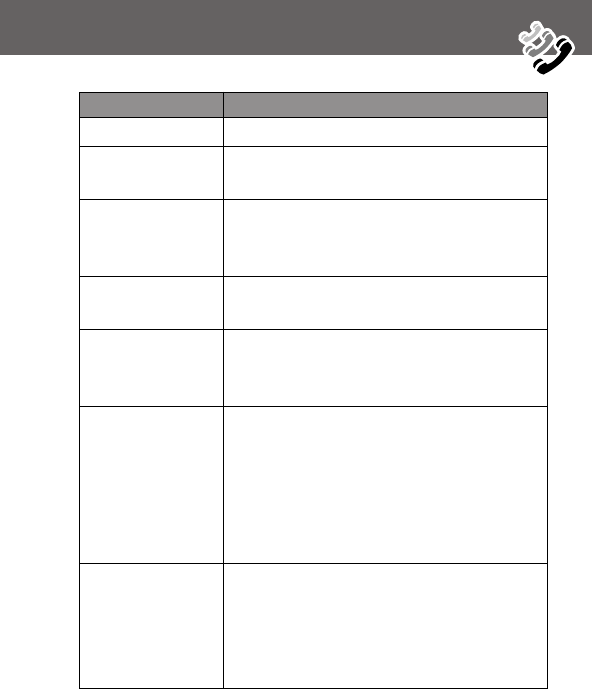
81
Recent Calls
Delete All Delete all entries in the current list.
Hide ID/Show ID Hide (or show) your caller ID for the next
call.
Send Message Create a new text message, with the
selected number in the Tel No. field. See
“Sending a Text Message” on page 117.
Add Digits Add digits to the end of the selected
number.
Attach Number Attach another number from the
phonebook or recent calls list to the end of
the selected number.
Send Tones Send the selected number to the network
as DTMF tones, for credit card calling or
password entry. (This option is available
only during an active call.)
To activate DTMF tones, see the “DTMF”
item on page 76.
Talk then Fax Tell the network you want to call and talk
to someone, and then send a fax—all to
the same number in the same call. See
“Sending a Talk then Fax Call” on
page 152.
Option Description
User.Guide.GSM.book Page 81 Wednesday, January 9, 2002 2:30 PM

Recent Calls
82
Using the Notepad
Your phone uses a notepad to store the most recent string of
digits entered—either for a phone number that you called or for
a number that you entered but did not call.
To call the number, create a phonebook entry, or perform other
operations with the number stored in the notepad:
Find the Feature
M > Recent Calls > Notepad
Press To
N
or
M
or
STORE (J)
call the number
open the Dialing Menu (to attach a
number or insert a special character)
See “Additional Dialing Features” on
page 41.
create a new phonebook entry, with
the notepad number copied into the
No. field.
See “Storing a Phonebook Entry” on
page 88.
User.Guide.GSM.book Page 82 Wednesday, January 9, 2002 2:30 PM
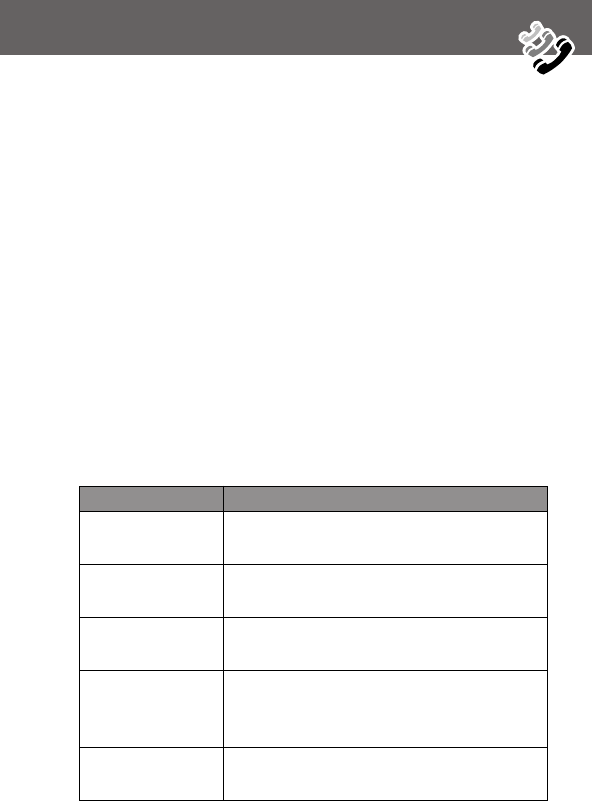
83
Recent Calls
Viewing and Resetting Call Timers
Your phone tracks and records call times. Use the recent calls
menu to view and reset a call timer.
Network connection time
is the elapsed time from the moment
you connect to your service provider’s network to the moment
you end the call by pressing O. This time includes busy signals
and ringing.
The amount of network connection time you track on
your resettable timer may not equal the amount of time
for which you are billed by your service provider. For
billing information, please contact your service provider
directly.
You can view the approximate network connection time elapsed
during the following calls:
Timer Description
Last Call Time spent on the last call dialed or
received. You cannot reset this timer.
Dialed Calls Total time spent on dialed calls since the
last time you reset this timer.
Received Calls Total time spent on calls received since the
last time you reset this timer.
All Calls Total time spent on dialed and received
calls since the last time you reset this
timer.
Lifetime Total time spent on all calls on this phone.
You cannot reset this timer.
User.Guide.GSM.book Page 83 Wednesday, January 9, 2002 2:30 PM
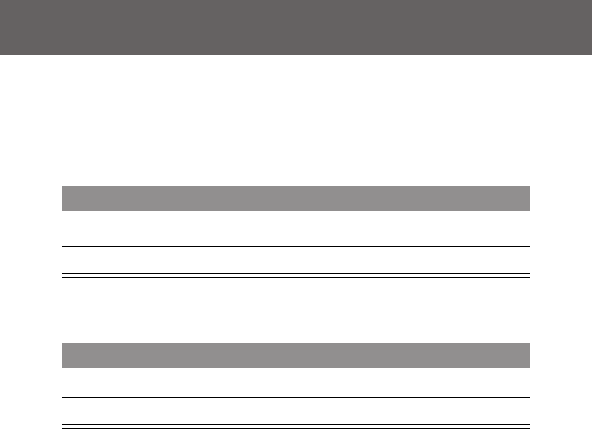
Recent Calls
84
To view a call timer:
To reset the call timer:
Find the Feature
M > Recent Calls
> Call Times
Press To
1
K scroll to the timer you want to view
2
SELECT (J) view the recorded time
Press To
1
RESET (J) reset the time (if available)
2
YES (L) confirm the reset
User.Guide.GSM.book Page 84 Wednesday, January 9, 2002 2:30 PM
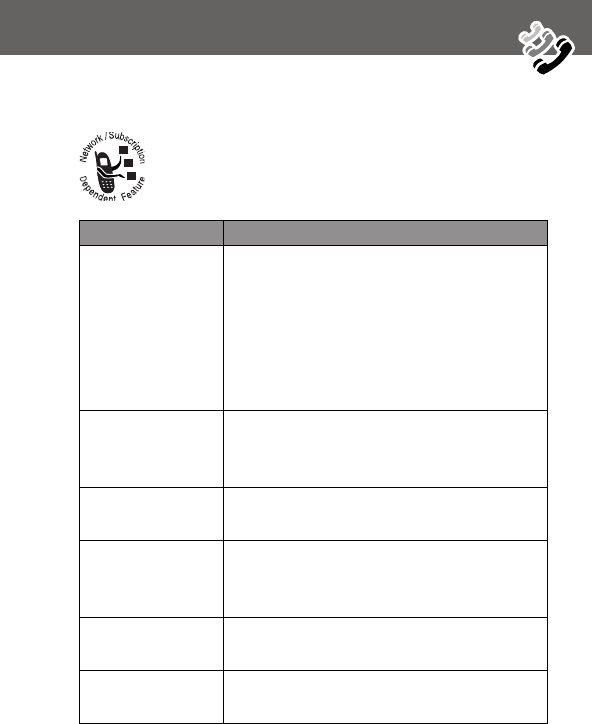
85
Recent Calls
Viewing and Resetting Call Costs
Your phone network can provide the following cost
information:
Cost Tracker Description
Credit
Available
Amount of your credit remaining.
For GSM advice-of-charge, this is only
available if you set a credit limit.
Note: Your phone receives cost
information from the advice-of-charge
feature or third-party prepay software.
Expiration Date Date that the available credit expires
(available only with a subscription to a
prepay option).
Last Deposit Amount of the last deposit (available only
with a subscription to a prepay option).
Last Call Amount spent on the last call you dialed
or received. You cannot reset this cost
tracker.
Dialed Calls Amount spent on calls you dialed since the
last time you reset this cost tracker.
Received Calls Amount spent on calls you received since
the last time you reset this cost tracker.
User.Guide.GSM.book Page 85 Wednesday, January 9, 2002 2:30 PM

Recent Calls
86
To view a cost tracker:
To reset the cost tracker:
All Calls Amount spent on all dialed and received
calls since the last time you reset this cost
tracker.
You can reset this value separate from
Dialed Calls and Received Calls, so
Dialed Calls plus Received Calls may
not equal All Calls.
Find the Feature
M > Recent Calls
> Call Cost
Press To
1
K scroll to the cost tracker you want to
view
2
SELECT (J) view the recorded cost
Press To
1
RESET (J) reset the cost (if available)
2
OK (L) enter your PIN2 code to confirm the
reset
Cost Tracker Description
User.Guide.GSM.book Page 86 Wednesday, January 9, 2002 2:30 PM
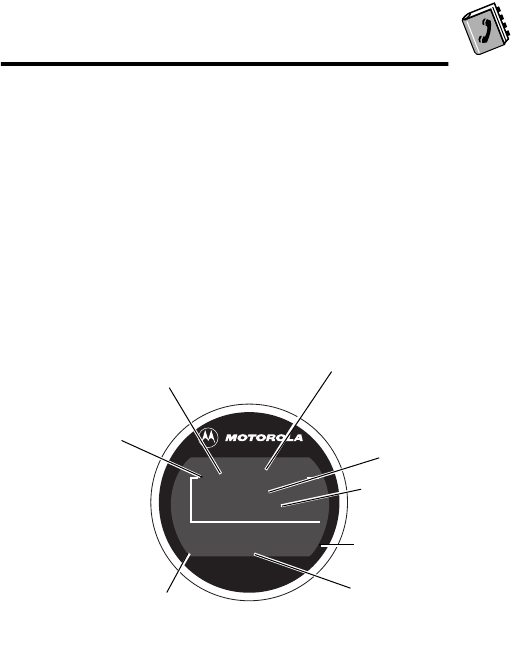
87
Phonebook
You can store a list of names and phone numbers in your
phone’s electronic phonebook. You can view these entries and
call them directly from your phone.
To see the list of names stored in your phonebook, press
M > Phonebook from the idle display. Scroll to a name and
press VIEW (J) to view details of the phonebook entry as
shown in the following display.
Fields in a Phonebook Entry Form
Note: Phonebook entries stored on the SIM card do not have
Type or Voice Name information.
$*Carlo Emrys
2154337215
Speed No. 15
BACK M EDIT
Entry’s phone
number
Type
indicator
identifies
number type:
$
Work
U
Home
S
Main
h
Mobile
Z
Fax
p
Pager
Voice Name
indicator
indicates a recorded voice name Entry’s
Name
Edit
entry
Press
M
to open
the
Phonebook
Menu
Return
to list
Entry’s speed
dial number
User.Guide.GSM.book Page 87 Wednesday, January 9, 2002 2:30 PM

Phonebook
88
Storing a Phonebook Entry
A phone number is required for a phonebook entry. All other
information is optional.
You can store a phonebook entry on your phone or on the
SIM card. Entries with a speed dial number from 1 to 500 are
stored on the phone. To store a phonebook entry on your SIM
card, assign a speed dial number of 501 or higher to the entry
when you create it. The total number of entries you can store on
the SIM card is dependent on your service provider.
Shortcut: Enter a phone number in the idle display, then press
STORE (J) to create a phonebook entry with the number in the
No. field. Go directly to step 1 in the following procedure to
enter additional information and store the entry.
Note: You can also use the following procedure to store a fixed
dial entry by scrolling to and selecting Fixed Dial.
Enter Information
Find the Feature
M > Phonebook
M > New
Press To
1
CHANGE (J) select Name
2
keypad keys enter a name for the phonebook
entry (see “Entering Text” on
page 53)
3
OK (J) store the name
4
CHANGE (J) select No.
User.Guide.GSM.book Page 88 Wednesday, January 9, 2002 2:30 PM
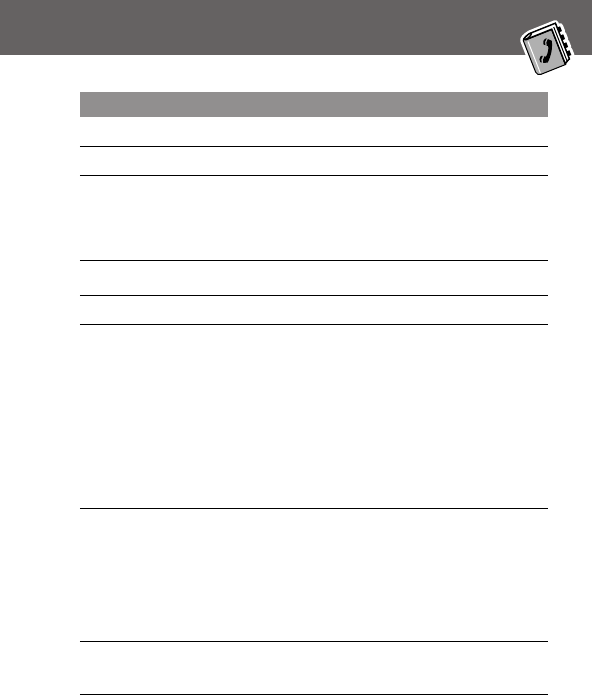
89
Phonebook
5
keypad keys enter the phone number
6
OK (J) store the phone number
7
CHANGE (J) select Type
Note: This option is not available for
entries stored on a SIM card.
8
K scroll to the type of phone number
9
SELECT (J) select the number type
10
RECORD (J)
or
Go to step 11 if
you do not want
to record a voice
name for the
entry
record a Voice Name for the entry, if
desired
See “Recording a Voice Name For a
Phonebook Entry” on page 91.
Note: This option is not available for
entries stored on a SIM card.
11
K scroll to Speed No., the number to
speed dial
the entry
The next available speed dial number
is assigned to a new phonebook
number by default.
12
CHANGE (J) select Speed No. if you want to
change it
Press To
User.Guide.GSM.book Page 89 Wednesday, January 9, 2002 2:30 PM

Phonebook
90
Complete Phonebook Entry
When you are finished entering information for a phonebook
entry:
13
keypad keys enter a different speed number, if
desired
Note: Entries with a speed dial
number from 1 to 500 are stored on
the phone. Entries with a speed dial
number of 501 or higher are stored
on the SIM card.
14
OK (J) save the modified speed number
If your chosen speed number is
already assigned to another entry,
you are asked if you want to replace
that entry.
15
SELECT (J) select MORE if you want to create
another entry with the same Name
Note: You must enter a name and
number to use this option.
Press To
DONE (L) store the entry and return to the
phonebook list
Press To
User.Guide.GSM.book Page 90 Wednesday, January 9, 2002 2:30 PM

91
Phonebook
Recording a Voice Name For a
Phonebook Entry
You can record a voice name when you create a new phonebook
entry, or when you edit a previously stored phonebook entry. This
lets you use voice dial to call the number without dialing (see
“Voice Dial Using a Soft Key” on page 93).
Note: You cannot record a voice name for an entry stored on a
SIM card.
Tip: Make your voice recording in a quiet location. Hold the
phone about four inches (10 centimeters) from your mouth, and
speak directly into the phone’s microphone in a normal tone of
voice.
Find the Feature
M > Phonebook
Do This To
1
Press K scroll to the entry that needs a
voice name
2
Press VIEW (J) display the entry’s detailed view
3
Press EDIT (J) edit the phonebook entry
4
Press K scroll to Voice Name
5
Press RECORD (J) begin the recording process
The phone displays Press
RECORD Key then say name.
User.Guide.GSM.book Page 91 Wednesday, January 9, 2002 2:30 PM

Phonebook
92
Dialing a Phonebook Entry
You can use the phonebook list, voice dial, speed dial, or
1-touch dial to call a number stored in your phonebook. To use
speed dial, see “Dialing With Speed Dial” on page 39. To use
1-touch dial, see “Dialing With 1-Touch Dial” on page 40.
Phonebook List
To call a number in the phonebook list:
6
Press and release
RECORD (J) and say
the entry’s name (in
two seconds)
record the voice name
The phone displays Press
RECORD Key then REPEAT
name.
7
Press the voice key and
repeat the name
confirm the voice name
The phone displays Trained:
Voice Name.
Find the Feature
M > Phonebook
Press To
1
K scroll to the entry you want to call
2
N send the call
Do This To
User.Guide.GSM.book Page 92 Wednesday, January 9, 2002 2:30 PM

93
Phonebook
Voice Dial Using a Soft Key
To call a number using voice dial via a soft key:
To pre-record a phonebook entry name, see “Recording a Voice
Name For a Phonebook Entry” on page 91.
Voice Dial Using the Menu
To call a number using voice dial via the menu:
Do This Result
Press and release L
and speak the entry’s
pre-recorded name
(within two seconds).
Your phone goes to the entry in
the phonebook list, repeats the
voice name, pauses two seconds,
then automatically dials the call.
Find the Feature
M > Voice Dial
Do This To
1
Press SELECT (J) activate the voice dial
mechanism
the phone displays Say Name
Now
2
Say the pre-recorded
phonebook entry name to select the entry to be dialed
User.Guide.GSM.book Page 93 Wednesday, January 9, 2002 2:30 PM

Phonebook
94
Editing a Phonebook Entry
You can edit a phonebook entry stored on your phone or the SIM
card.
Notes:
• If you change an entry’s speed dial number, the entry is
moved to the new speed dial location and the original entry
is deleted. Entries with a speed dial number from 1 to 500
are stored on the phone. Entries with a speed dial number
of 501 or higher are stored on the SIM card.
• You can also use the following procedure to edit a fixed dial
entry by scrolling to and selecting Fixed Dial.
Edit a phonebook entry or fixed dial entry by following the
procedures described in “Storing a Phonebook Entry” on
page 88.
Find the Feature
M > Phonebook
Press To
1
K scroll to the entry you want to edit
2
VIEW (J) display the entry’s detailed view
3
EDIT (J) edit the phonebook entry
User.Guide.GSM.book Page 94 Wednesday, January 9, 2002 2:30 PM
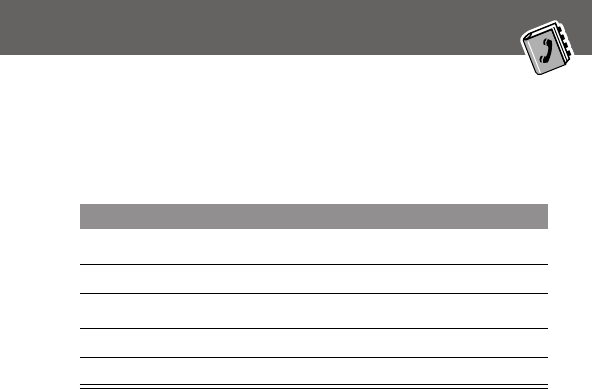
95
Phonebook
Deleting a Phonebook Entry
To delete a phonebook entry:
Copying Phonebook Entries Between
the Phone and SIM Card
You can copy one or more phonebook entries from your phone
to the SIM card or from the SIM card to your phone.
Notes:
• This procedure copies the original entry to a new location. It
does
not
delete the original entry.
• The SIM card cannot store Type and Voice Name data for
entries. If you try to copy an entry with a type or voice name
to the SIM card, the phone asks you for confirmation before
dropping this information and copying the entry.
Find the Feature
M > Phonebook
Press To
1
K scroll to the entry you want to delete
2
M open the Phonebook Menu
3
K scroll to Delete
4
SELECT (J) select Delete
5
YES (L) confirm the deletion
User.Guide.GSM.book Page 95 Wednesday, January 9, 2002 2:30 PM

Phonebook
96
Copy a Single Entry
To copy a single phonebook entry from your phone to the SIM
card or from the SIM card to your phone:
Find the Feature
M > Phonebook
Press To
1
K scroll to the entry you want to copy
Note: Entries with a speed dial
number from 1 to 500 are stored on
the phone. Entries with a speed dial
number of 501 or higher are stored
on the SIM card.
2
M open the Phonebook Menu
3
K scroll to Copy Entry
4
SELECT (J) select Copy Entry
The phone displays the Copy To
form, with the next available speed
dial number.
5
keypad keys edit the speed dial number on the
Copy To form
6
OK (J) approve the copy to the speed dial
number
The phone displays the Stored
message. You can now delete the old
phonebook entry, if desired.
User.Guide.GSM.book Page 96 Wednesday, January 9, 2002 2:30 PM

97
Phonebook
Copy Multiple Entries
To copy multiple phonebook entries from your phone to the SIM
card or from the SIM card to your phone:
Find the Feature
M > Phonebook
Press To
1
M open the Phonebook Menu
2
K scroll to Copy Entries
3
SELECT (J) select Copy Entries
The phone displays the Copy Entries
form.
4
K scroll to From (start)
5
CHANGE (J) select From (start)
6
keypad keys enter the first (lowest) speed dial
number in the range of entries that
you want to copy
Note: Entries with a speed dial
number from 1 to 500 are stored on
the phone. Entries with a speed dial
number of 501 or higher are stored
on the SIM card.
7
OK (J) store the number and return to the
Copy Entries form
8
K scroll to From (end)
9
CHANGE (J) select From (end)
User.Guide.GSM.book Page 97 Wednesday, January 9, 2002 2:30 PM
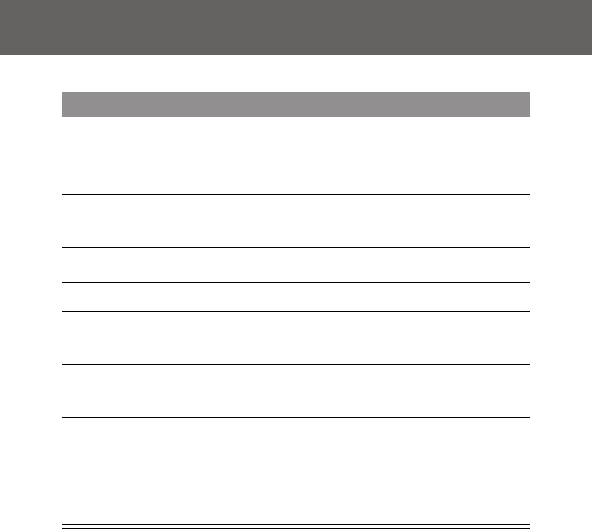
Phonebook
98
10
keypad keys enter the last (highest) speed dial
number in the range of entries that
you want to copy
11
OK (J) store the number and return to the
Copy Entries menu
12
K scroll to To (start)
13
CHANGE (J) select To (start)
14
keypad keys enter the first (lowest) new speed dial
number for the entries’ new location
15
OK (J) store the number and return to the
Copy Entries menu
16
DONE (L) copy the entries
The phone displays the
Copied Entries message. You can
now delete the old entries, if desired.
Press To
User.Guide.GSM.book Page 98 Wednesday, January 9, 2002 2:30 PM

99
Phonebook
Checking Phonebook Capacity
You can check phonebook capacity to see how much space is left
for storing phonebook entries on your phone and on the SIM
card. For entries stored on the phone, your phone displays a
memory meter that shows how much memory space remains to
store phonebook and datebook entries. For the SIM card, your
phone lists the number of phonebook entries used and the
number available.
Synchronizing with TrueSync Software
You can synchronize phonebook entries between your
phone and computer or hand-held device with Starfish
TrueSync® software, a Motorola accessory product. See
the TrueSync user guide for more information.
Note: TrueSync software is designed to synchronize with basic
features of many popular Personal Information Management
(PIM) software and hardware products.
Find the Feature
M > Phonebook
Press To
1
M open the Phonebook Menu
2
K scroll to Phone Capacity
3
SELECT (J) select Phone Capacity
Your phone displays the phone
memory meter, or the number of SIM
card phonebook entries available.
User.Guide.GSM.book Page 99 Wednesday, January 9, 2002 2:30 PM

Phonebook
100
Setting Up the Phonebook
You can specify the sort order for your phonebook entries and
the location of your 1-touch dial entries.
Phonebook List Sort Preference
You can set up your phone to sort your phonebook list by speed
dial number (the standard), name, or voice dial.
Tip: The voice dial sort is identical to the name sort, except that
the entries with voice name tags appear first.
Find the Feature
M > Phonebook
Press To
1
M open the Phonebook Menu
2
K scroll to Setup
3
SELECT (J) select Setup
4
K scroll to Sort by
5
CHANGE (J) select Sort by
6
K scroll to the entry you want
7
SELECT (J) select the entry you want
User.Guide.GSM.book Page 100 Wednesday, January 9, 2002 2:30 PM
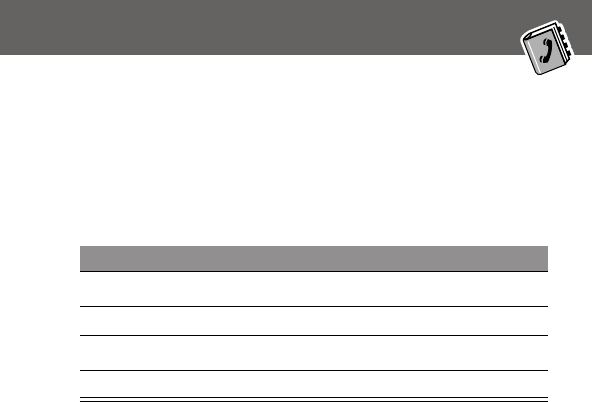
101
Phonebook
1-Touch Dial Preference
Your phone lets you specify whether your 1-touch dial entries are
located on the phone or the SIM card:
Find the Feature
M > Settings > Other Settings
> Initial Setup
Press To
1
K scroll to 1-Touch Dial
2
CHANGE (J) select 1-Touch Dial
3
Kscroll to the list you want
4
SELECT (J) select the list you want
User.Guide.GSM.book Page 101 Wednesday, January 9, 2002 2:30 PM
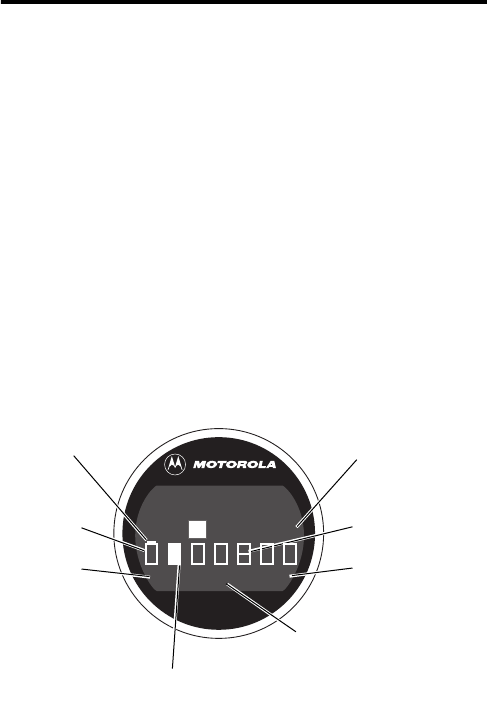
102
Datebook
The datebook is a calendar that lets you schedule and organize
events such as appointments and meetings. You can review your
schedule of events for the week or by the day, and have the
datebook play a reminder alarm for specific events.
Note: You must set the correct time and date in order to use the
datebook. Use the Time and Date feature (see page 74) to set
the time and date.
To schedule or review events in the datebook:
Week View
When you open the datebook, your phone displays a calendar
for the week. Lines or filled boxes under each day indicate
scheduled events.
Find the Feature
M > Datebook
Go to
selected day
Exit the
datebook
Untimed
event
12 hour
window One-hour event
Days of week
(press
*
(
left) o
r
#
(
right)
to
select)
Full day
(12-hour)
event scheduled
Press
M
to open
the
Datebook Menu
EXIT VIEW
{15 NOV-21 NOV
S M T W T F S
M
User.Guide.GSM.book Page 102 Wednesday, January 9, 2002 2:30 PM
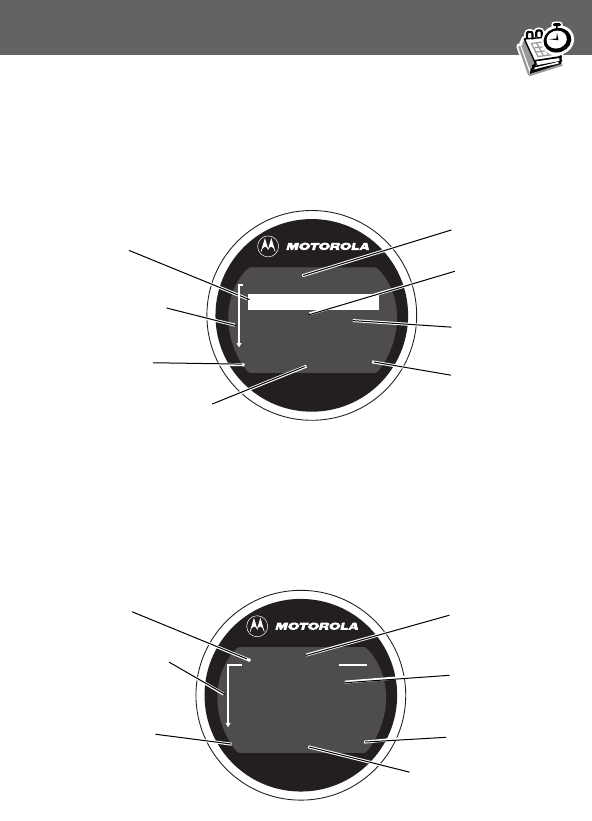
103
Datebook
Day View
Select a day in the week view and press VIEW (J) to see the
day’s events. You can store, edit, view, copy, and delete any
event from the day view.
Event View
Select an event in the day view and press VIEW (J) to open the
detailed event view. You can edit, copy, and delete events from
the event view.
Day of week
Show event
details
Return to
previous screen
Untimed
event Alarm
Event
Down scroll
arrow
Press
M
to open
the
Datebook Menu
{THU 19-NOV }
• Joe's B-day
9:00 A Marie,...
BACK VIEW
M
Day and time
Edit eventReturn to
previous screen
Event details
Alarm
Down scroll
arrow
Press
M
to open
the
Datebook
Menu
A THU 9:00 am
Marie, mtg about
new product
BACK EDIT
M
User.Guide.GSM.book Page 103 Wednesday, January 9, 2002 2:30 PM

Datebook
104
Storing a New Event
A title is required for a datebook event. All other information is
optional.
See “Selecting a Feature” on page 50 for instructions on
scrolling to and selecting options.
Find the Feature
M > Datebook >
day
M > New
Press To
1
CHANGE (J) select Title
2
keypad keys enter a title for the event (see
“Entering Text” on page 53)
3
OK (J) store the event title
4
K scroll to other fields and enter
information as necessary
Other fields let you enter start time,
duration, date, repeating events, and
reminder alarm.
5
DONE (L) store the new event and return to the
day view
User.Guide.GSM.book Page 104 Wednesday, January 9, 2002 2:30 PM
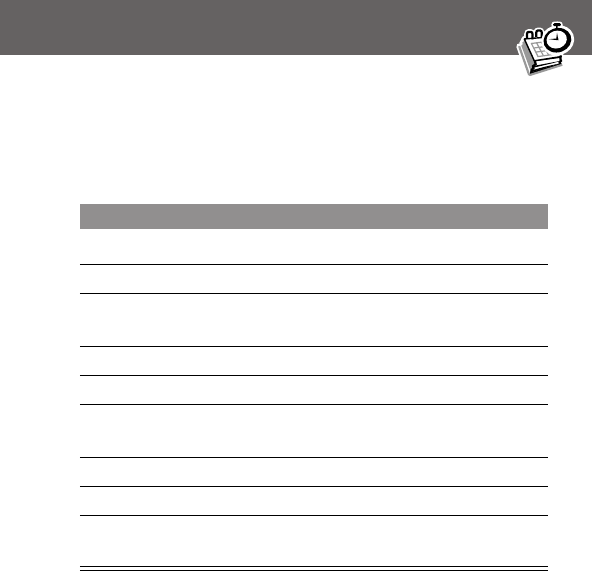
105
Datebook
Changing Event Information
To change information about an existing event:
Find the Feature
M > Datebook
Press To
1
K scroll to the scheduled event day
2
VIEW (J) display the day view
3
K scroll to the event you want to
change
4
VIEW (J) display the event view
5
EDIT (J) edit the event
6
Kscroll to the detail you want to
change
7
CHANGE (J) edit the information
8
keypad keys enter the new information
9
DONE (L) store the information and return to
the day view
User.Guide.GSM.book Page 105 Wednesday, January 9, 2002 2:30 PM

Datebook
106
Copying an Event
To copy information from a current event to a new event:
Find the Feature
M > Datebook
Press To
1
Kscroll to the scheduled event day
2
VIEW (J) display the day view
3
K scroll to the event to copy
4
M open the Datebook Menu
5
K scroll to Copy
6
SELECT (J) copy the event
7
YES (J) confirm the copy
Your phone assumes that you want to
change the date, and displays the
Date field.
8
keypad keys enter the date information
9
} (J)move to the month, day, and year
10
DONE (L) save the copy of the event
11
K scroll to event details and edit the
information as necessary
12
DONE (L) store the new event and return to the
day view
User.Guide.GSM.book Page 106 Wednesday, January 9, 2002 2:30 PM
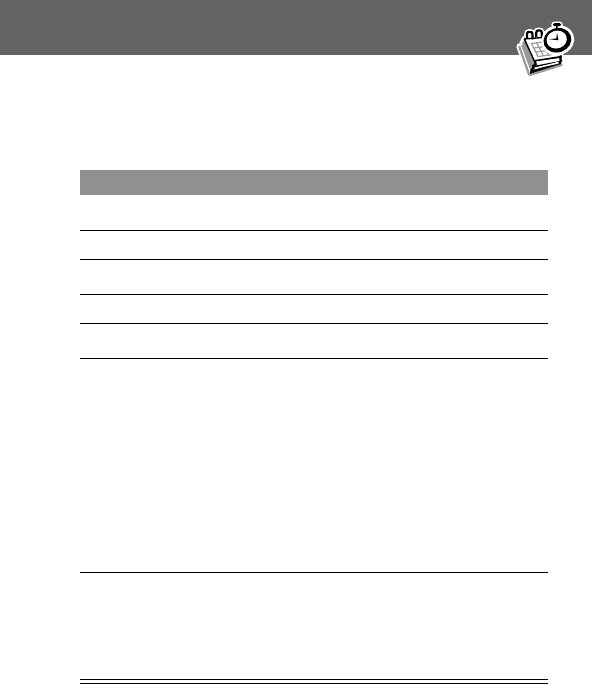
107
Datebook
Deleting an Event
Find the Feature
M > Datebook
Press To
1
Kscroll to the scheduled event day
2
VIEW (J) display the day view
3
K scroll to the event to delete
4
M open the Datebook Menu
5
K scroll to Delete
6
SELECT (J) select Delete
For non-repeating events, go to
step 7. For repeating events, the
phone displays a delete event
menu:
a
K scroll to This Event Only or
Repeat Events
b
SELECT (J) select the event(s) to delete
7
YES (L) confirm the deletion
The phone briefly displays a
Deleted: message and returns you
to the day view.
User.Guide.GSM.book Page 107 Wednesday, January 9, 2002 2:30 PM

108
Radio
You can use your phone to tune, store presets, and listen
to FM radio stations when you use the optional Motorola
Original™ FM Stereo Radio Headset with your phone.
Turning the Radio On and Off
Note: The Radio (J) soft key option appears only when the
FM Stereo Radio Headset is plugged into the accessory
connector port.
Tuning a Station
Press To
Radio (J) turn the radio on and off
Do This To
Press K
or
Press and hold K
scroll up or down to the next
frequency
scroll up or down to the next
available stereo station
User.Guide.GSM.book Page 108 Wednesday, January 9, 2002 2:30 PM

109
Radio
Storing a Preset
To store a station to a preset that you can recall later:
Selecting a Preset
To select a preset radio station:
Sending and Receiving Calls With the
Radio On
Your phone interrupts the radio signal and rings or vibrates as
usual to notify you of an incoming call, message, or other event.
When you receive a call:
Do This To
Press and hold a number
key (1 to 9)
assign its preset number to the
tuned station
Press To
a number key (1 to 9) tune the station stored at that
preset location
Do This To
Press IGNORE (L) ignore the call
Press ANSWER (J)
or
Press the button on the
FM Stereo Radio Headset
microphone
answer the call
Note: You can use the FM
Stereo Radio Headset
microphone to converse with
the other party during a call
User.Guide.GSM.book Page 109 Wednesday, January 9, 2002 2:30 PM

Radio
110
To end the call and resume the FM broadcast:
Turn the radio off before dialing outgoing calls. You do not have
to turn off the FM radio feature to dial emergency numbers or
numbers selected from your phonebook or other lists.
Tip: To dial a recently called number, press N or the button on
the FM Stereo Radio Headset microphone to go to the dialed
calls list. For more information, see “Recent Calls” on page 79.
Do This To
Press O
or
Press and hold the button
on the FM Stereo Radio
Headset microphone
end the call
User.Guide.GSM.book Page 110 Wednesday, January 9, 2002 2:30 PM
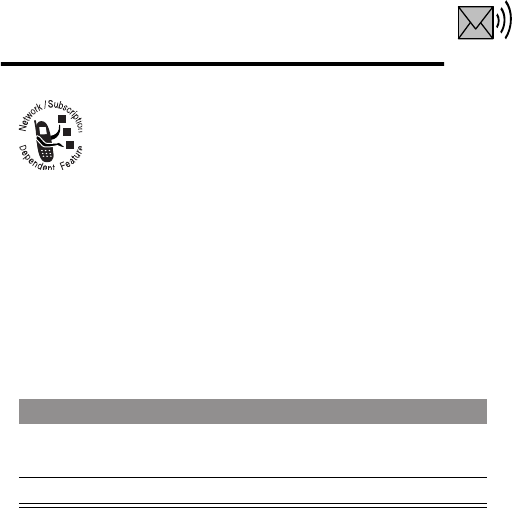
111
Messages—Voicemail
You can listen to your voicemail messages by calling
your network voicemail phone number. Voicemail
messages are stored on the network—not on your
phone. Contact your service provider for more details.
Storing Your Voicemail Number
Store your voicemail number in your phone to make it faster and
easier to use voicemail. Your voicemail number is provided by
your service provider.
Receiving a New Voicemail Message
When you receive a voicemail message, your phone displays
New VoiceMail &. (Some networks only indicate when you
have messages, whether they are new or not.) If reminders are
turned on, your phone sends a reminder every five minutes until
you close the new message notification, listen to the message, or
turn off your phone. (See “Reminders” on page 140.)
Find the Feature
M > Messages
M > VoiceMail Setup
Press To
1
keypad keys enter the phone number for your
voicemail
2
OK (J) store the number
User.Guide.GSM.book Page 111 Wednesday, January 9, 2002 2:30 PM

Messages—Voicemail
112
From the new message notification:
Listening to a Voicemail Message
To listen to your voicemail messages at any time:
Your phone calls the voicemail phone number you stored. If you
do not have a voicemail number stored, the phone guides you
through storing a number.
Do This To
Press CALL (J) call your voicemail phone number
and listen to the message
Find the Feature
M > Messages > VoiceMail
User.Guide.GSM.book Page 112 Wednesday, January 9, 2002 2:30 PM
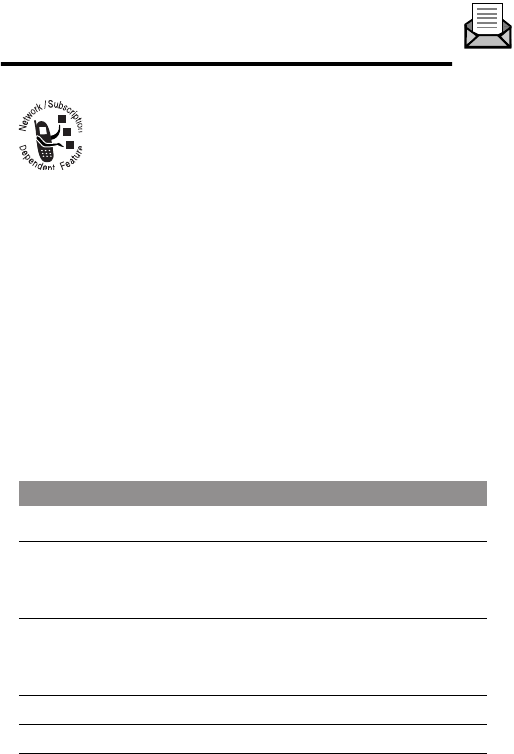
113
Messages—Text
Text messages are brief messages that you can send
and receive (such as Where are we meeting?).
Received messages appear on your phone display or in
your text message inbox.
You must set up the text message inbox
before
you can send and
receive these messages. The total number of messages the inbox
can hold depends on the length of the messages, and the
number of other messages and drafts stored in your phone.
Note: Your service provider may have already programmed the
text message inbox settings for you.
Setting Up the Text Message Inbox
Find the Feature
M > Messages
M > Text Msg Setup
Press To
1
K scroll to Srvce Center No.
2
CHANGE (J) change the Srvce Center No.
which is provided by your service
provider
3
keypad keys enter the phone number for the
service center that handles your
outgoing messages
4
OK (J) store your service center number
5
CHANGE (J) change the Expire After period
User.Guide.GSM.book Page 113 Wednesday, January 9, 2002 2:30 PM

Messages—Text
114
6
keypad keys enter the expiration period—the
number of days your network tries to
send unreceived messages
7
OK (J) store the expiration period
8
CHANGE (J) change the Reply Type
9
K scroll to the default type of replies
you want to send—text messages, or
other formats
10
OK (J) store the reply type
11
CHANGE (J) change the Cleanup setting
12
K scroll to the period of time that
messages stay in your inbox
13
SELECT (J) select the cleanup period
If you select Custom, continue.
Otherwise, the procedure is
complete.
14
K change the entry for the number or
label
15
Kswitch between the number and the
label
16
DONE (L) store the custom cleanup period after
you finish entering all information
Press To
User.Guide.GSM.book Page 114 Wednesday, January 9, 2002 2:30 PM

115
Messages—Text
Receiving a Text Message
Note: You must set up the text message inbox before you can
receive text messages. See “Setting Up the Text Message Inbox”
on page 113.
When you receive a new message, your phone displays New
Message X and gives an alert. If reminders are turned on, your
phone sends a reminder every five minutes until you close the
new message notification, read the message, or turn off your
phone. (See “Reminders” on page 140.)
When your inbox is full, any new message replaces the oldest
unlocked message.
From the new message notification:
Reading, Locking, or Deleting a Text
Message
You can open your text message inbox to read, lock, or delete
messages at any time.
Messages in the text message inbox are sorted from newest to
oldest. The oldest messages are deleted as new ones are added.
If you want to save a message, you should lock it to prevent it
from being overwritten as new messages are received.
Press To
READ (J) open the message (or your text
message inbox if there are multiple
messages)
User.Guide.GSM.book Page 115 Wednesday, January 9, 2002 2:30 PM
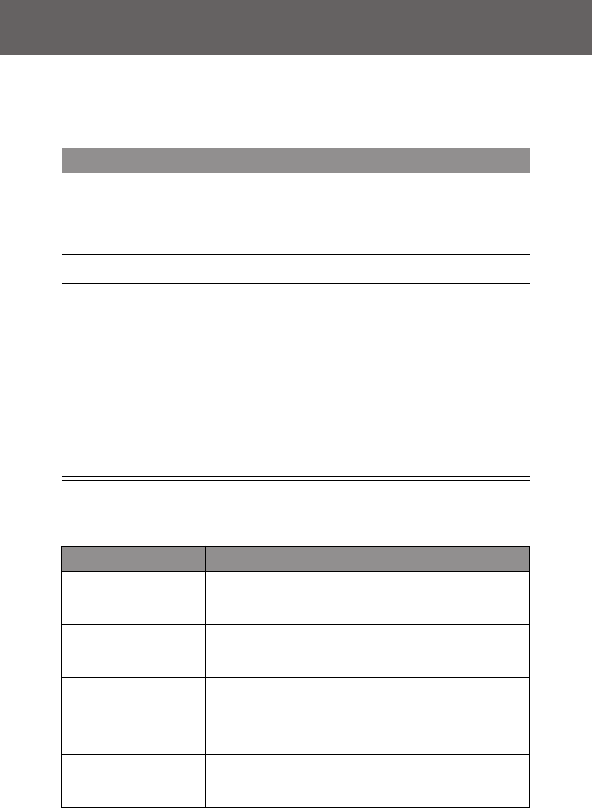
Messages—Text
116
The Text Msg Menu includes the following options:
Find the Feature
M > Messages > Text Msgs
Press To
1
K scroll to the message you want
(d = unread and urgent,
n = read, f = read and locked)
2
READ (J) open the message
3
SAVE (J—right)
or
DELETE (L—left)
or
M
close the message without changes
delete the message
open the Text Msg Menu to
perform other procedures as
described in the following list
Option Description
Call Back Call the number in the message header or
the message text.
Go To Go to a Web address (URL) in the
message.
Reply Open a new text message, with the
message’s Reply To number in the To
field.
Forward Open a copy of the text message, with an
empty To field.
User.Guide.GSM.book Page 116 Wednesday, January 9, 2002 2:30 PM
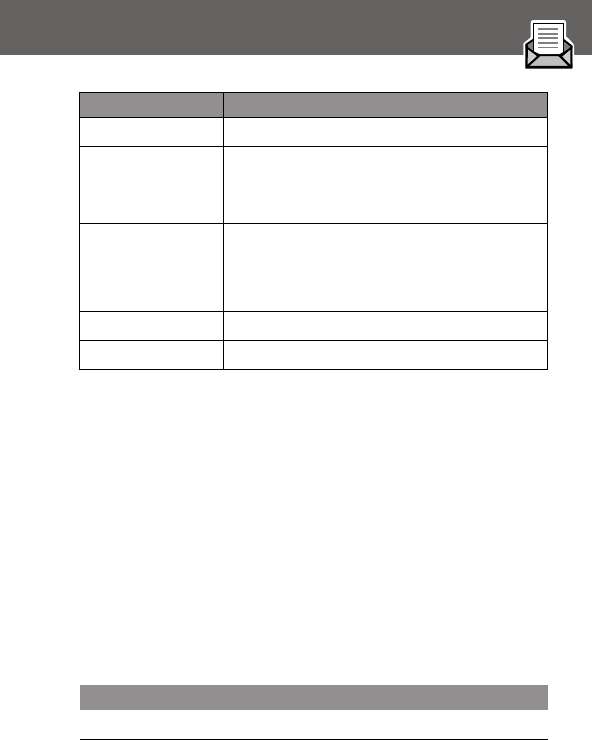
117
Messages—Text
Sending a Text Message
You can create and send a text message to one or more
recipients. The text message feature lets you manually enter each
recipient’s phone number, or select one or more numbers from
the phonebook or recent calls lists.
Note: When you manually enter multiple phone numbers in the
To field, you must insert a space between each number. Press
and hold 1 to insert a space as needed.
Lock/Unlock Lock or unlock the message.
Store Number Open a new phonebook entry with the
message’s embedded number in the No.
field.
Delete
or
Delete All
Delete the message or all inbox messages.
Press Yes (L) to confirm the deletion.
Create Message Open a new text message form.
Setup Open the inbox setup menu.
Find the Feature
M > Messages
M > Create Message
Press To
1
CHANGE (J) select To
Option Description
User.Guide.GSM.book Page 117 Wednesday, January 9, 2002 2:30 PM

Messages—Text
118
2
keypad keys
or
BROWSE (J)
enter one or more phone numbers
where you want to send the message
Tip: Remember to press and hold
1 to add a space between numbers
that you enter manually.
select one or more phone numbers
from the phonebook or recent calls
lists
3
OK (J) store the number(s)
4
CHANGE (J) select Msg
5
keypad keys enter the text message (see “Entering
Text” on page 53)
Note: Message length is limited.
When 40 or fewer characters remain,
a two-digit counter at the top of the
display shows how many are left.
6
OK (J) store the text message
7
DONE (L) finish the message
Your phone displays
Send Message Now?
Press To
User.Guide.GSM.book Page 118 Wednesday, January 9, 2002 2:30 PM

119
Messages—Text
Viewing the Status of Sent Text
Messages
Text messages that you send are stored in the outbox. To view
the contents of your outbox:
Messages are sorted from newest to oldest.
The following icons indicate message status:
8
YES (J)
or
NO (L)
send the message
cancel the message or save it as a
draft
A saved message is stored in the
drafts folder, where you can edit it
and send it at a later time.
Find the Feature
M > Messages > Outbox
á = sending in progress Y = delivered
m = sending failed
Press To
User.Guide.GSM.book Page 119 Wednesday, January 9, 2002 2:30 PM

120
Shortcuts
Your phone includes several pre-programmed shortcuts. You can
create additional shortcuts, if you like, to mark frequently used
menu items.
Standard Shortcuts
The following shortcuts are pre-programmed in your phone. You
cannot edit or delete these shortcuts.
User-Settable Shortcuts
You can create shortcuts to many menu features and
applications. A shortcut takes you directly to the menu item, or
performs the menu action (if applicable).
Do This To
Press M, then press
and hold M (within
two seconds)
zoom in/out your phone’s display
view
(See “Changing the Zoom Setting”
on page 30.)
Press M #display your phone number
Press Ngo to the dialed calls list
(See “Recent Calls” on page 79.)
Press Oexit the menu system, return to the
idle display
User.Guide.GSM.book Page 120 Wednesday, January 9, 2002 2:30 PM

121
Shortcuts
Creating a Shortcut
To assign a keypad shortcut:
Do This To
1
Press Menter the menu system
2
Scroll to the item to
which you want to
assign a shortcut
highlight the menu item
3
Press and hold Mopen the shortcut editor
The phone displays:
Assign Shortcut for:
“
Item
”?
where
Item
is the name of the
item you selected.
4
Press YES (L) view shortcut options
5
Press CHANGE (J)
or
Press DONE (L)
change the keypad shortcut
number, if necessary
select the default keypad
shortcut number and close the
shortcut editor
User.Guide.GSM.book Page 121 Wednesday, January 9, 2002 2:30 PM

Shortcuts
122
Using Shortcuts
You can use a shortcut from the idle display, while on a call, or
while scrolling through a menu.
Use a Keypad Shortcut
If you know the shortcut number:
Select a Shortcut From the List
To select a shortcut from the shortcut list:
Press To
1
M open the menu
2
the shortcut’s number go to the menu item, or perform
the menu action
Find the Feature
M > Shortcuts
>
the shortcut you want
User.Guide.GSM.book Page 122 Wednesday, January 9, 2002 2:30 PM

123
Micro-Browser
The micro-browser lets you access Web pages and
Web-based applications (such as on-line banking,
shopping, and games) on your phone. Contact your
service provider to set up access, if necessary.
Note: Your phone may be configured to use a high-speed GPRS
(General Packet Radio Service) network connection. This type of
connection can be identified by a GPRS indicator in the idle
display that disappears when you start a micro-browser session.
If a W (connected call) indicator is displayed when you start a
micro-browser session, your phone is using a standard voice
channel connection. Your network connection charges may vary
depending on the type of connection used.
Starting a Micro-Browser Session
To open the micro-browser:
The micro-browser displays the home page set up by your service
provider.
Shortcut: If you open a text message with a Web address (URL)
in it, you can go directly to the URL by selecting M > Go To.
Find the Feature
M > Browser
Press To
1
K scroll to a bookmark or service,
service, or application
2
SELECT (J) select the service
User.Guide.GSM.book Page 123 Wednesday, January 9, 2002 2:30 PM

Micro-Browser
124
If you are unable to establish a network connection with the
micro-browser, contact your service provider.
Interacting With Web Pages
You can perform the following operations on a Web page:
Do This To
Press Kscroll through a text message
Press K and then
SELECT (J)
scroll through and select items in a
list
Press keypad keys
and then OK (J)
enter requested information
Tip: Press * to delete one letter
at a time if you make a mistake.
Press K to scroll to a
phone number on a Web
page, then press N
call the number from the
micro-browser
Press * and #go back to the previous Web page
Press Mopen the Browser Menu
User.Guide.GSM.book Page 124 Wednesday, January 9, 2002 2:30 PM
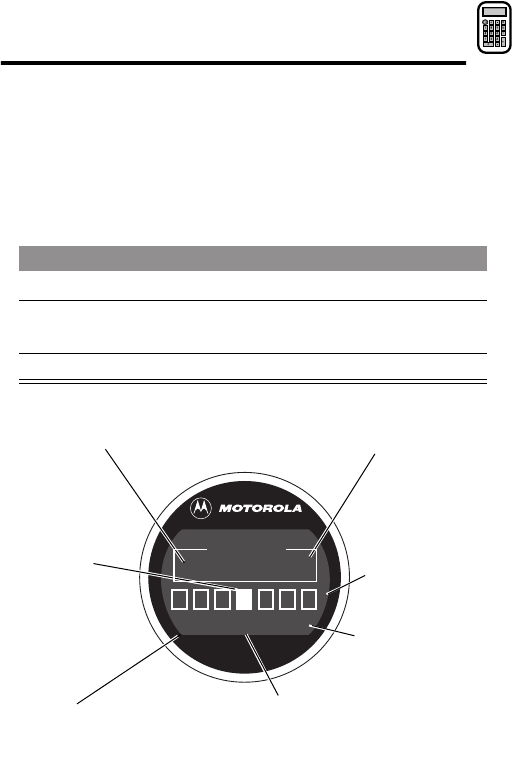
125
Calculator
You can use your phone as a convenient calculator and currency
converter.
Calculating Numbers
Find the Feature
M > Calculator
Press To
1
number keys enter a number in the calculator
2
*
(
left) or
#
(
right)
highlight a calculator function
3
SELECT (J) perform the highlighted function
Selected function
appears here
Perform the
highlighted
function
Press
M
to open
the
Calculator Menu
Exit the
calculator
Entered
number
Press
*
(
left) or
#
(
right)
to
highlight a
function and to
view unseen
functions by
scrolling left/
right
EXIT SELECT
M
.C=+-x÷
+0
}
Calculator
Press
*
(
left) or
#
(
right)
to
scroll to other
functions
User.Guide.GSM.book Page 125 Wednesday, January 9, 2002 2:30 PM
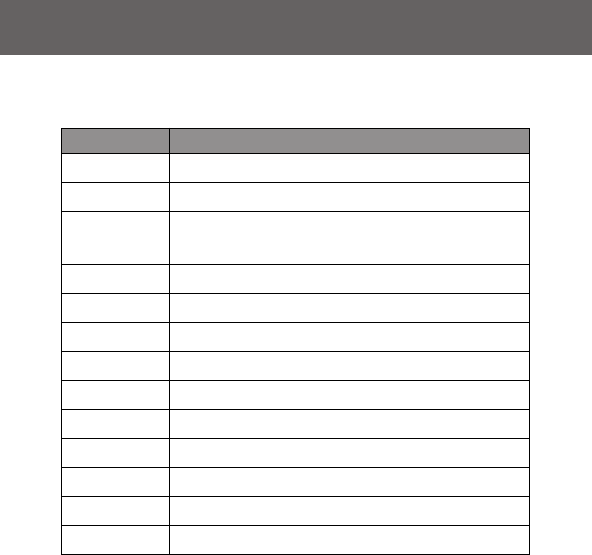
Calculator
126
The calculator can perform the following functions:
Function Description
. Insert a decimal point
C Clear the calculation
CE Clear entry (replaces the C function when you
enter subsequent values in a calculation)
+ Add
- Subtract
x Multiply
÷ Divide
% Divide the displayed value by 100
$ Calculate the exchange rate
+- Change the entry’s sign (positive/negative)
MR Recall the value stored in memory
MS Store the displayed number in memory
MC Clear memory
User.Guide.GSM.book Page 126 Wednesday, January 9, 2002 2:30 PM
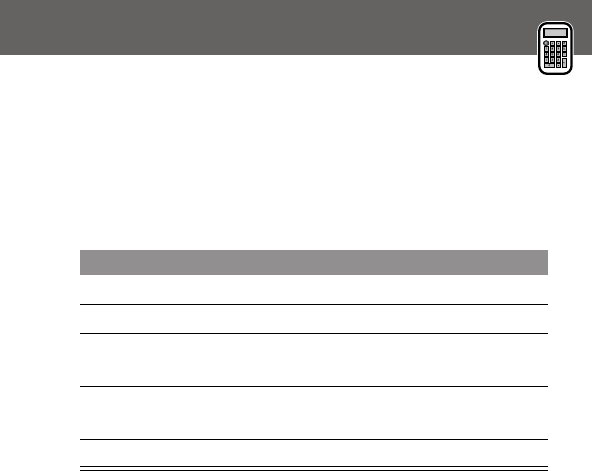
127
Calculator
Converting Currency
The currency converter works just like the calculator, but uses
the $ (currency) function:
Find the Feature
M > Calculator
M > Exchange Rate
Press To
1
number keys enter the exchange rate
2
OK (J) store the exchange rate
3
number keys enter the amount to convert (amount
to multiply by the exchange rate)
4
*
(
left) or
#
(
right)
highlight the $ function
5
SELECT (J) perform the conversion
User.Guide.GSM.book Page 127 Wednesday, January 9, 2002 2:30 PM

128
Games
Your phone contains three games that you can play between
phone calls. If you get an incoming call, message, alarm, or alert,
the game ends automatically.
Selecting and Starting a New Game
When the game is over, you can play another session of the
same game or return to the games menu.
Find the Feature
M > Games
Press To
1
K scroll to the game of your choice
2
SELECT (J) start the game
Press To
BACK (L—left)
or
NO (L—left)
return to the games menu
NEW (J—right)
or
YES (J—right)
start another session of the game you
just played
User.Guide.GSM.book Page 128 Wednesday, January 9, 2002 2:30 PM

129
Games
A
7
A
Ending a Game
You can end a game at any time.
Playing a Game
Blackjack
In this classic Las Vegas card game, you play against the dealer
to see who can get closer to 21 points without going over.
Rules of the game
• With each new hand, the first card is dealt to the dealer.
The dealer’s cards are shown at the top of the display, and
your cards are shown at the bottom.
• All face cards count as 10 points.
• All number cards count as the points shown on their face.
• An Ace counts as 11 points, unless that would put you over
21 points. Otherwise, an Ace is counted as 1 point. An Ace
that was originally counted as 11 may later be counted as 1
point if it will bring your points under or equal to 21 points.
• An initial deal of an Ace and a card with a face value of 10
points counts as exactly 21 points or Blackjack.
Press To
BACK (L)
or
O
end the game session and return to
the games menu
User.Guide.GSM.book Page 129 Wednesday, January 9, 2002 2:30 PM

Games
130
• Blackjack automatically wins against any other hand that
totals 21 points.
• If you score more than 21 points, you go “bust” or lose.
• If you get five cards without going bust, you win.
• If you and the dealer have the same score, the dealer wins.
• You can ask for a “hit” or another card as long as you do
not go bust.
• As long as the dealer’s total is less than 17 points, the
dealer must continue to take a hit.
How to Play
When the game begins, you are dealt two cards. Based on their
total face value, you can:
Mindblaster
Your goal is to guess a secret four-symbol code. You play by
entering symbols into four spaces and then submitting a guess.
Rules of the Game
• Your score is the number of guesses it takes to reveal the
secret code.
Press To
STAY (L) see the results of the hand
HIT ME (J) request another card
User.Guide.GSM.book Page 130 Wednesday, January 9, 2002 2:30 PM

131
Games
A
7
A
• When you submit a guess, you are given clues that indicate
how many symbols you have identified correctly and how
many are in the correct position. The position of the clues
does
not
correspond to the location of the symbols.
• You can see a history of your last 10 guesses.
• Once you enter a symbol into a blank space, you can
change the symbol but you cannot make the space blank
again.
• When you correctly guess the four-symbol code, the display
shows your score and the level of your next game.
• After you win one game, you progress from level 1 to
level 2.
• After you win two more games, you progress from level 2 to
level 3.
• When you exit the game or turn off the phone, you begin
again at level 1.
= correct symbol in correct position
= correct symbol in wrong position
= wrong symbol in wrong position
User.Guide.GSM.book Page 131 Wednesday, January 9, 2002 2:30 PM

Games
132
How to Play
When the game begins, you see four blank spaces. To play the
game:
Paddleball
In this test of endurance, your mission is move your paddle to
strike a bouncing ball. The more you succeed, the smaller your
paddle gets.
Rules of the game
• Your score is the number of times your paddle hits the ball.
• You lose when the paddle misses the ball.
How to play
Do This To
Press *
(
left) or
#
(
right)
move from space to space
Press K place a symbol in a space
Press GUESS (K)submit a guess (when all four spaces
contain symbols)
Select > and then
press K
scroll through and view a history of
your last 10 guesses
Press To
K move your paddle so that it hits the
bouncing ball
User.Guide.GSM.book Page 132 Wednesday, January 9, 2002 2:30 PM

133
Adjusting Your Settings
You can adjust a wide variety of phone settings to suit your
needs.
Ring/Vibrate
Your phone rings or vibrates to notify you of an incoming call,
message, or other event. This ring or vibration is called an
alert
.
You can select one of five different alert profiles:
The alert setting indicator in your display shows the current alert
profile (see illustration on page 28).
Each alert profile contains settings for ringer and keypad volume.
It also includes alert tone settings for different events: incoming
calls, text messages, voicemail messages, data calls, fax calls,
alarms, and reminders. You can modify the settings in each
profile.
Select an Alert Profile
w Loud ring x Soft ring
y Vibrate u Ring and vibrate
t Silent
Find the Feature
M > Settings > Ring/Vibrate
> Alert
Press To
1
K scroll to the alert profile you want to
use
User.Guide.GSM.book Page 133 Wednesday, January 9, 2002 2:30 PM

Adjusting Your Settings
134
Customize an Alert Profile
You can customize a profile by changing the alerts used for
specific events (such as incoming calls, text messages, etc.). Your
phone includes a variety of preset alert tones and vibrations. Any
changes you make are saved to the current alert profile.
Tip: This feature also lets you set the profile’s ringer volume and
keypad volume.
2
SELECT (J) select the alert profile
The phone displays the
Changed: Alert message.
Find the Feature
M > Settings > Ring/Vibrate
>
Alert
Detail
Press To
1
K scroll to the event for which you want
to set a new alert
2
CHANGE (J) select the event
The phone displays the list of
available alerts.
3
K scroll to the alert you want for the
event
4
SELECT (J) select the alert
The phone displays the
Changed:
Event Alert
message.
Press To
User.Guide.GSM.book Page 134 Wednesday, January 9, 2002 2:30 PM

135
Adjusting Your Settings
Use the My Tones Feature
The my tones feature lets you create up to 32 custom alert tones
for your phone. The tones you create appear in the list of
available alerts (see “Customize an Alert Profile” on page 134).
Creating a Tone
Find the Feature
M > Settings > Ring/Vibrate
> My Tones
Press To
1
K scroll to [New Tone]
2
SELECT (J) select [New Tone]
3
CHANGE (J) select Notes
4
keypad keys enter notes for the tone (see
“Entering Notes” on page 136)
5
OK (J) store the notes
6
CHANGE (J) select Name
7
keypad keys enter the name for the tone
8
OK (J) store the name
9
DONE (L) store the tone
User.Guide.GSM.book Page 135 Wednesday, January 9, 2002 2:30 PM
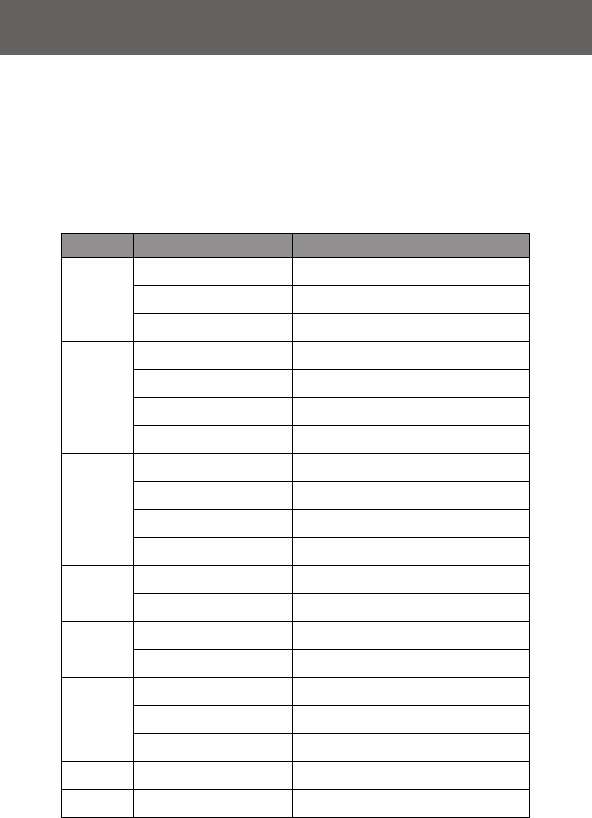
Adjusting Your Settings
136
Entering Notes
To create a new tone, use the keypad keys to enter each note.
Press a key multiple times to cycle through its available notes or
options (pitch, octave, or length). The default setting for a new
tone is a quarter note in octave two.
Key Display Description
1 1 set octave one
2 set octave two
3 set octave three
2 A note A
B note B
C note C
2set octave two
3 D note D
E note E
F note F
3set octave three
4 G note G
R rest
7 # sharp
b flat
0 q quarter note or quarter rest
h half note or half rest
w whole note or whole rest
*move cursor left
#move cursor right
User.Guide.GSM.book Page 136 Wednesday, January 9, 2002 2:30 PM
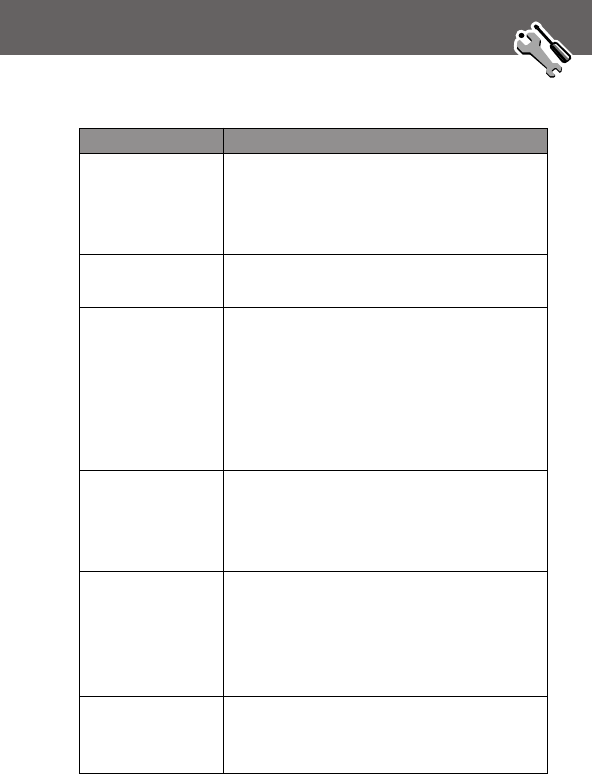
137
Adjusting Your Settings
Enter a note as follows:
Task Action
Change the
octave
Set the new octave (1, 2, or 3)
before
selecting the note. The new octave applies
to the note and all following notes until
you change it again.
Select the note
(required)
Press a keypad key to enter a note.
Change a note to
a sharp or flat
Enter a sharp or flat (# or b)
after
selecting
the note.
Some sharps and flats are played as
standard notes. For example, B# is the
same as C. Press K to scroll to valid notes
when entering a new note.
Change a note’s
length
Set the new length (h, w, or q)
after
selecting the note. The new length applies
to the note and all following notes until
you change it again.
Add a rest Enter one or more rests (R characters) as
needed in the tone sequence. You can set
the length of the rest by entering an h, w,
or q character
after
the rest, just as you
can for a note.
Listen to a new
tone as you
compose it
Press M to enter the Compose Menu,
and select Play All to play the notes you
have entered.
User.Guide.GSM.book Page 137 Wednesday, January 9, 2002 2:30 PM

Adjusting Your Settings
138
Example
Press these keys to play this sequence of notes and rests in
octave three: C (quarter note), E flat (quarter note), half rest,
and G (whole note):
Playing a Tone
Press To Display
1
1 1 1set octave three 3
2
2 2 2enter a quarter note CC
3
3 3 7 7enter a quarter note E
flat
Eb
4
4 4 0 0enter a half rest Rh
5
4 0 0 0enter a whole note GGw
Find the Feature
M > Settings > Ring/Vibrate
> My Tones
Press To
1
K scroll to the tone you want to play
2
M open the My Tones Menu
3
K scroll to Play
4
SELECT (J) select Play
The phone displays the playback
meter and plays the tone.
User.Guide.GSM.book Page 138 Wednesday, January 9, 2002 2:30 PM
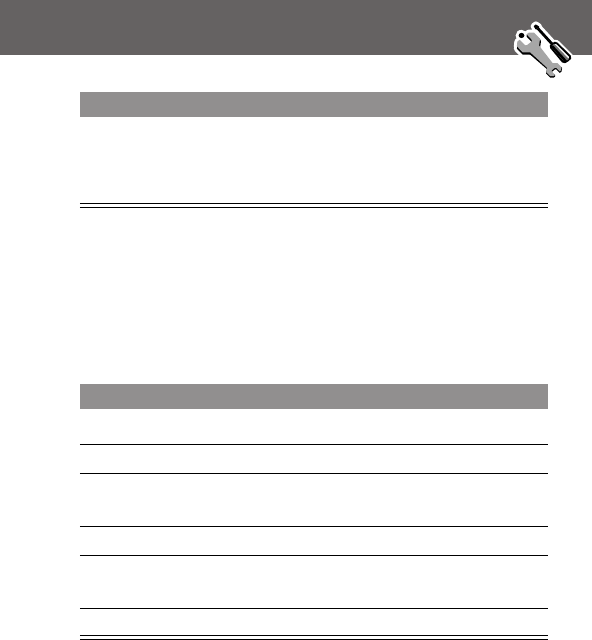
139
Adjusting Your Settings
Editing a Tone
You cannot edit the standard alert tones included with your
phone. To edit a custom tone that you created:
Deleting a Tone
You cannot delete the standard alert tones included with your
phone. To delete a custom tone that you created:
5
PLAY (J)
or
CANCEL (L)
play the tone again
return to the my tones list
Find the Feature
M > Settings > Ring/Vibrate
> My Tones
Press To
1
K scroll to the tone you want to edit
2
EDIT (J) open the tone details
3
K scroll to the details you want to edit
(Name or Notes)
4
CHANGE (J) select the details you want to edit
5
keypad keys enter new text or notes (see
“Entering Notes” on page 136)
6
OK (J) store the details
Find the Feature
M > Settings > Ring/Vibrate
> My Tones
Press To
User.Guide.GSM.book Page 139 Wednesday, January 9, 2002 2:30 PM

Adjusting Your Settings
140
Reminders
Reminders are alerts that ring or vibrate to notify you about a
voicemail or text message you have received, or a datebook
event you have scheduled.
To set or turn off reminders:
Press To
1
K scroll to the tone you want to delete
2
M open the My Tones Menu
3
K scroll to Delete
4
SELECT (J) select Delete
5
YES (L) confirm the deletion
Find the Feature
M > Settings > Ring/Vibrate
>
Alert
Detail > Reminders
Press To
1
K scroll to the reminder alert you want:
Beep, Vibrate, or Off
Beep or Vibrate sets the
corresponding reminder alert type.
Off turns off all reminders.
2
SELECT (J) select the reminder alert
User.Guide.GSM.book Page 140 Wednesday, January 9, 2002 2:30 PM

141
Adjusting Your Settings
Call Forwarding
Call forwarding sends your phone’s incoming voice,
fax, and/or data calls directly to another phone
number. Use call forwarding options to specify which
calls your phone should forward. When you are ready
to accept calls on your phone again, you can turn off call
forwarding.
Set Up or Cancel Call Forwarding
The call forwarding options for voice, fax, or data calls are:
All Calls forwards all calls
If Unavailable forwards calls if your phone is unavailable
Detailed uses different forwarding numbers if you
are out of range, unable to answer, or
busy (
voice calls only
)
Off does not forward calls
Find the Feature
M > Settings > Call Forward
Press To
1
K scroll to the type of calls you want to
forward
(Cancel All cancels all call
forwarding and ends the procedure.)
2
SELECT (J) open the call forward details for that
call type
User.Guide.GSM.book Page 141 Wednesday, January 9, 2002 2:30 PM
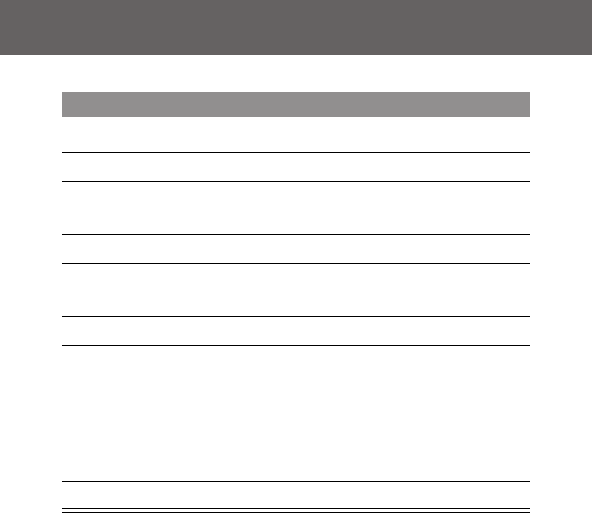
Adjusting Your Settings
142
Note: You can repeat this procedure to enter forwarding
information for other call types.
Check Call Forwarding Status
Your network may store call forwarding status for you. If you
change your phone’s call forward settings (see “Set Up or Cancel
Call Forwarding” on page 141), then you should confirm that
the network call forward status matches your preferences.
3
K scroll to Forward
4
CHANGE (J) change the Forward option
5
K scroll to the call forward option you
want
6
SELECT (J) store the option
7
K scroll to To (same for If Busy,
If No Answer, or If Unreachable)
8
CHANGE (J) change the phone number
9
keypad keys
or
BROWSE (J)
enter the forwarding phone number
browse through your phonebook or
other lists for the forwarding phone
number
10
OK (J) store the forwarding phone number
Find the Feature
M > Settings > Call Forward
> Forward Status
Press To
User.Guide.GSM.book Page 142 Wednesday, January 9, 2002 2:30 PM
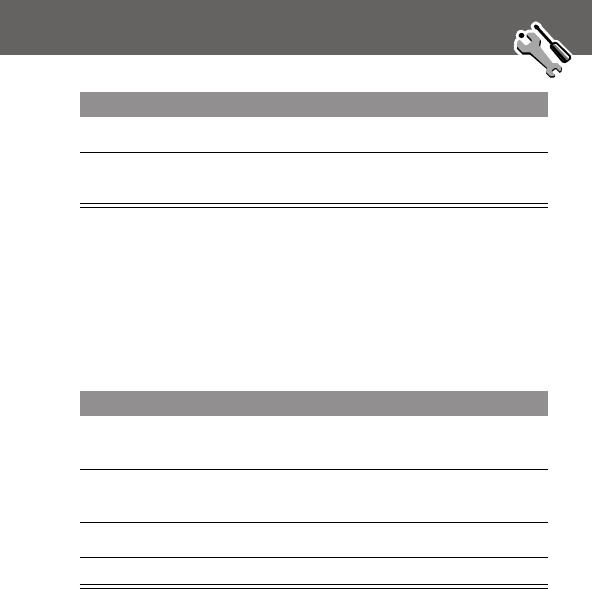
143
Adjusting Your Settings
Reordering Menu Items
You can customize the order of the items in your phone’s main
menu, depending upon your usage.
Press To
1
K scroll to Voice, Fax, or Data calls
2
View (L) confirm that the network settings are
correct
Find the Feature
M > Settings > Other Settings
> Personalize > Main Menu
Press To
1
K scroll to the menu item you want to
move
2
GRAB (L) grab the menu item you want to
move
3
K move the item up or down the menu
4
INSERT (L) insert the item in the new location
User.Guide.GSM.book Page 143 Wednesday, January 9, 2002 2:30 PM

Adjusting Your Settings
144
Customizing a Soft Key Function
You can relabel the soft keys (left L and right J) to access
different main menu items from the idle display.
Hands-Free Use
You can user your phone without using your hands by using the
phone headset. Be sure that your phone is rotated open.
You can also purchase an optional Motorola Original™
Easy-Install Hands-Free Kit for your car. This accessory
provides an alternative way for you to use your phone
without using your handset.
Note: The use of wireless devices and their accessories may be
prohibited or restricted in certain areas. Always obey the laws
and regulations on the use of these products.
Find the Feature
M > Settings > Other Settings
> Personalize > Keys
Press To
1
K scroll to Left or Right
2
CHANGE (L) open the key editor
3
K scroll to the new key function
4
SELECT (L) confirm the new function
The key will have the new function
whenever the phone is idle.
User.Guide.GSM.book Page 144 Wednesday, January 9, 2002 2:30 PM

145
Adjusting Your Settings
Automatic Answer
When you activate automatic answer and connect your phone to
the Easy-Install Hands-Free Kit or phone headset, your phone
automatically answers calls after two rings.
Automatic Hands-Free
You can set up your phone to automatically route calls to the
Easy-Install Hands-Free Kit when it detects a connection.
Find the Feature
M > Settings > Other Settings
Press To
1
K scroll to Car Settings or Headset
2
SELECT (J) select the feature
3
K scroll to Auto Answer
4
SELECT (J) select Auto Answer
5
K scroll to On or Off
6
SELECT (J) confirm the setting
Find the Feature
M > Settings > Other Settings
> Car Settings
> Auto Handsfree
Press To
1
K scroll to On or Off
2
SELECT (J) confirm the setting
User.Guide.GSM.book Page 145 Wednesday, January 9, 2002 2:30 PM

Adjusting Your Settings
146
Power-Off Delay
When your phone is connected to the Easy-Install Hands-Free
Kit, you can set it to stay on for a specified time period after you
switch off the ignition. This keeps your phone from draining your
vehicle battery by staying on indefinitely, but leaves your phone
on long enough that you do not have to re-enter your unlock
code when you make short stops.
Caution: If you select Continuous, the phone does not power
off when you turn off the ignition. Be careful not to accidentally
drain your vehicle battery if you select this option.
Find the Feature
M > Settings > Other Settings
> Car Settings
> Power-Off Delay
Press To
1
K scroll to the time delay option you
want
2
SELECT (J) confirm your selection
User.Guide.GSM.book Page 146 Wednesday, January 9, 2002 2:30 PM

147
Adjusting Your Settings
Charger Time
When your phone is connected to the Easy-Install Hands-Free
Kit, you can set it to charge itself for a specified time period after
you switch off the ignition. This helps ensure that the phone
battery gets fully charged while the vehicle is parked.
Find the Feature
M > Settings > Other Settings
> Car Settings
> Charger Time
Press To
1
K scroll to the charge time option you
want
2
SELECT (J) confirm your selection
User.Guide.GSM.book Page 147 Wednesday, January 9, 2002 2:30 PM

148
Data and Fax Calls
A Motorola Original™ data kit lets you transfer data
between your phone and a computer or other external
device. You can:
• synchronize data between your phone and an external
device with Starfish TrueSync® software, a Motorola
accessory product. See the TrueSync user guide for more
information.
Note: TrueSync software is designed to synchronize with
basic features of many popular Personal Information
Management (PIM) software and hardware products.
• use your phone as a modem to connect to the Internet
Note: 56K modems are capable of receiving 56Kbps from a
compatible service provider. Receiving is currently limited in
the U.S. and Canada to 53 Kbps, and transmitting to 33.6
Kbps. Actual speeds will vary depending on line conditions.
• use your phone to send and receive data and fax calls on
your computer or hand-held device.
For more information about Motorola Original data kits, see the
Motorola Web site at:
http://www.motorola.com/dataaccessories
(United States)
http://www.motorola.ca/dataaccessories
(Canada)
User.Guide.GSM.book Page 148 Wednesday, January 9, 2002 2:30 PM

149
Data and Fax Calls
Connecting Your Phone to an External
Device
Connect your phone to an external device (such as a computer or
hand-held device) using a serial cable or a USB cable.
Note: Not all devices are compatible with serial cable or USB
cable connections. Check your external device for specifications.
Set Up a Cable Connection
Attach a serial cable or Motorola Original USB cable to the
phone and external device as follows.
Note: Check your computer or hand-held device to determine
the type of cable you need.
Attaching a Serial Cable
Use the interchangeable head on the Motorola Multi-Connect
Serial Cable to connect a computer, Palm III device, or Palm V
device to your phone.
Do This
1
Plug the serial cable into the detachable head. Make sure
that the Motorola logo on the detachable head and the
metal shielding on the serial cable plug are both facing
you.
2
With the Motorola logo and the phone both facing you,
plug the detachable head into your phone’s accessory
connector port.
3
Plug the other end of the cable into the serial interface
connection on the external device and tighten the screws.
User.Guide.GSM.book Page 149 Wednesday, January 9, 2002 2:30 PM

Data and Fax Calls
150
Attaching a USB Cable
Install the Software
Install the software from the CD-ROM that comes with your
Motorola Original data kit. See the data kit’s user guide for more
information.
Sending a Data or Fax Call
You can connect your phone to a computer or hand-held device
to send data or a fax from the connected device.
Use this feature to transfer data from your computer onto
another device, and to synchronize phonebook and datebook
information between your phone, computer, and/or hand-held
device.
Connect your phone (see “Connecting Your Phone to an External
Device” on page 149) and do the following:
Do This
1
Plug the end of the cable with the Motorola logo into your
phone’s accessory connector port. Make sure that the logo
and the phone are both facing you.
2
Plug the other end—the USB connection—into the USB
port on the external device.
Do This To
1
Check the phone make sure that the phone is
connected and powered on
User.Guide.GSM.book Page 150 Wednesday, January 9, 2002 2:30 PM
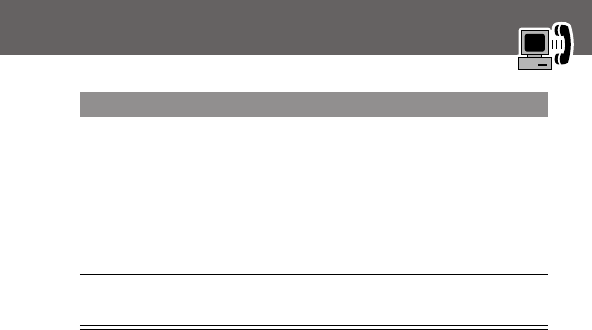
151
Data and Fax Calls
Receiving a Data or Fax Call
You can connect your phone to a computer or hand-held device
to receive data or a fax.
Use this feature to transfer data to your computer from another
device.
Transfer the Data or Fax
Connect your phone (see “Connecting Your Phone to an External
Device” on page 149).
Your phone notifies you when the data or fax call arrives, and
transfers the call to the connected device. You must use the
application running on the connected device to answer the call.
2
Open the
application on
your computer
place the call through the application
(such as dial-up-networking or fax)
Note: You cannot dial data or fax
numbers through your phone’s
keypad. You must dial them through
your computer.
3
End the transfer
on your computer
close the call and connection when
the transfer is complete
Do This To
User.Guide.GSM.book Page 151 Wednesday, January 9, 2002 2:30 PM

Data and Fax Calls
152
End the Data/Fax Connection
When the data or fax transfer is complete:
Sending a Talk then Fax Call
You can place a call where you talk and then send a
fax to the same phone number within the same call.
Connect to the device that will send the fax (see
“Connecting Your Phone to an External Device” on page 149)
and do the following:
Do This To
End the call from the
connected device
close the connection
Press To
1
keypad keys enter the phone number for the call
2
M open the Dialing Menu
3
K scroll to Talk Then Fax
4
SELECT (J) select Talk Then Fax (for the next
call only)
5
N dial the call
Speak and, when ready, initiate the
fax transfer on the connected device.
When transfer is complete, end the
call from the connected device.
User.Guide.GSM.book Page 152 Wednesday, January 9, 2002 2:30 PM

153
Security
Assigning a New Code or Password
Your phone’s four-digit unlock code is originally set to 1234, and
the six-digit security code is originally set to 000000 at the
factory. Your service provider may reset these numbers before
you receive your phone.
If your service provider has
not
reset these numbers, we
recommend that you change them to prevent other users from
accessing your personal information or modifying your phone
settings. The unlock code must contain four digits, and the
security code must contain six digits. Be sure to make a note of
the new numbers.
Notes:
• Your service provider may retain your phone’s security code
for customer service purposes. In this case, you will not be
able to use phone features that require you to enter the
security code (such as master clear, master reset, and the
unlock code bypass feature).
• If the only password you can change is the unlock code, the
New Passwords menu is unavailable and the Unlock Code
option appears on the Phone Lock menu. In this case, open
the unlock code editor by selecting: M > Settings
> Security > Phone Lock > Unlock Code.
User.Guide.GSM.book Page 153 Wednesday, January 9, 2002 2:30 PM

Security
154
To change a code or password:
Find the Feature
M > Settings > Security
> New Passwords
Press To
1
K scroll to the code or password you
want to change
2
CHANGE (J) select the code or password
3
keypad keys enter your old code
If you do not know your code, see “If
You Forget a Code or Password” on
page 155.
4
OK (J) submit your old code
5
keypad keys enter the new code
6
OK (J) assign the new code
7
keypad keys re-enter the new code
8
OK (J) confirm the new code
User.Guide.GSM.book Page 154 Wednesday, January 9, 2002 2:30 PM

155
Security
If You Forget a Code or Password
If you forget your security code (originally set to 000000), SIM
PIN, SIM PIN2, or call barring password, contact your service
provider.
If you forget your unlock code, try entering 1234 or the last four
digits of your phone number. If that does not work, do the
following when you see the Enter Unlock Code message:
Locking and Unlocking Your Phone
You can lock your phone manually or set your phone to lock
automatically whenever you turn it off.
When you try to use a locked phone, it asks you to enter the
unlock code. A locked phone still rings or vibrates for incoming
calls or messages,
but you must unlock it to answer
.
You can make emergency calls on your phone even when it is
locked. See “Dialing an Emergency Number” on page 38.
Press To
1
M go to the unlock code bypass screen
2
keypad keys enter your security code
3
OK (J) submit your security code
User.Guide.GSM.book Page 155 Wednesday, January 9, 2002 2:30 PM

Security
156
Lock Your Phone Manually
Set Your Phone to Lock Automatically
You can set your phone to lock every time you turn it off:
Unlock Your Phone
At the Enter Unlock Code prompt:
Find the Feature
M > Settings > Security
> Phone Lock > Lock Now
Press To
1
keypad keys enter your four-digit unlock code
2
OK (J) lock the phone
Find the Feature
M > Settings > Security
> Phone Lock > Automatic Lock
> On
Press To
1
keypad keys enter your four-digit unlock code
2
OK (J) set the phone to lock automatically
Press To
1
keypad keys enter your four-digit unlock code
The unlock code is originally set to
1234. If necessary, see “If You Forget
a Code or Password” on page 155.
2
OK (J) unlock your phone
User.Guide.GSM.book Page 156 Wednesday, January 9, 2002 2:30 PM
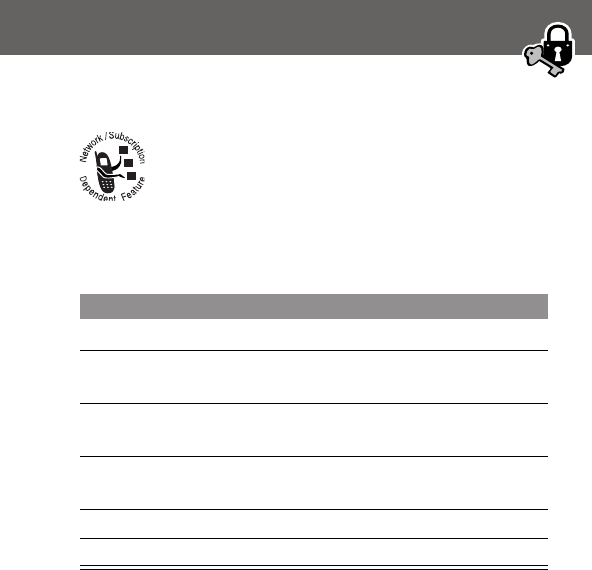
157
Security
Barring Calls
Call barring lets you restrict outgoing or incoming
calls. You can restrict all calls, calls to international
numbers, or calls while roaming.
Find the Feature
M > Settings > Security
> Call Barring
Press To
1
K scroll to Outgoing or Incoming calls
2
CHANGE (J) select barring for Outgoing or
Incoming calls
3
K scroll to a restriction for the barred
calls
4
SELECT (J) select the restriction for the barred
calls
5
keypad keys enter your call barring password
6
OK (J) submit your password
User.Guide.GSM.book Page 157 Wednesday, January 9, 2002 2:30 PM

Security
158
Protecting the SIM Card
Your PIN (Personal Identification Number) code protects the
information stored on your SIM card. When the SIM PIN feature
is activated, you must enter your SIM card PIN code each time
you turn on the phone or insert a SIM card. Your SIM card PIN
code is given to you by your service provider.
Unblock the SIM Card PIN Code
If you enter an incorrect SIM card PIN code three times in a row,
your SIM card is disabled and your phone displays the message
SIM Blocked. You need to enter a PIN unblocking key (PUK)
code, which you can obtain from your service provider.
Find the Feature
M > Settings > Security
> SIM PIN
Press To
1
K scroll to On or Off
2
SELECT (J) switch protection on or off
3
keypad keys enter your SIM card PIN code
4
OK (J) submit your code
User.Guide.GSM.book Page 158 Wednesday, January 9, 2002 2:30 PM
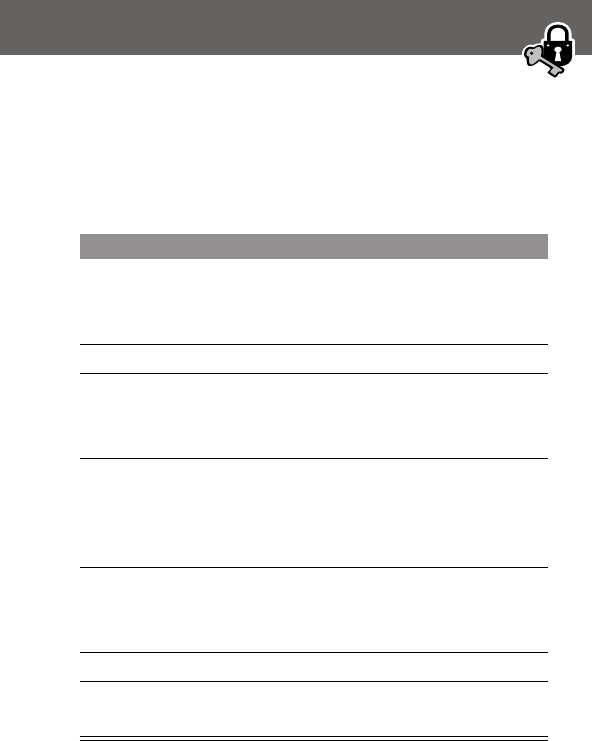
159
Security
Note: In the following key sequence, each key press must occur
within two seconds of the previous keypress.
Caution: If the unblocking attempt is tried unsuccessfully 10
times, the SIM card is permanently disabled and your phone
displays the message SIM Disabled.
Press To
1
# # 0 5
*
open the PIN unblocking editor
Your phone prompts you to enter
the PIN1 Unblock Sequence:.
2
keypad keys enter the PUK code
3
OK (J) submit the PUK code
Your phone prompts you to
Enter New SIM PIN:.
4
keypad keys enter a new SIM card PIN code
Note: The SIM PIN code must be
between four and eight digits in
length.
5
OK (J) assign the new SIM PIN code
Your phone prompts you to
Re-enter New SIM PIN:.
6
keypad keys re-enter your SIM card PIN code
7
OK (J) confirm the new SIM PIN code
and unblock the SIM card
User.Guide.GSM.book Page 159 Wednesday, January 9, 2002 2:30 PM

160
Troubleshooting
Check these questions first if you have problems with your
phone:
Question Answer
Is your battery
charged? Do you
see B in the
display?
The battery level indicator should have
at least one segment showing (C). If
it does not, recharge your battery. (See
“Charging the Battery” on page 22 and
“Battery Use” on page 33.)
Is the phone set
to the proper
frequency for
your
geographical
region?
Phones in different regions of the world
use different frequencies to establish a
network connection. If necessary, use
the Network feature (see page 77) to
reset your phone’s frequency to
900/1800 MHz when you travel to a
new location.
Do you have a
valid SIM card
inserted in your
phone?
If necessary, turn off your phone and
make sure that you have inserted a valid
SIM card. (See “Installing the SIM Card
and Battery” on page 19).
Does the handset
have a signal?
Do you see j in
the display?
The signal strength indicator should
have at least one segment showing (1).
If it does not, move to an area with a
stronger signal to use your phone.
Is the earpiece
volume too low?
While on a call, press the volume key on
the side of your phone.
User.Guide.GSM.book Page 160 Wednesday, January 9, 2002 2:30 PM
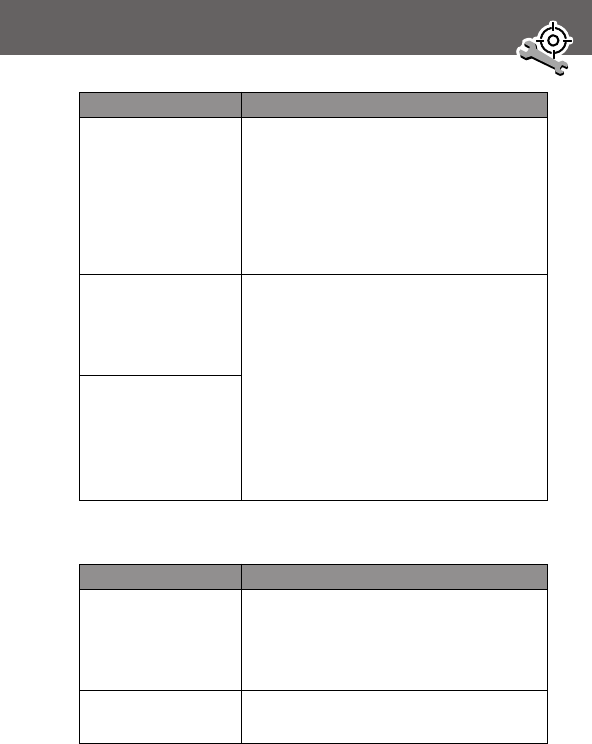
161
Troubleshooting
The following refer to specific problems:
Is the other party
unable to hear
you?
Your phone may be muted. Press
UNMUTE (J) if necessary to unmute
the phone.
Also, make sure that your phone’s
microphone is not blocked by its
carrying case or a sticker.
Has the phone
been damaged,
dropped, or
gotten wet?
Dropping your phone, getting it wet, or
using a non-Motorola battery or battery
charger can damage the phone. The
phone’s limited warranty does not cover
liquid damage or damage caused from
using non-Motorola accessories.
Was a
non-Motorola
battery or
battery charger
used?
Problem Solution
My phone was
stolen. To whom
should I report
this?
Report a stolen phone to the police and
to your service provider (the company
that sends you your monthly wireless
service bill).
I forgot my
password.
See “If You Forget a Code or Password”
on page 155.
Question Answer
User.Guide.GSM.book Page 161 Wednesday, January 9, 2002 2:30 PM
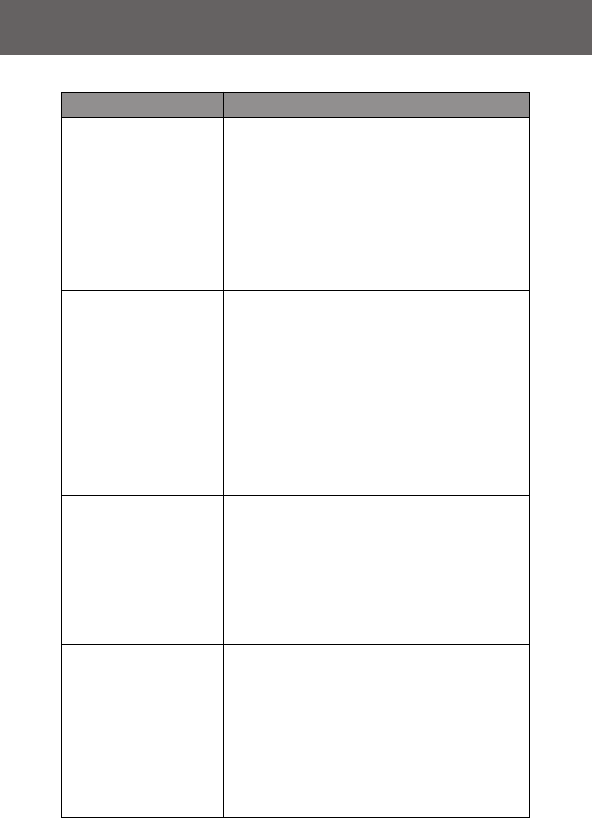
Troubleshooting
162
I pressed the
End/Power key,
but nothing
happened.
Be sure to press and hold O (the End/
Power key) until the display appears and
you hear an audible alert (this could
take a couple of seconds). If nothing
happens, check that a charged battery
is installed. (See “Charging the Battery”
on page 22.)
The display says:
Insert SIM Card
or Check SIM Card
even though I
have inserted my
SIM card in the
phone.
The SIM card may be incorrectly
inserted. Check the SIM card to make
sure that it is inserted properly. See
“Installing the SIM Card and Battery”
on page 19.
Note: Be sure to turn your phone off
and then back on after you re-insert the
SIM card.
The display says:
SIM Blocked. How
do I unblock my
SIM card?
Call your service provider (the company
that sends you your monthly wireless
service bill) to obtain the PIN
unblocking key (PUK) code. See
“Unblock the SIM Card PIN Code” on
page 158.
The display says:
Enter Unlock
Code. How do I
unlock my
phone?
Enter the factory-preset unlock code
(1234), or the last four digits of your
phone number. (See “Locking and
Unlocking Your Phone” on page 155.) If
this fails, call your service provider (the
company that sends you your monthly
wireless service bill).
Problem Solution
User.Guide.GSM.book Page 162 Wednesday, January 9, 2002 2:30 PM
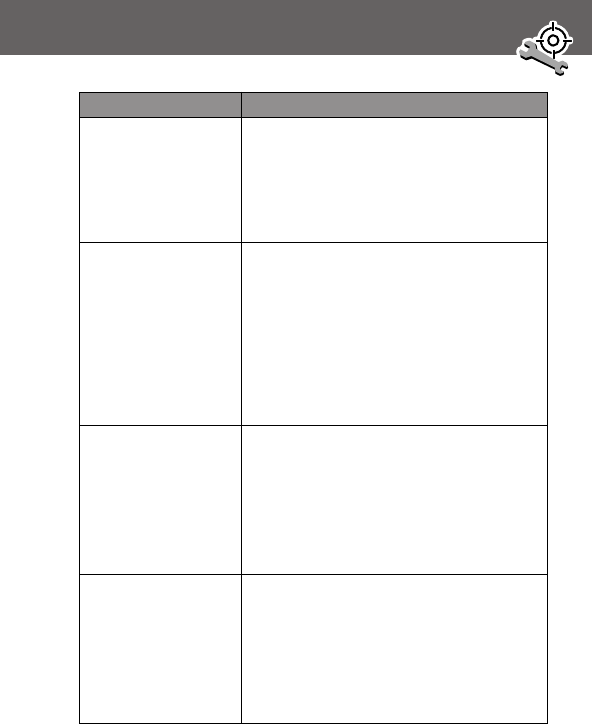
163
Troubleshooting
My phone asks
for an unlock
code when I try
to open a
feature.
The application you want is locked. If
you own the phone but do not know
the unlock code, see “If You Forget a
Code or Password” on page 155.
My phone does
not ring.
If you see t or y in the display,
then the ringer is turned off. See
“Ring/Vibrate” on page 133.
Also, the ringer may be set to Silent
even though your phone is set to a ring
alert profile. See “Customize an Alert
Profile” on page 134.
My phone rings
even though I
selected the
Silent (or
Vibrate) alert
profile.
The ringer may be set to play a tone
even though your phone is set to a
silent alert profile. See “Customize an
Alert Profile” on page 134.
I tried to place a
call and heard an
alternating high/
low tone.
Your call did not reach the wireless
system. You may have dialed the
number too soon after turning the
phone on. Wait until the display shows
the name of your service provider
before making a call.
Problem Solution
User.Guide.GSM.book Page 163 Wednesday, January 9, 2002 2:30 PM
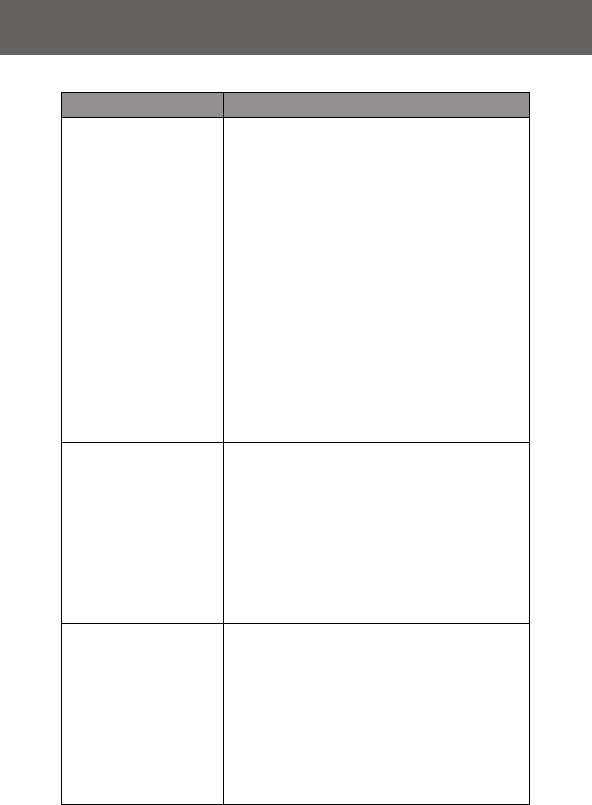
Troubleshooting
164
I cannot send/
receive calls.
Make sure that you have a phone signal
(see the “Signal Strength Indicator”
item on page 28). Avoid electrical or
radio interference, and obstructions
such as bridges, parking garages, or tall
buildings.
Your phone also may have
theCall Barring feature turned on. If
you know the unlock code, you can
change this setting in the security menu
(M > Settings > Security).Also,
check to be sure your SIM card is
installed and working
My phone has
poor reception
and drops calls.
Make sure that your antenna is not bent
or damaged.
Also, make sure you have a phone
signal (see the “Signal Strength
Indicator” item on page 28). Stay clear
of any obstructions such as bridges,
parking garages, or tall buildings.
I cannot hear
others on my
phone.
While on a call, press the volume key on
the left side of your phone. Your phone
display should show the volume
increasing.
Also, make sure that your phone’s
earpiece is not blocked by its carrying
case.
Problem Solution
User.Guide.GSM.book Page 164 Wednesday, January 9, 2002 2:30 PM
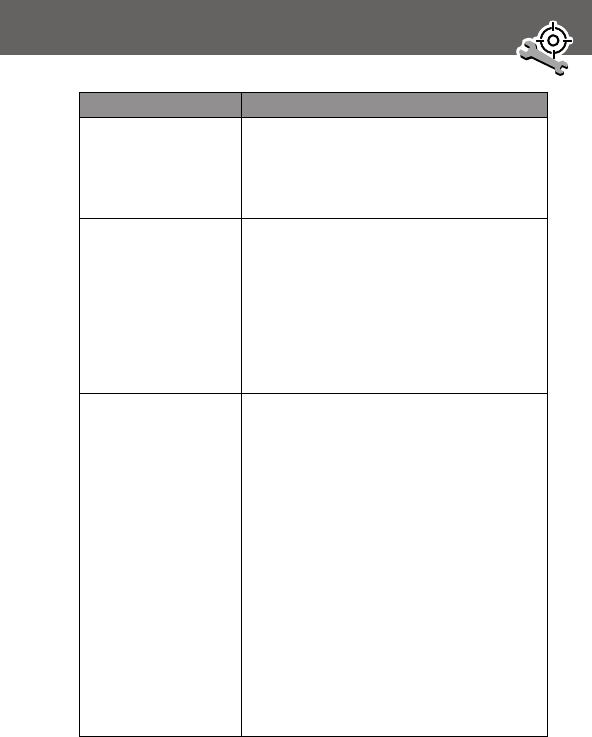
165
Troubleshooting
I cannot open my
inbox.
Before you can use text or information
services messages, you must set up the
appropriate inbox. See “Setting Up the
Text Message Inbox” on page 113.
How do I see the
calls I sent or
received?
To see the most recent calls you dialed
or received, open the “Recent Calls”
lists:
M > Recent Calls
> Received Calls
or
Dialed Calls
My phone will
not send
voicemail
commands,
passwords, or
other codes.
Your phone sends commands and
passwords as DTMF tones. You can set
your phone’s DTMF tones to be Long,
Short, or Off. If you have trouble
sending numbers, check your DTMF
setting.
1
From the idle display, press:
M > Settings
> Other Settings
> Initial Setup
> DTMF
2
Press K to scroll to Long or Short.
3
Press SELECT (J) to select it.
Problem Solution
User.Guide.GSM.book Page 165 Wednesday, January 9, 2002 2:30 PM
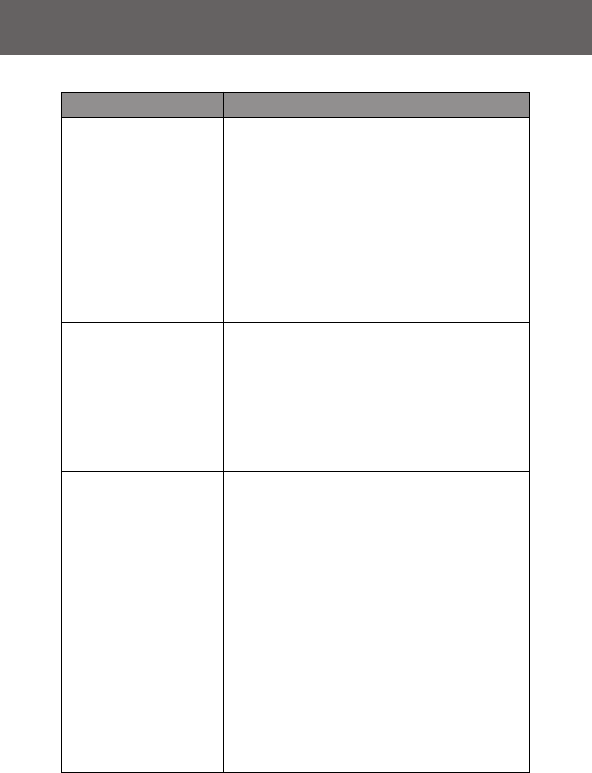
Troubleshooting
166
My phone’s
display is too
light.
You can use the Contrast Setting
feature (see page 76) to change the
level of contrast in your phone display.
You can also use the Backlight feature
(see page 75) to change the length of
time that your phone’s display backlight
stays on, or to change the display’s
backlight color.
My battery didn’t
last as long as I
expected. What
can I do to
extend battery
life?
Your battery’s performance is affected
by charge time, feature use,
temperature changes, and other factors.
For tips on extending your battery life,
see “Battery Use” on page 33.
I plugged the
data cable into
my phone but my
phone did not
beep. How do I
know if the data
cable is ready to
go?
The beep indicates that you are set up
correctly. If you did not hear a beep,
make sure that both ends of the data
cable are connected—the smaller end
to your phone and the larger end to
your computer.
Finally, your computer may have
deactivated the port to save power. Try
opening an application that uses the
port, like a fax or dial-up application,
and your computer will automatically
activate the port.
Problem Solution
User.Guide.GSM.book Page 166 Wednesday, January 9, 2002 2:30 PM

167
Troubleshooting
My phone
beeped when I
attached the
data cable, but
my fax and data
applications
don’t work.
Some wireless networks may not
support data or fax transmission. If you
are roaming on an unfamiliar network,
this may be the case.
Also, remember that data and fax
transmission usually requires a
subscription. Call your service provider
for more information.
When sending
data with the
data cable, why
does the
computer show a
connection rate
of 19200 Kbps?
19200 Kbps is the data transfer rate of
the connection between your computer
and the phone in a standard CSD
(Circuit Switch Data) connection. The
rate of the connection between your
phone and the network is displayed on
your phone, and will be either 14400 or
9600 Kbps.
Note: A GPRS connection may have a
higher data transfer rate.
I can’t end my
data call by
closing the
application on
my computer.
What can I do?
Try pressing O on your phone. Also
try disconnecting the cable or turning
off the phone. If possible, always close
the connection through your computer.
These alternative methods may disrupt
the application on your computer.
Problem Solution
User.Guide.GSM.book Page 167 Wednesday, January 9, 2002 2:30 PM

Troubleshooting
168
I launched the
micro-browser
but the display
says: Service Not
Available.
You may be in an area without service,
or you may be connected to a network
that does not support Internet access.
I launched the
micro-browser
but the display
says: Data Server
Unavailable.
Try again in a few minutes. The servers
may be temporarily busy.
Problem Solution
User.Guide.GSM.book Page 168 Wednesday, January 9, 2002 2:30 PM
169
Product Registration
Online Product Registration:
http://www.motorola.com/warranty
Product registration is an important step toward enjoying your
new Motorola phone. Registering helps us facilitate warranty
service, and permits us to contact you should your phone require
an update or other service. Registration is not required for
warranty coverage.
Please retain your original dated sales receipt for your records.
For warranty service of your Motorola Personal Communications
Product you will need to provide a copy of your dated sales
receipt to confirm warranty status.
Thank you for choosing a Motorola product.
Export Law Assurances
This product is controlled under the export regulations of the
United States of America and Canada. The Governments of the
United States of America and Canada may restrict the
exportation or re-exportation of this product to certain
destinations. For further information contact the U.S.
Department of Commerce or the Canadian Department of
Foreign Affairs and International Trade.
User.Guide.GSM.book Page 169 Wednesday, January 9, 2002 2:30 PM

170
Specific Absorption Rate
Data
This model phone meets the government’s
requirements for exposure to radio waves.
Your mobile phone is a radio transmitter and receiver. It is
designed and manufactured not to exceed limits for exposure to
radio frequency (RF) energy. These limits are part of
comprehensive guidelines and establish permitted levels of RF
energy for the general population. The guidelines are based on
standards that were developed by independent scientific
organizations through periodic and thorough evaluation of
scientific studies. The guidelines include a substantial safety
margin designed to assure the safety of all persons, regardless of
age and health.
The exposure standard for mobile phones employs a unit of
measurement known as the Specific Absorption Rate, or SAR.
Under the guidelines for your phone model, the SAR limit is
1.6 W/kg . Tests for SAR are conducted using standard
operating positions with the phone transmitting at its highest
certified power level in all tested frequency bands. Although the
SAR is determined at the highest certified power level, the actual
SAR of the phone while operating can be well below the
User.Guide.GSM.book Page 170 Wednesday, January 9, 2002 2:30 PM
171
maximum value. This is because the phone is designed to
operate at multiple power levels so as to use only the power
required to reach the network. In general, the closer you are to a
base station, the lower the power output of the phone.
Before a phone model is available for sale to the public, it is
tested to confirm compliance with the guidelines. The tests are
performed in positions and locations (e.g., at the ear and worn
on the body) that conform to a uniform testing methodology
determined by an expert standards body. The highest SAR value
for this model phone when tested for use at the ear is 1.54 W/kg
and when worn on the body, as described in this user guide, is
0.43 W/kg. (Body-worn measurements differ among phone
models, depending upon available accessories and regulatory
requirements).
While there may be differences between the SAR levels of
various phones and at various positions, they all meet the
governmental requirements for safe exposure.
User.Guide.GSM.book Page 171 Wednesday, January 9, 2002 2:30 PM

172
Index
A
accessories
optional 11, 108, 144, 148
standard 19
accessory connector port 1
active line indicator
defined 29
illustration 28
Add Digits feature 81
alert
creating 135–140
defined 133
indicators 30, 133
reminders 140
type, selecting 134
alert profile
customizing 134
defined 133
setting 133–134
alert setting indicator
defined 30, 133
illustration 28
animation 76
application, locking 73
appointments.
See
datebook
Attach Number feature 41,
81
automatic redial
turning on/off 75
using 35–36
B
backlight 75
barring calls 157
battery
car kit charger time 147
charging 22
extending battery life
33–34, 75, 76, 166
installing 19–??
level indicator 23, 28, 29
meter 69
blackjack 129–130
block cursor, defined 52
browse text mode 53
browser alerts 66
browser setup
micro-browser
browser setup 70
browser.
See
micro-browser
C
calculator 125–127
calendar.
See
datebook
call
adding digits after phone
number 81
alert profile, setting
133–134
alert type, selecting 134
User.Guide.GSM.book Page 172 Wednesday, January 9, 2002 2:30 PM

173
Index
alert, creating 135–140
answer options 72
answering 26
barring 157
call waiting 44
calling card 42
canceling 39
cost setup 71
costs 85–86
credit limit 71
deleting 79–81
dialed calls list 43, 79–81
dialing 25
dialing a recent call 79–81
emergency number 38
ending 25
hold 48
ignoring 39
in-call timer 70–71
placing 25
prefix digits, inserting 41
received calls list 43, 79–81
receiving 26
recent calls 79–81
sending 25
storing 79–81
talk then fax 152
terminating 39
timing 83
transferring 46–47
unanswered call 37
call barring 157
call cost information 85–86
Call Failed message 35
call forwarding
defined 141
status, checking 142–143
using 141–142
call timers
described 83
resetting 84
viewing 84
call waiting
activating/deactivating 72
using 44
caller ID
incoming calls 36
outgoing calls 71, 81
calling card call 42
calling line identification.
See
caller ID
car kit
automatic answer 145
automatic hands-free 145
charger time 147
power-off delay 146
clock
defined 30
illustration 28
codes.
See
passwords
User.Guide.GSM.book Page 173 Wednesday, January 9, 2002 2:30 PM

Index
174
computer
connecting to phone
149–150
synchronizing data 99, 148
conference call 45
contrast, display 76
cost trackers
described 85–86
resetting 86
viewing 86
credit available 69, 85
credit information 69, 85
currency converter 127
cursor 52
customer service, calling 65
customizing the menu 143
D
data call
connecting to external
device 149–150
receiving 151–152
sending 150–151
date, setting 74
datebook
adding an event 104
alarm 104
calendar 102
changing event information
105
copying an event 106
day view 103
deleting an event 107
event view 103
reminders 104, 140
week view 102
Datebook Menu 102, 103
default passwords 153
deleting a call 79–81
dialed calls list 43, 79–81
dialing a number 25
Dialing Menu 152
display
animation 76
backlight 75
contrast 76
described 27–30
greeting 74
idle display 27
illustration 28
language 76
zoom setting 30
drafts folder 66
DTMF tones 76, 80, 81, 165
E
earpiece
illustration 1
volume, adjusting 31
emergency number 38
User.Guide.GSM.book Page 174 Wednesday, January 9, 2002 2:30 PM

175
Index
end key
functions 1, 23, 25, 49
ending a call 25
Enter Unlock Code message
155, 156
Entry Method menu 58
event alert 134
exchange rate, calculating
127
external device
connecting to phone
149–150
synchronizing data 99, 148
F
factory settings, resetting
76–77
fax call
connecting to external
device 149–150
receiving 72, 151–152
sending 72, 150–151
talk then fax call 152
fixed dial
activating/deactivating 73
defined 64–65
dialing numbers 64–65
editing an entry 64–65, 94
storing an entry 88–90
flashing cursor, defined 52
flip
open to answer call 72
turning the phone on 23
FM Stereo Radio Headset
108–110
forwarding calls 141
4-way navigation keys 1, 49
frequency, changing 77, 160
G
games 128–132
GPRS indicator
defined 29
displayed 123
illustration 28
GPRS, defined 123
greeting, display 74
H
hands-free mode
automatic answer 145
automatic call routing 145
charger time 147
defined 144
power-off delay 146
headset
automatic answer 145
FM Stereo Radio Headset
108–110
headset jack 1
User.Guide.GSM.book Page 175 Wednesday, January 9, 2002 2:30 PM

Index
176
Hide ID feature 81
hold a call 48
I
idle display, defined 27
ignoring a call 39
in use indicator
defined 28
illustration 28
inbox, text message 113–114
in-call timer 70–71
incoming call
canceling 39
ignoring 39
terminating 39
Incoming Call message 36
indicators
active line 28, 29
alert setting 28, 30, 133
battery level 23, 28, 29
GPRS 28, 29, 123
in use 28
menu 27, 28, 30
message waiting 28, 29
missed call 37
ring alert 30, 133
roam 28
signal strength 28
silent alert 30, 133
vibrate alert 30, 133
voice message waiting 28,
29
voice name 87
iTAP software
activating 58
capitalization 61
deleting text 62
entering numbers 62
entering words 59–61
punctuation 61
K
key
end 1, 23, 25, 49
4-way navigation 1, 49
left soft key 1, 49, 144
menu 1, 26, 49
right soft key 1, 49, 144
send 1, 25, 26, 49, 79
voice 91–92
volume control 1, 31, 49
keypad
answering calls 72
volume, setting 134
L
language, setting 76
Last Calls Menu
opening 80
options 80–81
User.Guide.GSM.book Page 176 Wednesday, January 9, 2002 2:30 PM

177
Index
left soft key
customizing 144
functions 1, 49
lock
applications 73
phone 155–156
SIM card 158
lock application feature 73
loud ring alert 30, 133
M
making a call 25
master clear 77
master reset 76
menu
Browser Menu 124
customizing 143
Datebook Menu 102, 103
Dialing Menu 152
entering text 51–52, 53–62
Entry Method menu 58
features 63–78
language, setting 76
Last Calls Menu 80–81
lists 50
locking applications 73
My Tones Menu 138, 140
navigating 10, 49–50
Phonebook Menu 87
rearranging features 143
scroll feature 76
Text Msg Menu 116–117
using features 10, ??–52
menu indicator
defined 27, 30
illustration 28
menu key 1, 26, 49
message
browser alert 66
deleting 115–117
dialing number from 40
drafts folder 66
inbox setup 113–114
locking 115–117
outbox 66, 119
reading 115–117
receiving 115
reminders, text message
115, 140
reminders, voicemail 111,
140
sending 41, 117–119
status 119
voicemail 111–112
message waiting indicator
defined 29
illustration 28
micro-browser
browser alerts 66
Browser Menu 124
User.Guide.GSM.book Page 177 Wednesday, January 9, 2002 2:30 PM

Index
178
calling a phone number
124
defined 123
functions 124
go back to previous page
124
starting 123–124
microphone 1
mindblaster 130–132
missed call indicator 37
missed call, dialing 43
Missed Calls message 37
my telephone number 26, 48
my telephone numbers 69
my tones 135–140
My Tones Menu 138, 140
N
’n’ character 42
network settings 77, 160
notepad
defined 38
entering digits 38
retrieving digits 82
number, viewing your own 26,
48, 69
numeric text mode 53
O
1-touch dial
defined 40
setting preference 75, 101
using 40
optional accessory, defined 11
optional feature, defined 11
outbox 66, 119
P
paddleball 132
passwords
changing 153
default 153
if you forget a password
155
pause character 42
phone
accessories, optional 11
accessories, standard 19
active line indicator 29
active phone line, changing
69
answer options 72
connecting to external
device 149–150
credit available 69, 85
credit information 69
credit limit 71
date, setting 74
erase user-entered
information 77
User.Guide.GSM.book Page 178 Wednesday, January 9, 2002 2:30 PM

179
Index
feature specifications 70
flip 23
frequency, changing 77,
160
keypad, answering calls with
72
language, setting 76
locking 155–156
network settings 77, 160
1-touch dial 40
passwords 153, 155
reset all options 76
security code 155
specifications 70
speed dial, using 39
startup greeting 74
time, setting 74
unlock code 155
unlocking 24, 155–156
phone number
active line indicator 29
adding digits after 81
attaching to prefix digits 41
attaching two numbers 81
redialing 35
sending text message to 41
storing in phonebook
88–90
viewing your own 26, 48,
69
phonebook
attaching two numbers 81
capacity, checking 99
copying entries 95–98
deleting an entry 95
dialing a number 92
editing an entry 94
entry name 87
fields 87
number type indicator 87
1-touch dial 40
phone number 87
prefix digits, inserting 41
sorting entries 100–101
speed dial number 39, 87,
89–90
speed dial, using 39
storing an entry 88–90
synchronizing entries 99,
148
voice name entry 91–92
voice name indicator 87
Phonebook Menu 87
PIN code
activating/deactivating 158
defined 158
protecting the SIM card 158
unblocking 158–159
PIN2 code 65
predictive text entry
User.Guide.GSM.book Page 179 Wednesday, January 9, 2002 2:30 PM

Index
180
activating 58
capitalization 61
deleting text 62
entering numbers 62
entering words 59–61
punctuation 61
profile
customizing 134
defined 133
setting 133–134
PUK code 158
Q
quick dial
setting number 74
using 65
R
radio 108–110
received calls list 43, 79–81
receiving a call 26
recent calls 79–81
redial
automatic redial 35–36
busy number 35
reminders
datebook 104
setting 140
text message 115, 140
voicemail message 111,
140
right soft key
customizing 144
functions 1, 49
ring alert
creating 135–140
indicators 30, 133
setting 133–134
type, selecting 134
ring and vibrate alert
indicator 30, 133
ringer
setting 133–134
volume, adjusting 31, 134
roam indicator
defined 28
illustration 28
S
scroll feature 76
security code 155
send key 1, 25, 26, 49, 79
sending a call 25
service dial
defined 64
short message service.
See
text
message
shortcuts
creating 121
User.Guide.GSM.book Page 180 Wednesday, January 9, 2002 2:30 PM

181
Index
standard 120
using 122
Show ID feature 81
signal strength indicator
defined 28
illustration 28
silent alert indicator 30, 133
SIM applications 67
SIM Blocked message 24,
158
SIM card
applications 67
defined 19
installing 19–??
precautions 19
protecting 158
service phone numbers 64
SIM Blocked message 24,
158
SIM Disabled message 159
unblocking 158–159
SIM Disabled message 159
SIM PIN code
activating/deactivating 158
protecting the SIM card 158
unblocking 158–159
SIM PIN2 code 65
SMS.
See
text message
soft keys
customizing 144
illustration 1, 49
soft ring alert 30, 133
speed dial
changing number 89–90
number, defined 39
sorting phonebook entries
by 100
using 39
standby time
increasing 33
storing a call 79–81
symbol text mode 57–58
symbols, entering 57–58
synchronizing data 99, 148
T
talk and fax call 72
talk then fax call 152
tap method text entry 54–56
telephone number, viewing
your own 26, 48, 69
text
block cursor 52
browse mode 53
character chart 56
entering from keypad
53–62
entry mode, changing 53
flashing cursor 52
User.Guide.GSM.book Page 181 Wednesday, January 9, 2002 2:30 PM

Index
182
iTAP software predictive text
entry 58–62
numeric mode 53
symbol chart 58
symbol mode 57–58
tap method 54–56
text message
deleting 115–117
dialing number from 40
inbox setup 113–114
locking 115–117
reading 115–117
receiving 115
reminders 115, 140
sending 41, 117–119
status 119
text mode, changing 53
Text Msg Menu
opening 116
options 116–117
time, setting 74
timers
described 83
resetting 84
viewing 84
transfer a call 46–47
TrueSync 99, 148
U
unblocking the SIM card
158–159
unlock
phone 155–156
unlock code 155
V
vibrate alert
indicator 30, 133
setting 133–134
type, selecting 134
voice dial
dialing a number 93
recording voice name
91–92
voice key
recording a voice name
91–92
voice message waiting
indicator 28, 29
voice name
defined 91
phonebook indicator 87
recording 91–92
voicemail
number, storing 111
receiving 111–112
volume
User.Guide.GSM.book Page 182 Wednesday, January 9, 2002 2:30 PM

183
Index
earpiece 31
keypad 134
ringer 31, 134
volume key 31
volume keys 1, 49
W
wait character 42
Web pages
functions 124
viewing 123–124
Z
zoom setting 30
U.S. patent Re. 34,976
User.Guide.GSM.book Page 183 Wednesday, January 9, 2002 2:30 PM

Index
184
User.Guide.GSM.book Page 184 Wednesday, January 9, 2002 2:30 PM

✂
185
Wireless Phone Safety Tips
“Safety is your most important call!”
Your Motorola wireless telephone gives you
the powerful ability to communicate by voice—
almost anywhere, anytime, wherever wireless
phone service is available and safe conditions allow.
But an important responsibility accompanies the
benefits of wireless phones, one that every user
must uphold.
When driving a car, driving is your first
responsibility. If you find it necessary to use your
wireless phone while behind the wheel of a car,
practice good common sense and remember the
following tips:
1
Get to know your Motorola wireless phone and its
features such as speed dial and redial. If available,
these features help you to place your call without taking your
attention off the road.
2
When available, use a hands-free device. If possible,
add an additional layer of convenience to your wireless
phone with one of the many Motorola Original™ hands-free
accessories available today.
User.Guide.GSM.book Page 185 Wednesday, January 9, 2002 2:30 PM

186
3
Position your wireless phone within easy reach. Be
able to access your wireless phone without removing your
eyes from the road. If you receive an incoming call at an
inconvenient time, if possible, let your voice mail answer it for
you.
4
Let the person you are speaking with know you are
driving; if necessary, suspend the call in heavy traffic
or hazardous weather conditions. Rain, sleet, snow, ice,
and even heavy traffic can be hazardous.
5
If you receive an incoming call at an inconvenient
time do not take notes or look up phone numbers
while driving. Jotting down a “to do” list or going through
your address book takes attention away from your primary
responsibility—driving safely.
6
Dial sensibly and assess the traffic; if possible, place
calls when you are not moving or before pulling into
traffic. Try to plan calls when your car will be stationary. If
you need to make a call while moving, dial only a few
numbers, check the road and your mirrors, then continue.
7
Do not engage in stressful or emotional
conversations that may be distracting. Make people you
are talking with aware you are driving and suspend
conversations which have the potential to divert your
attention away from the road.
8
Use your wireless phone to call for help. Dial 9-1-1 or
other local emergency number in the case of fire, traffic
accident or medical emergencies.*
User.Guide.GSM.book Page 186 Wednesday, January 9, 2002 2:30 PM

187
9
Use your wireless phone to help others in
emergencies. If you see an auto accident, crime in progress
or other serious emergency where lives are in danger, call
9-1-1 or other local emergency number, as you would want
others to do for you.*
10
Call roadside assistance or a special non-emergency
wireless assistance number when necessary. If you see
a broken-down vehicle posing no serious hazard, a broken
traffic signal, a minor traffic accident where no one appears
injured, or a vehicle you know to be stolen, call roadside
assistance or other special non-emergency wireless number.*
* Wherever wireless phone service is available.
User.Guide.GSM.book Page 187 Wednesday, January 9, 2002 2:30 PM

188
Check the laws and regulations on the use of
wireless telephones and their accessories in the
areas where you drive. Always obey them. The use
of these devices may be prohibited or restricted in
certain areas.
For more information,
please call
1-888-901-SAFE
or visit the
CTIA Web site at
www.wow-com.com™
ITC00-011
User.Guide.GSM.book Page 188 Wednesday, January 9, 2002 2:30 PM